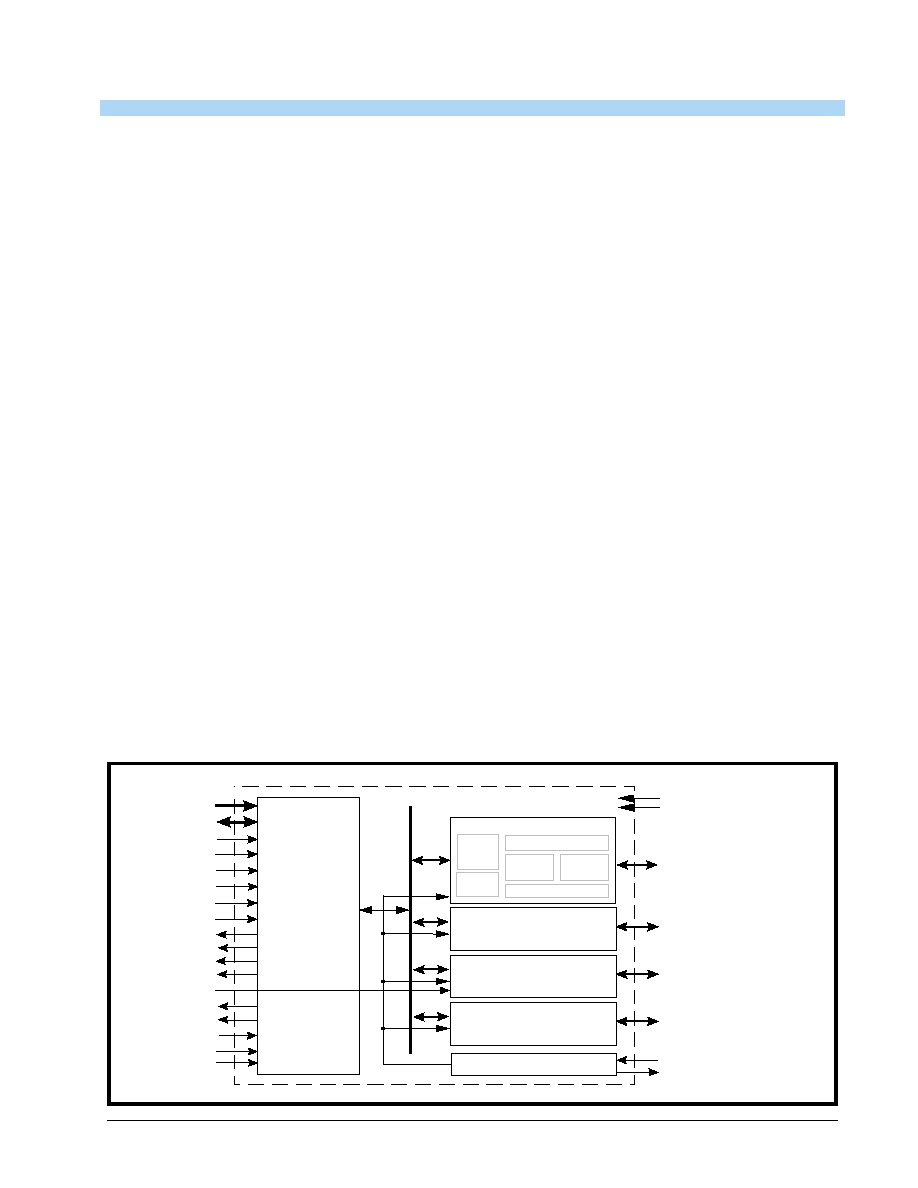
Exar
Corporation 48720 Kato Road, Fremont CA, 94538
�
(510) 668-7000
�
FAX (510) 668-7017
�
www.exar.com
��
��
��
��
XR16C854/854D
2.97V TO 5.5V QUAD UART WITH 128-BYTE FIFO
JANUARY 2004
REV. 3.0
GENERAL DESCRIPTION
The XR16C854/854D
1
(854) is an enhanced quad
Universal Asynchronous Receiver and Transmitter
(UART) each with 128 bytes of transmit and receive
FIFOs, transmit and receive FIFO counters and
trigger levels, automatic hardware and software flow
control, and data rates of up to 2 Mbps. Each UART
has a set of registers that provide the user with
operating status and control, receiver error
indications, and modem serial interface controls.
System interrupts may be tailored to meet design
requirements. An internal loopback capability allows
onboard diagnostics. The 854 is available in 64-pin
TQFP, 68-pin PLCC and 100-pin QFP packages.
The 64-pin package only offers the 16 mode
interface, but the 68 and 100 pin packages offer an
additional 68 mode interface which allows easy
integration with Motorola processors. The
XR16C854CV (64 pin) offers three state interrupt
outputs while the XR16C854DV provides continuous
interrupt outputs. The 100 pin package provides
additional FIFO status outputs (TXRDY# and
RXRDY# A-D), separate infrared transmit data
outputs (IRTX A-D) and channel C external clock
input (CHCCLK). The XR16C854/854D is compatible
with the industry standard ST16C554/554D and
ST16C654/654D.
N
OTE
:
1 Covered by U.S. Patent #5,649,122 and #5,949,787.
FEATURES
Added feature in devices with top mark date code of
"F2 YYWW" and newer:
s
5 volt tolerant inputs
�
2.97 to 5.5 Volt Operation
�
Pin-to-pin compatible with the industry standard
ST16C554 and ST16C654 and TI's TL16C554N
and TL16C754BFN
�
Intel or Motorola Data Bus Interface select
�
Four independent UART channels
s
Register Set Compatible to 16C550
s
Data rates of up to 2 Mbps
s
Transmit and Receive FIFOs of 128 bytes
s
Programmable TX and RX FIFO Trigger Levels
s
Transmit and Receive FIFO Level Counters
s
Automatic Hardware (RTS/CTS) Flow Control
s
Selectable Auto RTS Flow Control Hysteresis
s
Automatic Software (Xon/Xoff) Flow Control
s
Wireless Infrared (IrDA 1.0) Encoder/Decoder
�
Sleep Mode (200 uA typical)
�
Crystal oscillator or external clock input
APPLICATIONS
�
Portable Appliances
�
Telecommunication Network Routers
�
Ethernet Network Routers
�
Cellular Data Devices
�
Factory Automation and Process Controls
F
IGURE
1. XR16C854 B
LOCK
D
IAGRAM
XTAL1
XTAL2
Crystal Osc/Buffer
Data Bus
Interface
UART Channel A
128 Byte TX FIFO
128 Byte RX FIFO
BRG
IR
ENDEC
TX & RX
UART
Regs
2.97V to 5.5V V CC
GND
854 BLK
TXB, RXB, IRTXB , DTRB#,
D SR B#, R TS B#, C TSB #,
C DB #, R IB#, OP2 B#
UART Channel B
(sam e as Channel A )
A2:A0
D7:D0
CSA#
16/68#
CSB#
INTA
INTB
IOW #
IOR#
Reset
INTSEL
CHCCLK
TXRDY# A-D
R XR DY # A-D
UART Channel C
(sam e as Channel A )
TXA, RXA, IRTXA , DTRA#,
D SR A#, R TS A#, C TSA #,
C DA #, R IA#, OP2 A#
TXC , RX C, IR TXC , D TRC #,
D SR C#, RTSC#, C TS C#,
C DC #, R IC#, OP 2C#
UART Channel D
(sam e as Channel A )
TXD, RX D, IRTXD, DTRD#,
DSRD#, RTSD#, CTSD#,
CDD#, RID#, OP 2D#
CSC#
CSD#
INTC
INTD

XR16C854/854D
��
��
��
��
2.97V TO 5.5V QUAD UART WITH 128-BYTE FIFO
REV. 3.0
2
F
IGURE
2. P
IN
O
UT
A
SSIGNMENT
F
OR
100-
PIN
QFP P
ACKAGES
I
N
16
AND
68 M
ODE
XR16C854
100-pin QFP
16 Mode
Connect 16/68# pin to VCC
1
2
3
4
5
6
7
8
9
10
11
12
13
14
15
16
17
18
19
20
21
22
23
24
25
26
27
28
29
30
31
32
33
34
35
36
37
38
39
40
41
42
43
44
45
46
47
48
49
50
100
99
98
97
96
95
94
93
92
91
90
89
88
87
86
85
84
83
82
81
80
79
78
77
76
75
74
73
72
71
70
69
68
67
66
65
64
63
62
61
60
59
58
57
56
55
54
53
52
51
N.
C.
N.
C.
N.
C.
N.
C.
T
X
RDYA
#
IR
TXA
DSRA
#
CTSA
#
DT
R
A
#
VCC
RTSA
#
IN
TA
CSA
#
TXA
IO
W
#
TXB
CSB
#
IN
TB
RTSB
#
GN
D
DT
R
B
#
CTSB
#
DSRB
#
IR
TXB
T
X
RDYB
#
N.
C.
N.
C.
N.
C.
N.
C.
N.
C.
RXRDYB#
CDB#
RIB#
RXB
CLKSEL
16/68#
A2
A1
A0
XTAL1
XTAL2
CHCCLK
RESET
RXRDY#
TXRDY#
GND
RXC
RIC#
CDC#
RXRDYC#
N.
C.
N.
C.
N.
C.
N.
C.
FSR
S
#
IR
TXD
DSRD#
CTSD#
DT
R
D
#
GN
D
RTSD#
IN
TD
CSD#
TXD
IO
R
#
TXC
CSC#
IN
TC
RTSC#
VCC
DT
R
C
#
CTSC#
DSRC#
IR
TXC
T
X
RDYC#
N.
C.
N.
C.
N.
C.
N.
C.
N.
C.
RXRDYA#
CDA#
RIA#
RXA
GND
D7
D6
D5
D4
D3
D2
D1
D0
INTSEL
VCC
RXD
RID#
CDD#
RXRDYD#
TXRDYD#
XR16C854
100-pin QFP
68 Mode
Connect 16/68# pin to GND
1
2
3
4
5
6
7
8
9
10
11
12
13
14
15
16
17
18
19
20
21
22
23
24
25
26
27
28
29
30
31
32
33
34
35
36
37
38
39
40
41
42
43
44
45
46
47
48
49
50
100
99
98
97
96
95
94
93
92
91
90
89
88
87
86
85
84
83
82
81
80
79
78
77
76
75
74
73
72
71
70
69
68
67
66
65
64
63
62
61
60
59
58
57
56
55
54
53
52
51
N.
C.
N.
C.
N.
C.
N.
C.
T
X
RDY
A
#
IR
T
X
A
DS
R
A
#
CT
S
A
#
DT
RA
#
VC
C
RT
S
A
#
IR
Q
#
CS
#
TX
A
R/
W#
TX
B
A3
N.
C.
RT
S
B
#
GN
D
DT
RB
#
CT
S
B
#
DS
R
B
#
IR
T
X
B
T
X
RDY
B
#
N.
C.
N.
C.
N.
C.
N.
C.
N.
C.
RXRDYB#
CDB#
RIB#
RXB
CLKSEL
16/68#
A2
A1
A0
XTAL1
XTAL2
CHCCLK
RESET#
RXRDY#
TXRDY#
GND
RXC
RIC#
CDC#
RXRDYC#
N.
C.
N.
C.
N.
C.
N.
C.
FS
R
S
#
IR
T
X
D
DS
R
D
#
CT
S
D
#
DT
RD
#
GN
D
RT
S
D
#
N.
C.
N.
C.
TX
D
N.
C.
TX
C
A4
N.
C.
RT
S
C
#
VC
C
DT
RC
#
CT
S
C
#
DS
R
C
#
IR
T
X
C
T
X
RDY
C
#
N.
C.
N.
C.
N.
C.
N.
C.
N.
C.
RXRDYA#
CDA#
RIA#
RXA
GND
D7
D6
D5
D4
D3
D2
D1
D0
GND
VCC
RXD
RID#
CDD#
RXRDYD#
TXRDYD#

��
��
��
��
XR16C854/854D
REV. 3.0
2.97V TO 5.5V QUAD UART WITH 128-BYTE FIFO
3
F
IGURE
3. P
IN
O
UT
A
SSIGNMENT
F
OR
PLCC P
ACKAGES
I
N
16
AND
68 M
ODE
AND
TQFP P
ACKAGES
ORDERING INFORMATION
P
ART
N
UMBER
P
ACKAGE
O
PERATING
T
EMPERATURE
R
ANGE
D
EVICE
S
TATUS
XR16C854CJ
68-Lead PLCC
0�C to +70�C
Active
XR16C854IJ
68-Lead PLCC
-40�C to +85�C
Active
XR16C854CV
64-Lead TQFP
0�C to +70�C
Active
XR16C854IV
64-Lead TQFP
-40�C to +85�C
Active
XR16C854DCV
64-Lead TQFP
0�C to +70�C
Active
XR16C854DIV
64-Lead TQFP
-40�C to +85�C
Active
XR16C854CQ
100-Lead QFP
0�C to +70�C
Active
XR16C854IQ
100-Lead QFP
-40�C to +85�C
Active
1
2
3
4
5
6
7
8
9
10
11
12
13
14
15
16
17
18
19
20
21
22
23
24
25
26
27
28
29
30
31
32
48
47
46
45
44
43
42
41
40
39
38
37
36
35
34
33
64
63
62
61
60
59
58
57
56
55
54
53
52
51
50
49
DSRA#
CTSA#
DTRA#
VCC
RTSA#
INTA
CSA#
TXA
IOW#
TXB
CSB#
INTB
RTSB#
GND
DTRB#
CTSB#
DSRB#
CDB#
RI
B#
RXB
CLKSE
L
A2
A1
A0
XTAL
1
XTAL
2
RESET
GND
RXC
RI
C#
CDC#
DSRC#
DSRD#
CTSD#
DTRD#
GND
RTSD#
INTD
CSD#
TXD
IOR#
TX
C
CSC#
INTC
RTSC#
VCC
DTRC#
CTSC#
CDA#
RI
A#
RXA
GND
D7
D6
D5
D4
D3
D2
D1
D0
VCC
RXD
RI
D#
CDD#
XR16C854
XR16C854D
64-pin TQFP
16 Mode Only
9
8
7
6
5
4
3
2
1
68
67
66
65
64
63
62
63
10
11
12
13
14
15
16
17
18
19
20
21
22
23
24
25
26
60
59
58
57
56
55
54
53
52
51
50
49
48
47
46
45
44
27
28
29
30
31
32
33
34
35
36
37
38
39
40
41
42
43
DSRA#
CTSA#
DTRA#
VCC
RTSA#
INTA
CSA#
TXA
IOW#
TXB
CSB#
INTB
RTSB#
GND
DTRB#
CTSB#
DSRB#
CD
B#
RI
B#
RX
B
C
L
KS
EL
16/
68#
A2
A1
A0
XT
AL
1
XT
AL
2
RE
SE
T
RX
RDY
#
TX
R
D
Y#
GN
D
RX
C
RI
C#
CD
C#
DSRD#
CTSD#
DTRD#
GND
RTSD#
INTD
CSD#
TXD
IOR#
TXC
CSC#
INTC
RTSC#
VCC
DTRC#
CTSC#
DSRC#
CD
A#
RI
A#
RX
A
GN
D
D7
D6
D5
D4
D3
D2
D1
D0
IN
T
S
E
L
VC
C
RX
D
RI
D#
CD
D#
XR16C854
68-pin PLCC
16 Mode
(16/68# pin connected to VCC)
9
8
7
6
5
4
3
2
1
68
67
66
65
64
63
62
61
10
11
12
13
14
15
16
17
18
19
20
21
22
23
24
25
26
60
59
58
57
56
55
54
53
52
51
50
49
48
47
46
45
44
27
28
29
30
31
32
33
34
35
36
37
38
39
40
41
42
43
DSRA#
CTSA#
DTRA#
VCC
RTSA#
IRQ#
CS#
TXA
R/W#
TXB
A3
N.C.
RTSB#
GND
DTRB#
CTSB#
DSRB#
CDB#
RI
B#
RXB
CL
KSEL
16/
68#
A2
A1
A0
XTAL
1
XTAL
2
RESET#
RXRDY#
T
X
RDY#
GND
RXC
RI
C#
CDC#
DSRD#
CTSD#
DTRD#
GND
RTSD#
N.C.
N.C.
TXD
N.C.
TXC
A4
N.C.
RTSC#
VCC
DTRC#
CTSC#
DSRC#
CDA#
RI
A#
RXA
GND
D7
D6
D5
D4
D3
D2
D1
D0
GND
VCC
RXD
RI
D#
CDD#
XR16C854
68-pin PLCC
68 Mode
(16/68# pin connected to GND)

XR16C854/854D
��
��
��
��
2.97V TO 5.5V QUAD UART WITH 128-BYTE FIFO
REV. 3.0
4
PIN DESCRIPTIONS
Pin Description
N
AME
64-TQFP
P
IN
#
68-PLCC
P
IN
#
100-QFP
P
IN
#
T
YPE
D
ESCRIPTION
DATA BUS INTERFACE
A2
A1
A0
22
23
24
32
33
34
37
38
39
I
Address data lines [2:0]. These 3 address lines select one of the
internal registers in UART channel A-D during a data bus transac-
tion.
D7
D6
D5
D4
D3
D2
D1
D0
60
59
58
57
56
55
54
53
5
4
3
2
1
68
67
66
95
94
93
92
91
90
89
88
I/O
Data bus lines [7:0] (bidirectional).
IOR#
(N.C.)
40
52
66
I
When 16/68# pin is at logic 1, the Intel bus interface is selected
and this input becomes read strobe (active low). The falling edge
instigates an internal read cycle and retrieves the data byte from
an internal register pointed by the address lines [A2:A0], puts the
data byte on the data bus to allow the host processor to read it on
the rising edge.
When 16/68# pin is at logic 0, the Motorola bus interface is
selected and this input is not used.
IOW#
(R/W#)
9
18
15
I
When 16/68# pin is at logic 1, it selects Intel bus interface and this
input becomes write strobe (active low). The falling edge instigates
the internal write cycle and the rising edge transfers the data byte
on the data bus to an internal register pointed by the address lines.
When 16/68# pin is at logic 0, the Motorola bus interface is
selected and this input becomes read (logic 1) and write (logic 0)
signal. Motorola bus interface is not available on the 64 pin pack-
age.
CSA#
(CS#)
7
16
13
I
When 16/68# pin is at logic 1, this input is chip select A (active low)
to enable channel A in the device.
When 16/68# pin is at logic 0, this input becomes the chip select
(active low) for the Motorola bus interface.
Motorola bus interface is not available on the 64 pin package.
CSB#
(A3)
11
20
17
I
When 16/68# pin is at logic 1, this input is chip select B (active low)
to enable channel B in the device.
When 16/68# pin is at logic 0, this input becomes address line A3
which is used for channel selection in the Motorola bus interface.
Motorola bus interface is not available on the 64 pin package.
CSC#
(A4)
38
50
64
I
When 16/68# pin is at logic 1, this input is chip select C (active low)
to enable channel C in the device.
When 16/68# pin is at logic 0, this input becomes address line A4
which is used for channel selection in the Motorola bus interface.
Motorola bus interface is not available on the 64 pin package.
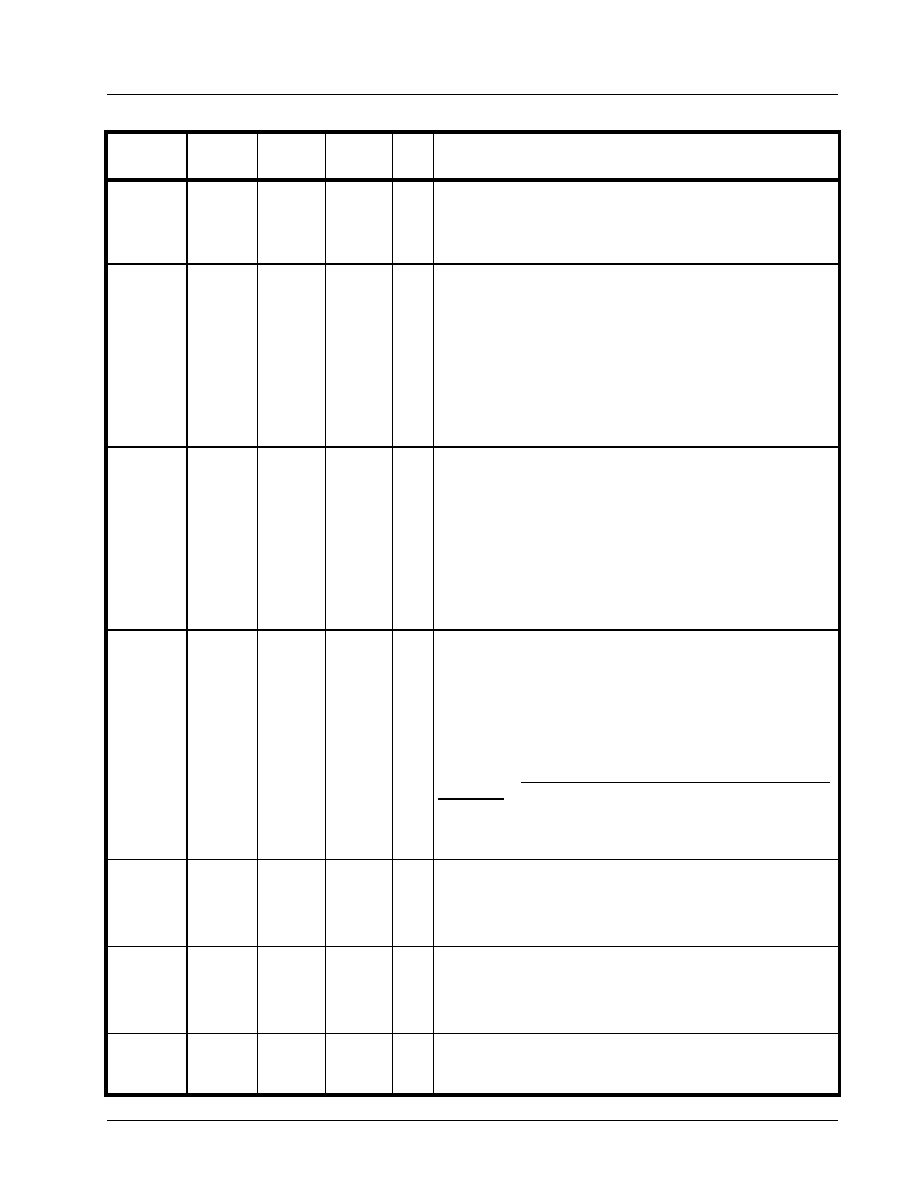
��
��
��
��
XR16C854/854D
REV. 3.0
2.97V TO 5.5V QUAD UART WITH 128-BYTE FIFO
5
CSD#
(N.C.)
42
54
68
I
When 16/68# pin is at logic 1, this input is chip select D (active low)
to enable channel D in the device.
When 16/68# pin is at logic 0, this input is not used.
Motorola bus interface is not available on the 64 pin package.
INTA
(IRQ#)
6
15
12
O
(OD)
When 16/68# pin is at logic 1 for Intel bus interface, this ouput
becomes channel A interrupt output. The output state is defined
by the user and through the software setting of MCR[3]. INTA is set
to the active mode when MCR[3] is set to a logic 1. INTA is set to
the three state mode when MCR[3] is set to a logic 0 (default). See
MCR[3].
When 16/68# pin is at logic 0 for Motorola bus interface, this output
becomes device interrupt output (active low, open drain). An exter-
nal pull-up resistor is required for proper operation.
Motorola bus interface is not available on the 64 pin package.
INTB
INTC
INTD
(N.C.)
12
37
43
21
49
55
18
63
69
O
When 16/68# pin is at logic 1 for Intel bus interface, these ouputs
become the interrupt outputs for channels B, C, and D. The output
state is defined by the user through the software setting of MCR[3].
The interrupt outputs are set to the active mode when MCR[3] is
set to a logic 1 and are set to the three state mode when MCR[3] is
set to a logic 0 (default). See MCR[3].
When 16/68# pin is at logic 0 for Motorola bus interface, these out-
puts are unused and will stay at logic zero level. Leave these out-
puts unconnected.
Motorola bus interface is not available on the 64 pin package.
INTSEL
-
65
87
I
Interrupt Select (active high, input with internal pull-down).
When 16/68# pin is at logic 1 for Intel bus interface, this pin can be
used in conjunction with MCR bit-3 to enable or disable the INT A-
D pins or override MCR bit-3 and enable the interrupt outputs.
Interrupt outputs are enabled continuously by making this pin a
logic 1. Making this pin a logic 0 allows MCR bit-3 to enable and
disable the interrupt output pins. In this mode, MCR bit-3 is set to a
logic 1 to enable the continuous output. See MCR bit-3 description
for full detail. This pin must be at logic 0 in the Motorola bus inter-
face mode. Due to pin limitations on 64 pin packages, this pin is
not available. To cover this limitation, two 64 pin TQFP packages
versions are offered. The XR16C854D operates in the continuous
interrupt enable mode by bonding this pin to VCC internally.
TXRDYA#
TXRDYB#
TXRDYC#
TXRDYD#
-
-
-
-
-
-
-
-
5
25
56
81
O
UART channels A-D Transmitter Ready (active low). The outputs
provide the TX FIFO/THR status for transmit channels A-D. See
Table 5 on page 13
. If these outputs are unused, leave them
unconnected.
RXRDYA#
RXRDYB#
RXRDYC#
RXRDYD#
-
-
-
-
-
-
-
-
100
31
50
82
O
UART channels A-D Receiver Ready (active low). This output pro-
vides the RX FIFO/RHR status for receive channels A-D. See
Table 5 on page 13
. If these outputs are unused, leave them
unconnected.
TXRDY#
-
39
45
O
Transmitter Ready (active low). This output is a logically wire-
ORed status of TXRDY# A-D. See
Table 5 on page 13
. If this out-
put is unused, leave it unconnected.
Pin Description
N
AME
64-TQFP
P
IN
#
68-PLCC
P
IN
#
100-QFP
P
IN
#
T
YPE
D
ESCRIPTION
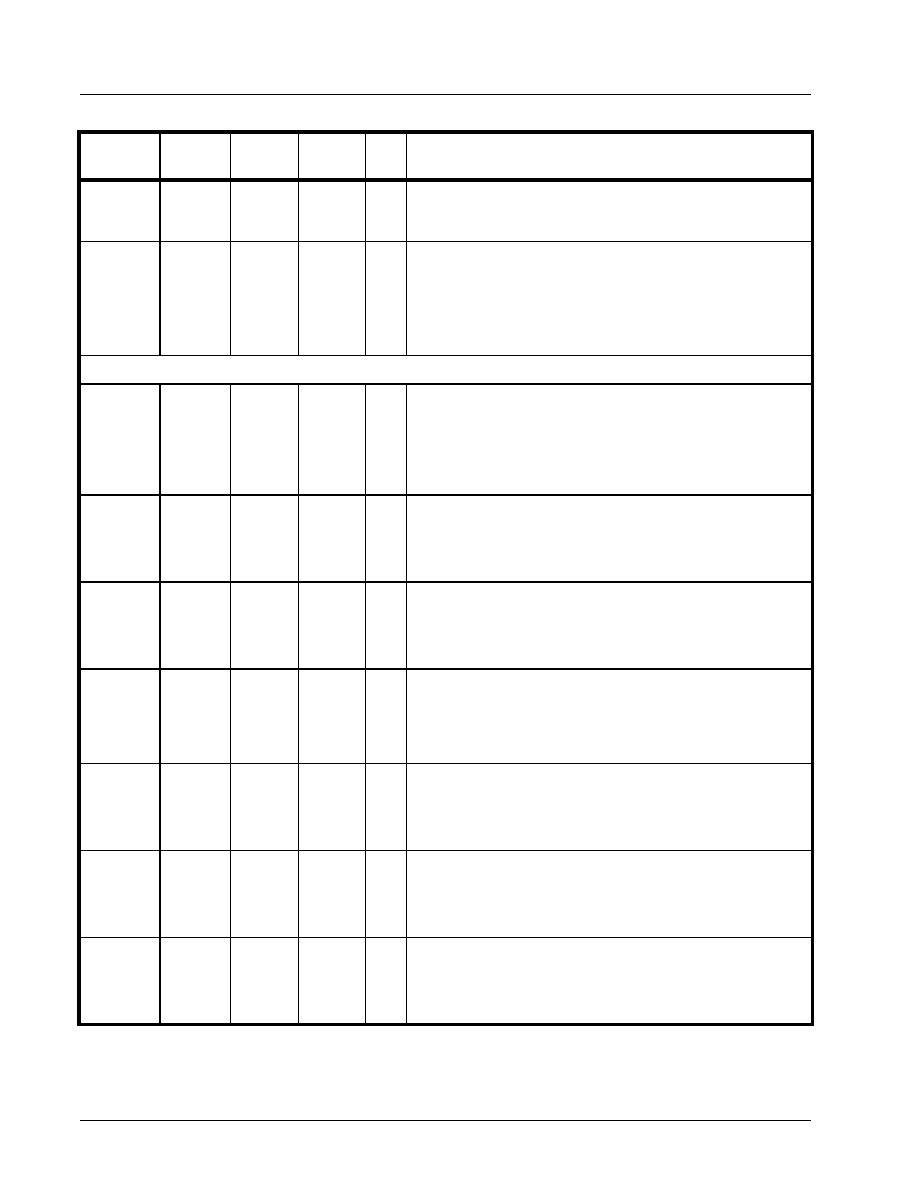
XR16C854/854D
��
��
��
��
2.97V TO 5.5V QUAD UART WITH 128-BYTE FIFO
REV. 3.0
6
RXRDY#
-
38
44
O
Receiver Ready (active low). This output is a logically wire-ORed
status of RXRDY# A-D. See
Table 5 on page 13
. If this output is
unused, leave it unconnected.
FSRS#
-
-
76
I
FIFO Status Register Select (active low input with internal pull-up).
The content of the FSTAT register is placed on the data bus when
this pin becomes active. However it should be noted, D0-D3 con-
tain the inverted logic states of TXRDY# A-D pins, and D4-D7 the
logic states (un-inverted) of RXRDY# A-D pins. Address line is not
required when reading this status register.
MODEM OR SERIAL I/O INTERFACE
TXA
TXB
TXC
TXD
8
10
39
41
17
19
51
53
14
16
65
67
O
UART channels A-D Transmit Data and infrared transmit data.
Standard transmit and receive interface is enabled when MCR[6] =
0. In this mode, the TX signal will be a logic 1 during reset, or idle
(no data). Infrared IrDA transmit and receive interface is enabled
when MCR[6] = 1. In the Infrared mode, the inactive state (no
data) for the Infrared encoder/decoder interface is a logic 0.
IRTXA
IRTXB
IRTXC
IRTXD
-
-
-
-
-
-
-
-
6
24
57
75
O
UART channel A-D Infrared Transmit Data. The inactive state (no
data) for the Infrared encoder/decoder interface is a logic 0.
Regardless of the logic state of MCR bit-6, this pin will be operating
in the Infrared mode.
RXA
RXB
RXC
RXD
62
20
29
51
7
29
41
63
97
34
47
85
I
UART channel A-D Receive Data or infrared receive data. Normal
receive data input must idle at logic 1 condition. The infrared
receiver pulses typically idles at logic 0 but can be inverted by soft-
ware control prior going in to the decoder, see FCTR[2].
RTSA#
RTSB#
RTSC#
RTSD#
5
13
36
44
14
22
48
56
11
19
62
70
O
UART channels A-D Request-to-Send (active low) or general pur-
pose output. This output must be asserted prior to using auto RTS
flow control, see EFR[6], MCR[1], FCTR[1:0], EMSR[5:4] and
IER[6]. Also see
Figure 11
. If these outputs are not used, leave
them unconnected.
CTSA#
CTSB#
CTSC#
CTSD#
2
16
33
47
11
25
45
59
8
22
59
73
I
UART channels A-D Clear-to-Send (active low) or general purpose
input. It can be used for auto CTS flow control, see EFR[7], and
IER[7]. Also see
Figure 11
. These inputs should be connected to
VCC when not used.
DTRA#
DTRB#
DTRC#
DTRD#
3
15
34
46
12
24
46
58
9
21
60
72
O
UART channels A-D Data-Terminal-Ready (active low) or general
purpose output. If these outputs are not used, leave them uncon-
nected.
DSRA#
DSRB#
DSRC#
DSRD#
1
17
32
48
10
26
44
60
7
23
58
74
I
UART channels A-D Data-Set-Ready (active low) or general pur-
pose input. This input should be connected to VCC when not used.
Pin Description
N
AME
64-TQFP
P
IN
#
68-PLCC
P
IN
#
100-QFP
P
IN
#
T
YPE
D
ESCRIPTION
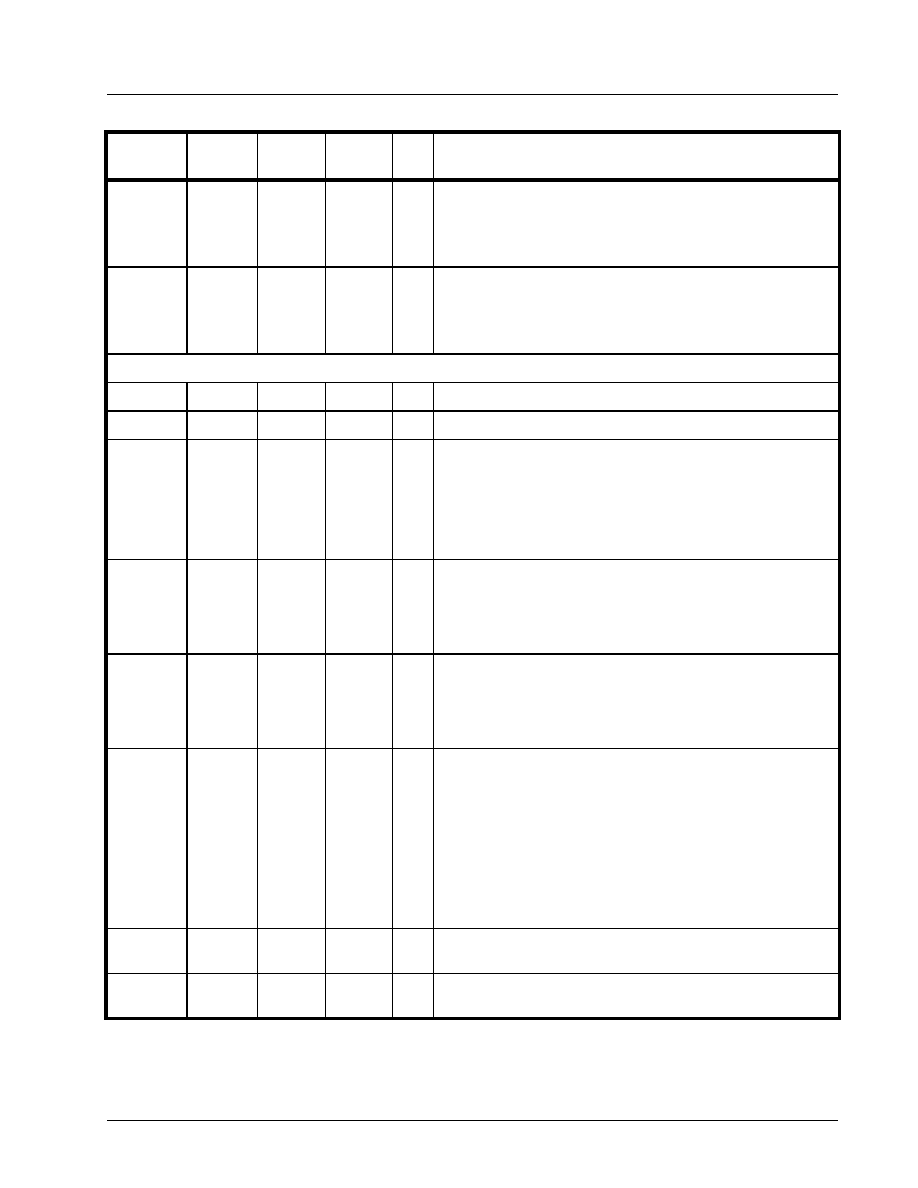
��
��
��
��
XR16C854/854D
REV. 3.0
2.97V TO 5.5V QUAD UART WITH 128-BYTE FIFO
7
CDA#
CDB#
CDC#
CDD#
64
18
31
49
9
27
43
61
99
32
49
83
I
UART channels A-D Carrier-Detect (active low) or general purpose
input. This input should be connected to VCC when not used.
RIA#
RIB#
RIC#
RID#
63
19
30
50
8
28
42
62
98
33
48
84
I
UART channels A-D Ring-Indicator (active low) or general purpose
input. This input should be connected to VCC when not used.
ANCILLARY SIGNALS
XTAL1
25
35
40
I
Crystal or external clock input. This input is not 5V tolerant.
XTAL2
26
36
41
O
Crystal or buffered clock output.
16/68#
-
31
36
Intel or Motorola Bus Select (input with internal pull-up).
When 16/68# pin is at logic 1, 16 or Intel Mode, the device will
operate in the Intel bus type of interface.
When 16/68# pin is at logic 0, 68 or Motorola mode, the device will
operate in the Motorola bus type of interface.
Motorola bus interface is not available on the 64 pin package.
CLKSEL
21
30
35
I
Baud-Rate-Generator Input Clock Prescaler Select for channels A-
D. This input is only sampled during power up or a reset. Connect
to VCC for divide by 1 and GND for divide by 4. MCR[7] can over-
ride the state of this pin following a reset or initialization. See MCR
bit-7 and
Figure 6
in the Baud Rate Generator section.
CHCCLK
-
-
42
I
This input provides the clock for UART channel C. An external 16X
baud clock or the crystal oscillator's output, XTAL2, must be con-
nected to this pin for normal operation. This input may also be
used with MIDI (Musical Instrument Digital Interface) applications
when an external MIDI clock is provided.
RESET
(RESET#)
27
37
43
I
When 16/68# pin is at logic 1 for Intel bus interface, this input
becomes the Reset pin (active high). In this case, a 40 ns mini-
mum logic 1 pulse on this pin will reset the internal registers and all
outputs. The UART transmitter output will be held at logic 1, the
receiver input will be ignored and outputs are reset during reset
period (
Table 18 on page 40
). When 16/68# pin is at a logic 0 for
Motorola bus interface, this input becomes Reset# pin (active low).
This pin functions similarly, but instead of a logic 1 pulse, a 40 ns
minimum logic 0 pulse will reset the internal registers and outputs.
Motorola bus interface is not available on the 64 pin package.
VCC
4, 35, 52
13, 47,
64
10, 61,
86
Pwr
2.97V to 5.5V power supply. All input pins, except XTAL1, are 5V
tolerant.
GND
14, 28,
45, 61
6, 23, 40,
57
20, 46,
71, 96
Pwr
Power supply common, ground.
Pin Description
N
AME
64-TQFP
P
IN
#
68-PLCC
P
IN
#
100-QFP
P
IN
#
T
YPE
D
ESCRIPTION

XR16C854/854D
��
��
��
��
2.97V TO 5.5V QUAD UART WITH 128-BYTE FIFO
REV. 3.0
8
Pin type: I=Input, O=Output, I/O= Input/output, OD=Output Open Drain.
Factory Test Mode
If the IOR#, IOW# and CS# pins are all asserted (at a logic 0), the 854 will enter a Factory Test Mode.
N.C.
-
-
1, 2, 3, 4,
26, 27,
28, 29,
30, 51,
52, 53,
54, 55,
77, 78,
79, 80
No Connection. These pins are not used in either the Intel or
Motorola bus modes.
Pin Description
N
AME
64-TQFP
P
IN
#
68-PLCC
P
IN
#
100-QFP
P
IN
#
T
YPE
D
ESCRIPTION

��
��
��
��
XR16C854/854D
REV. 3.0
2.97V TO 5.5V QUAD UART WITH 128-BYTE FIFO
9
1.0
PRODUCT DESCRIPTION
The XR16C854 (854) integrates the functions of 4 enhanced 16C550 Universal Asynchronous Receiver and
Transmitter (UART). Each UART is independently controlled having its own set of device configuration
registers. The configuration registers set is 16550 UART compatible for control, status and data transfer.
Additionally, each UART channel has 128-bytes of transmit and receive FIFOs, automatic RTS/CTS hardware
flow control with hysteresis control, automatic Xon/Xoff and special character software flow control,
programmable transmit and receive FIFO trigger levels, FIFO level counters, infrared encoder and decoder
(IrDA ver 1.0), programmable baud rate generator with a prescaler of divide by 1 or 4, and data rate up to 2
Mbps. The XR16C854 can operate at 3.3 or 5 volts. The 854 is fabricated with an advanced CMOS process.
Enhanced FIFO
The 854 QUART provides a solution that supports 128 bytes of transmit and receive FIFO memory, instead of
64 bytes provided in the ST16C654 and 16 bytes in the ST16C554, or one byte in the ST16C454. The 854 is
designed to work with high performance data communication systems, that require fast data processing time.
Increased performance is realized in the 854 by the larger transmit and receive FIFOs, FIFO trigger level
control, FIFO level counters and automatic flow control mechanism. This allows the external processor to
handle more networking tasks within a given time. For example, the ST16C554 with a 16 byte FIFO, unloads
16 bytes of receive data in 1.53 ms (This example uses a character length of 11 bits, including start/stop bits at
115.2Kbps). This means the external CPU will have to service the receive FIFO at 1.53 ms intervals. However
with the 128 byte FIFO in the 854, the data buffer will not require unloading/loading for 12.2 ms. This increases
the service interval giving the external CPU additional time for other applications and reducing the overall
UART interrupt servicing time. In addition, the programmable FIFO level trigger interrupt and automatic
hardware/software flow control is uniquely provided for maximum data throughput performance especially
when operating in a multi-channel system. The combination of the above greatly reduces the CPU's bandwidth
requirement, increases performance, and reduces power consumption.
Data Rate
The 854 is capable of operation up to 2 Mbps at 5V with 16x internal sampling clock rate. The device can
operate with a crystal oscillator of up to 24 MHz crystal on pins XTAL1 and XTAL2, or external clock source of
32 MHz on XTAL1 pin. With a typical crystal of 14.74128 MHz and through a software option, the user can set
the prescaler bit for data rates of up to 921.6 kbps.
Enhanced Features
The rich feature set of the 854 is available through the internal registers. Automatic hardware/software flow
control, selectable transmit and receive FIFO trigger levels, selectable baud rates, infrared encoder/decoder
interface, modem interface controls, and a sleep mode are all standard features. MCR bit-5 provides a facility
for turning off software flow control with any incoming (RX) character. In the 16 mode INTSEL and MCR bit-3
can be configured to provide a software controlled or continuous interrupt capability. Due to pin limitations for
the 64 pin package of the 854, this feature is offered in two different TQFP packages. The XR16C854DCV
operates in the continuous interrupt enable mode by internally bonding INTSEL to VCC. The XR16C854CV
operates in conjunction with MCR bit-3 by internally bonding INTSEL to GND.
The 68 and 100 pin XR16C854 packages offer a clock prescaler select pin to allow system/board designers to
preset the default baud rate table on power up. The CLKSEL pin selects the div-by-1 or div-by-4 prescaler for
the baud rate generator. It can then be overridden following initializatioin by MCR bit-7.
The 100 pin package offer several other enhanced features. These features include a CHCCLK clock input,
FSTAT register and separate IrDA TX outputs. The CHCCLK must be connected to the XTAL2 pin for normal
operation or to external MIDI (Music Instrument Digital Interface) oscillator for MIDI applications. A separate
register (FSTAT) is provided for monitoring the real time status of the FIFO signals TXRDY# and RXRDY# for
each of the four UART channels (A-D). This reduces polling time involved in accessing individual channels.
The 100 pin QFP package also offers four separate IrDA (Infrared Data Association Standard) TX outputs for
Infrared applications. These outputs are provided in addition to the standard asynchronous modem data
outputs.
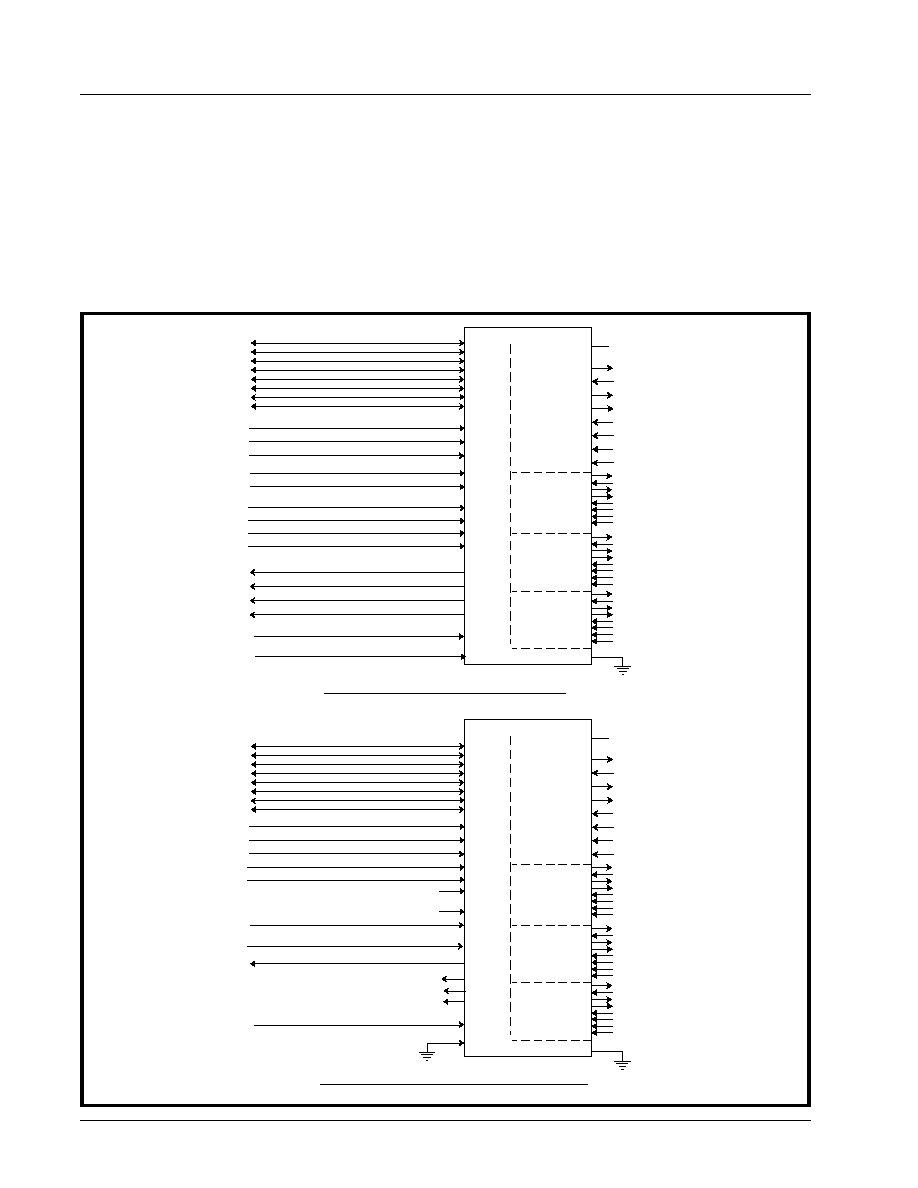
XR16C854/854D
��
��
��
��
2.97V TO 5.5V QUAD UART WITH 128-BYTE FIFO
REV. 3.0
10
2.0
FUNCTIONAL DESCRIPTIONS
2.1
CPU Interface
The CPU interface is 8 data bits wide with 3 address lines and control signals to execute data bus read and
write transactions. The 854 data interface supports the Intel compatible types of CPUs and it is compatible to
the industry standard 16C550 UART. No clock (oscillator nor external clock) is required to operate a data bus
transaction. Each bus cycle is asynchronous using CS# A-D, IOR# and IOW# or CS#, R/W#, A4 and A3 inputs.
All four UART channels share the same data bus for host operations. A typical data bus interconnection for Intel
and Motorola mode is shown in
Figure 4
.
F
IGURE
4. XR16C854/854D T
YPICAL
I
NTEL
/M
OTOROLA
D
ATA
B
US
I
NTERCONNECTIONS
VCC
VCC
DSRA#
CTSA#
RTSA#
DTRA#
RXA
TXA
RIA#
CDA#
GND
A0
A1
A2
UART_CSA#
UART_CSB#
IOR#
IOW#
D0
D1
D2
D3
D4
D5
D6
D7
A0
A1
A2
CSA#
CSB#
D0
D1
D2
D3
D4
D5
D6
D7
IOR#
IOW#
UART
Channel A
UART
Channel B
UART_INTB
UART_INTA
INTB
INTA
UART_RESET
RESET
Serial Interface of
RS-232
Serial Interface of
RS-232
Intel Data Bus (16 Mode) Interconnections
UART
Channel C
UART
Channel D
Similar
to Ch A
Similar
to Ch A
Similar
to Ch A
UART_INTD
UART_INTC
INTD
INTC
UART_CSC#
UART_CSD#
CSC#
CSD#
VCC
16/68#
VCC
VCC
GND
A0
A1
A2
UART_CS#
A3
R/W#
D0
D1
D2
D3
D4
D5
D6
D7
A0
A1
A2
CSA#
CSB#
D0
D1
D2
D3
D4
D5
D6
D7
IOR#
IOW#
UART_IRQ#
INTB
INTA
RESET#
Serial Interface of
RS-232
Serial Interface of
RS-232
Motorola Data Bus (68 Mode) Interconnections
VCC
UART_RESET#
(no connect)
DSRA#
CTSA#
RTSA#
DTRA#
RXA
TXA
RIA#
CDA#
UART
Channel A
UART
Channel B
UART
Channel C
Similar
to Ch A
Similar
to Ch A
Similar
to Ch A
INTC
(no connect)
INTD
(no connect)
A4
CSC#
CSD#
VCC
16/68#
UART
Channel D
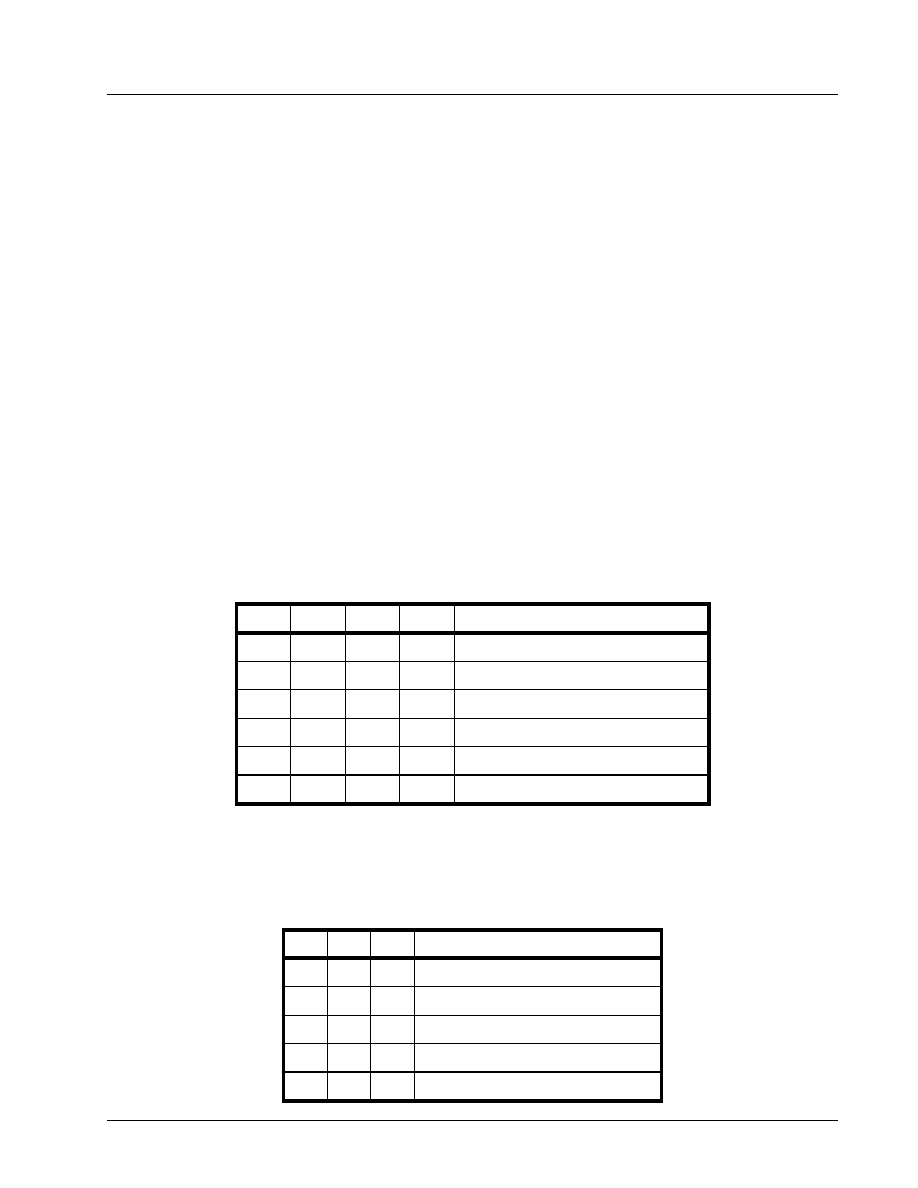
��
��
��
��
XR16C854/854D
REV. 3.0
2.97V TO 5.5V QUAD UART WITH 128-BYTE FIFO
11
2.2
5-Volt Tolerant Inputs
For devices that have top mark date code "F2 YYWW" and newer, the 854 can accept a voltage of up to 5.5V
on any of its inputs (except XTAL1) when operating from 2.97V to 5.5V. XTAL1 is not 5 volt tolerant. Devices
that have top mark date code "DC YYWW" and older do not have 5V tolerant inputs.
2.3
Device Reset
The RESET input resets the internal registers and the serial interface outputs in all four channels to their
default state (see
Table 18 on page 40
). An active high pulse of longer than 40 ns duration will be required to
activate the reset function in the device. Following a power-on reset or an external reset, the 854 is software
compatible with previous generation of UARTs, 16C454 and 16C554 and 16C654.
2.4
Device Identification and Revision
The XR16C854 provides a Device Identification code and a Device Revision code to distinguish the part from
other devices and revisions. To read the identification code from the part, it is required to set the baud rate
generator registers DLL and DLM both to 0x00. Now reading the content of the DLM will provide 0x14 for the
XR16C854 and reading the content of DLL will provide the revision of the part; for example, a reading of 0x01
means revision A.
2.5
Channel Selection
The UART provides the user with the capability to bi-directionally transfer information between an external
CPU and an external serial communication device. During Intel Bus Mode (16/68# pin is connected to VCC), a
logic 0 on chip select pins, CSA#, CSB#, CSC# or CSD# allows the user to select UART channel A, B, C or D
to configure, send transmit data and/or unload receive data to/from the UART. Selecting all four UARTs can be
useful during power up initialization to write to the same internal registers, but do not attempt to read from all
four uarts simultaneously. Individual channel select functions are shown in
Table 1
below.
During Motorola Bus Mode (16/68# pin is connected to GND), the package interface pins are configured for
connection with Motorola, and other popular microprocessor bus types. In this mode the 854 decodes two
additional addresses, A3 and A4, to select one of the four UART ports. The A3 and A4 address decode
function is used only when in the Motorola Bus Mode.
See Table 2
below.
T
ABLE
1: C
HANNEL
A-D S
ELECT
IN
16 M
ODE
CSA#
CSB#
CSC#
CSD#
F
UNCTION
1
1
1
1
UART de-selected
0
1
1
1
Channel A selected
1
0
1
1
Channel B selected
1
1
0
1
Channel C selected
1
1
1
0
Channel D selected
0
0
0
0
Channels A-D selected
T
ABLE
2: C
HANNEL
A-D S
ELECT
IN
68 M
ODE
CS#
A4
A3
F
UNCTION
1
N/A
N/A
UART de-selected
0
0
0
Channel A selected
0
0
1
Channel B selected
0
1
0
Channel C selected
0
1
1
Channel D selected
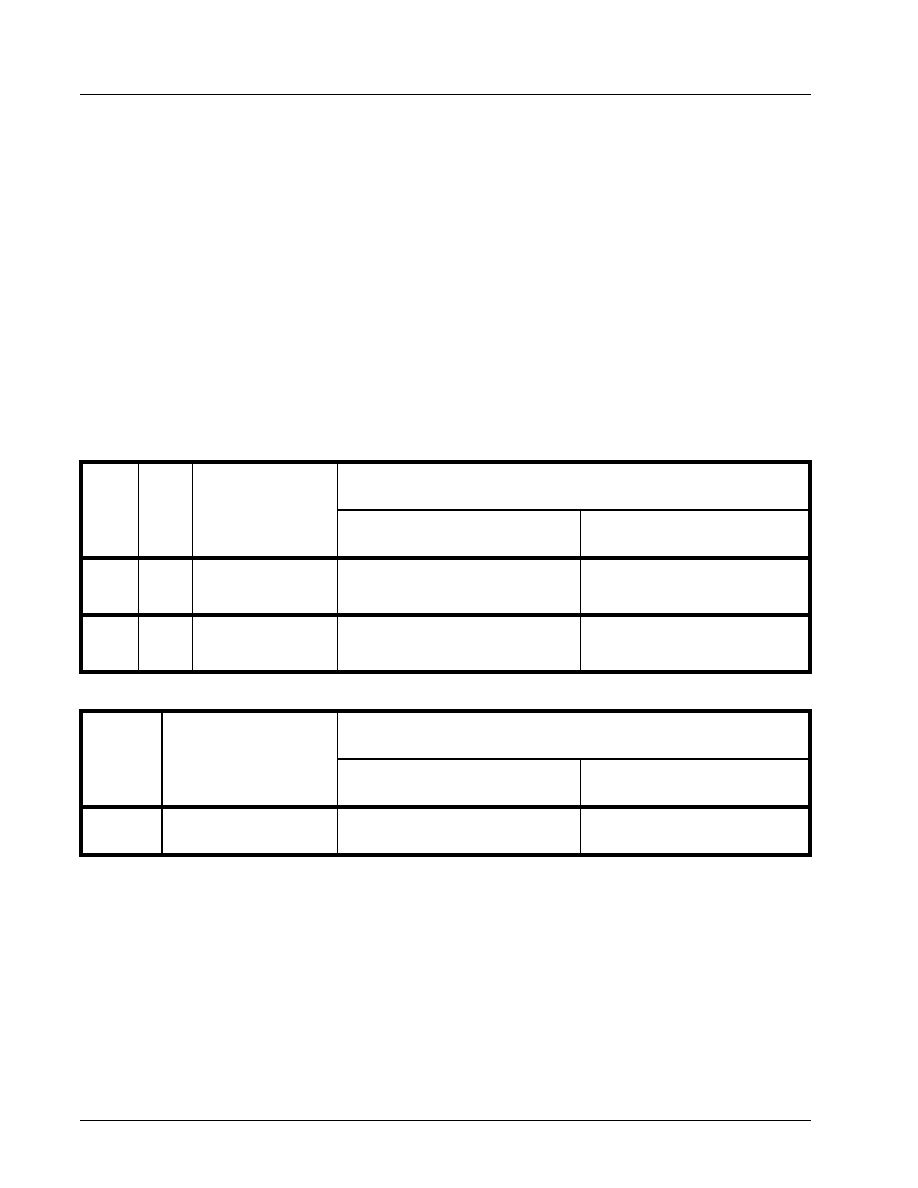
XR16C854/854D
��
��
��
��
2.97V TO 5.5V QUAD UART WITH 128-BYTE FIFO
REV. 3.0
12
2.6
Channels A-D Internal Registers
Each UART channel in the 854 has a set of enhanced registers for control, monitoring and data loading and
unloading. The configuration register set is compatible to those already available in the standard single
16C550. These registers function as data holding registers (THR/RHR), interrupt status and control registers
(ISR/IER), a FIFO control register (FCR), receive line status and control registers (LSR/LCR), modem status
and control registers (MSR/MCR), programmable data rate (clock) divisor registers (DLL/DLM), and a user
accessible scratchpad register (SPR).
Beyond the general 16C550 features and capabilities, the 854 offers enhanced feature registers (EMSR, FLVL,
EFR, Xon/Xoff 1, Xon/Xoff 2, FCTR, TRG, FC) that provide automatic RTS and CTS hardware flow control,
Xon/Xoff software flow control, automatic RS-485 half-duplex direction output enable/disable, FIFO trigger level
control, and FIFO level counters. All the register functions are discussed in full detail later in
"Section 3.0,
UART INTERNAL REGISTERS" on page 23
.
2.7
INT Ouputs for Channels A-D
The interrupt outputs change according to the operating mode and enhanced features setup.
Table 3
and 4
summarize the operating behavior for the transmitter and receiver. Also see
Figure 20
through
24
.
2.8
DMA Mode
The device does not support direct memory access. The DMA Mode (a legacy term) in this document doesn't
mean "direct memory access" but refers to data block transfer operation. The DMA mode affects the state of
the RXRDY# A-D and TXRDY# A-D output pins. The transmit and receive FIFO trigger levels provide additional
flexibility to the user for block mode operation. The LSR bits 5-6 provide an indication when the transmitter is
empty or has an empty location(s) for more data. The user can optionally operate the transmit and receive
FIFO in the DMA mode (FCR bit-3=1). When the transmit and receive FIFO are enabled and the DMA mode is
disabled (FCR bit-3 = 0), the 854 is placed in single-character mode for data transmit or receive operation.
When DMA mode is enabled (FCR bit-3 = 1), the user takes advantage of block mode operation by loading or
unloading the FIFO in a block sequence determined by the programmed trigger level. The following table show
their behavior. Also see
Figure 20
through
24
.
T
ABLE
3: INT P
INS
O
PERATION
FOR
T
RANSMITTER
FOR
C
HANNELS
A-D
FCTR
Bit-3
FCR B
IT
-0 = 0
(FIFO D
ISABLED
)
FCR B
IT
-0 = 1 (FIFO E
NABLED
)
FCR Bit-3 = 0
(DMA Mode Disabled)
FCR Bit-3 = 1
(DMA Mode Enabled)
INT Pin
0
0 = a byte in THR
1 = THR empty
0 = FIFO above trigger level
1 = FIFO below trigger level or FIFO
empty
0 = FIFO above trigger level
1 = FIFO below trigger level or FIFO
empty
INT Pin
1
0 = a byte in THR
1 = transmitter empty
0 = FIFO above trigger level
1 = FIFO below trigger level or
transmitter empty
0 = FIFO above trigger level
1 = FIFO below trigger level or
transmitter empty
T
ABLE
4: INT P
IN
O
PERATION
FOR
R
ECEIVER
FOR
C
HANNELS
A-D
FCR B
IT
-0 = 0
(FIFO D
ISABLED
)
FCR B
IT
-0 = 1 (FIFO E
NABLED
)
FCR Bit-3 = 0
(DMA Mode Disabled)
FCR Bit-3 = 1
(DMA Mode Enabled)
INT Pin
0 = no data
1 = 1 byte
0 = FIFO below trigger level
1 = FIFO above trigger level
0 = FIFO below trigger level
1 = FIFO above trigger level

��
��
��
��
XR16C854/854D
REV. 3.0
2.97V TO 5.5V QUAD UART WITH 128-BYTE FIFO
13
2.9
Crystal Oscillator or External Clock Input
The 854 includes an on-chip oscillator (XTAL1 and XTAL2) to produce a clock for all four UART sections in the
device. The CPU data bus does not require this clock for bus operation. The crystal oscillator provides a
system clock to the Baud Rate Generators (BRG) section found in each of the UART. XTAL1 is the input to the
oscillator or external clock buffer input with XTAL2 pin being the output. For programming details, see
"Programmable Baud Rate Generator."
F
IGURE
5. T
YPICAL
OSCILATOR
CONNECTIONSL
The on-chip oscillator is designed to use an industry standard microprocessor crystal (parallel resonant,
fundamental frequency with 10-22 pF capacitance load, ESR of 20-120 ohms and 100ppm frequency
tolerance) connected externally between the XTAL1 and XTAL2 pins (see
Figure 5
). Typical standard crystal
frequencies are: 1.8432, 3.6864, 7.3728, 14.7456, 18.432, and 22.1184 MHz. Alternatively, an external clock
can be connected to the XTAL1 pin to clock the internal baud rate generator for standard or custom rates.
Typical oscillator connections are shown in
Figure 5
. For further reading on oscillator circuit please see
application note DAN108 on EXAR's web site.
2.10
Programmable Baud Rate Generator
Each UART has its own Baud Rate Generator (BRG) with a prescaler. The prescaler is controlled by a software
bit in the MCR register. The MCR register bit-7 sets the prescaler to divide the input crystal or external clock by
1 or 4. The clock output of the prescaler goes to the BRG. The BRG further divides this clock by a
programmable divisor between 1 and (2
16
-1) to obtain a 16X sampling rate clock of the serial data rate. The
sampling rate clock is used by the transmitter for data bit shifting and
receiver for data sampling.
Table 6 shows the standard data rates available with a 14.7456 MHz crystal or external clock at 16X sampling
rate. When using a non-standard frequency crystal or external clock, the divisor value can be calculated for
DLL/DLM with the following equation.
T
ABLE
5: TXRDY#
AND
RXRDY# O
UTPUTS
IN
FIFO
AND
DMA M
ODE
FOR
C
HANNELS
A-D
P
INS
FCR
BIT
-0=0
(FIFO D
ISABLED
)
FCR B
IT
-0=1 (FIFO E
NABLED
)
FCR Bit-3 = 0
(DMA Mode Disabled)
FCR Bit-3 = 1
(DMA Mode Enabled)
RXRDY#
0 = 1 byte
1 = no data
0 = at least 1 byte in FIFO
1 = FIFO empty
1 to 0 transition when FIFO reaches the trigger
level, or timeout occurs.
0 to 1 transition when FIFO empties.
TXRDY#
0 = THR empty
1 = byte in THR
0 = FIFO empty
1 = at least 1 byte in FIFO
0 = FIFO has at least 1 empty location.
1 = FIFO is full.
divisor (decimal) = (XTAL1 clock frequency / prescaler) / (serial data rate x 16)
C 1
2 2-4 7 pF
C 2
2 2-4 7 pF
1 4.7 45 6
M H z
X T A L 1
X T A L 2
R = 3 0 0 K to 40 0 K

XR16C854/854D
��
��
��
��
2.97V TO 5.5V QUAD UART WITH 128-BYTE FIFO
REV. 3.0
14
2.11
Transmitter
The transmitter section comprises of an 8-bit Transmit Shift Register (TSR) and 128 bytes of FIFO which
includes a byte-wide Transmit Holding Register (THR). TSR shifts out every data bit with the 16X internal clock.
A bit time is 16 clock periods. The transmitter sends the start-bit followed by the number of data bits, inserts the
proper parity-bit if enabled, and adds the stop-bit(s). The status of the TX FIFO and TSR are reported in the
Line Status Register (LSR bit-5 and bit-6).
2.11.1
Transmit Holding Register (THR) - Write Only
The transmit holding register is an 8-bit register providing a data interface to the host processor. The host
writes transmit data byte to the THR to be converted into a serial data stream including start-bit, data bits,
parity-bit and stop-bit(s). The least-significant-bit (Bit-0) becomes first data bit to go out. The THR is the input
register to the transmit FIFO of 128 bytes when FIFO operation is enabled by FCR bit-0. Every time a write
operation is made to the THR, the FIFO data pointer is automatically bumped to the next sequential data
location.
2.11.2
Transmitter Operation in non-FIFO Mode
The host loads transmit data to THR one character at a time. The THR empty flag (LSR bit-5) is set when the
data byte is transferred to TSR. THR flag can generate a transmit empty interrupt (ISR bit-1) when it is enabled
by IER bit-1. The TSR flag (LSR bit-6) is set when TSR becomes completely empty.
F
IGURE
6. B
AUD
R
ATE
G
ENERATOR
AND
P
RESCALER
T
ABLE
6: T
YPICAL
DATA
RATES
WITH
A
14.7456 MH
Z
CRYSTAL
OR
EXTERNAL
CLOCK
O
UTPUT
Data Rate
MCR Bit-7=1
O
UTPUT
Data Rate
MCR Bit-7=0
(D
EFAULT
)
D
IVISOR
FOR
16x
Clock (Decimal)
D
IVISOR
FOR
16x
Clock (HEX)
DLM
P
ROGRAM
V
ALUE
(HEX)
DLL
P
ROGRAM
V
ALUE
(HEX)
D
ATA
R
ATE
E
RROR
(%)
100
600
1200
2400
4800
9600
19.2k
38.4k
57.6k
115.2k
230.4k
400
2400
4800
9600
19.2k
38.4k
76.8k
153.6k
230.4k
460.8k
921.6k
2304
384
192
96
48
24
12
6
4
2
1
900
180
C0
60
30
18
0C
06
04
02
01
09
01
00
00
00
00
00
00
00
00
00
00
80
C0
60
30
18
0C
06
04
02
01
0
0
0
0
0
0
0
0
0
0
0
X T A L 1
X T A L 2
C ry s ta l
O s c /
B u ffe r
M C R B it-7 = 0
(d e fa u lt)
M C R B it-7 = 1
D L L a n d D L M
R e g iste rs
P re s ca le r
D iv id e b y 1
P re s ca le r
D iv id e b y 4
1 6 X
S a m p lin g
R a te C lo c k to
T ra n sm itte r
B a u d R a te
G e n e ra to r
L o g ic
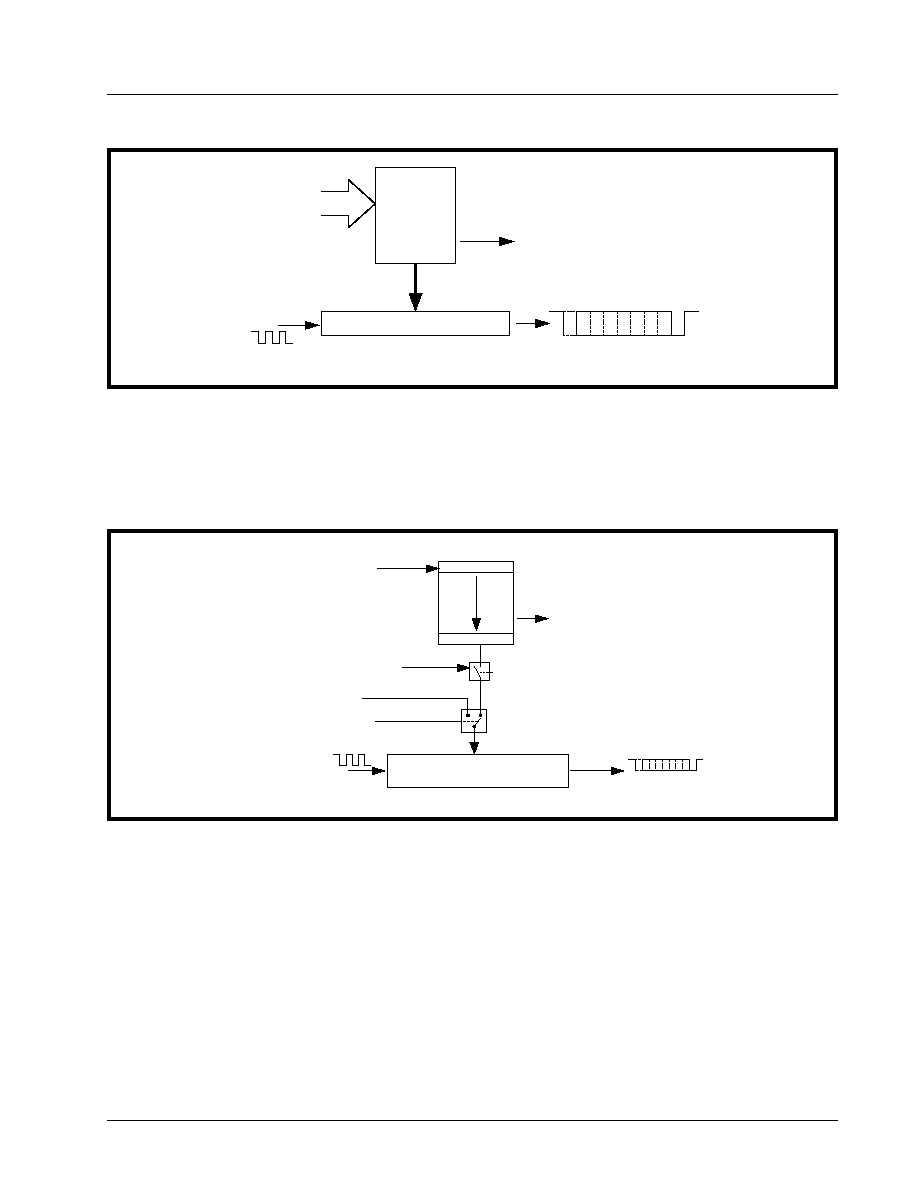
��
��
��
��
XR16C854/854D
REV. 3.0
2.97V TO 5.5V QUAD UART WITH 128-BYTE FIFO
15
2.11.3
Transmitter Operation in FIFO Mode
The host may fill the transmit FIFO with up to 128 bytes of transmit data. The THR empty flag (LSR bit-5) is set
whenever the TX FIFO is empty. The THR empty flag can generate a transmit empty interrupt (ISR bit-1) when
the FIFO becomes empty. The transmit empty interrupt is enabled by IER bit-1. The TSR flag (LSR bit-6) is set
when TSR/TX FIFO becomes empty.
2.12
Receiver
The receiver section contains an 8-bit Receive Shift Register (RSR) and 128 bytes of FIFO which includes a
byte-wide Receive Holding Register (RHR). The RSR uses the 16X clock for timing. It verifies and validates
every bit on the incoming character in the middle of each data bit. On the falling edge of a start or false start bit,
an internal receiver counter starts counting at the 16X clock rate. After 8 clocks the start bit period should be at
the center of the start bit. At this time the start bit is sampled and if it is still a logic 0 it is validated. Evaluating
the start bit in this manner prevents the receiver from assembling a false character. The rest of the data bits
and stop bits are sampled and validated in this same manner to prevent false framing. If there were any
error(s), they are reported in the LSR register bits 2-4. Upon unloading the receive data byte from RHR, the
receive FIFO pointer is bumped and the error tags are immediately updated to reflect the status of the data
byte in RHR register. RHR can generate a receive data ready interrupt upon receiving a character or delay until
it reaches the FIFO trigger level. Furthermore, data delivery to the host is guaranteed by a receive data ready
time-out interrupt when data is not received for 4 word lengths as defined by LCR[1:0] plus 12 bits time. This is
equivalent to 3.7-4.6 character times. The RHR interrupt is enabled by IER bit-0.
F
IGURE
7. T
RANSMITTER
O
PERATION
IN
NON
-FIFO M
ODE
F
IGURE
8. T
RANSMITTER
O
PERATION
IN
FIFO
AND
F
LOW
C
ONTROL
M
ODE
Transm it
Holding
Register
(THR)
Transm it S hift Register (TS R)
Data
B yte
L
S
B
M
S
B
THR Interrupt (IS R bit-1)
E nabled by IE R bit-1
T XN OF IF O 1
16X
Clock
Transm it Data Shift Register
(TSR)
Data B yte
THR Interrupt (IS R bit-1) falls
below the program m ed Trigger
Level and then when becom es
em pty. FIFO is Enabled by FCR
bit-0=1
RX FIFO
16X Clock
Auto CTS Flow Control (CTS# pin)
Auto Software Flow Control
Flow Control Characters
(Xoff1/2 and X on1/2 Reg.
T XF IF O 1
THR

XR16C854/854D
��
��
��
��
2.97V TO 5.5V QUAD UART WITH 128-BYTE FIFO
REV. 3.0
16
2.12.1
Receive Holding Register (RHR) - Read-Only
The Receive Holding Register is an 8-bit register that holds a receive data byte from the Receive Shift Register.
It provides the receive data interface to the host processor. The RHR register is part of the receive FIFO of 128
bytes by 11-bits wide, the 3 extra bits are for the 3 error tags to be reported in LSR register. When the FIFO is
enabled by FCR bit-0, the RHR contains the first data character received by the FIFO. After the RHR is read,
the next character byte is loaded into the RHR and the errors associated with the current data byte are
immediately updated in the LSR bits 2-4.
N
OTE
: Table-B selected as Trigger Table for
Figure 10
(
Table 11 on page 29
).
F
IGURE
9. R
ECEIVER
O
PERATION
IN
NON
-FIFO M
ODE
F
IGURE
10. R
ECEIVER
O
PERATION
IN
FIFO
AND
A
UTO
RTS F
LOW
C
ONTROL
M
ODE
Receive Data Shift
Register (RSR)
Receive
Data Byte
and Errors
RHR Interrupt (ISR bit-2)
Receive Data
Holding Register
(RHR)
RXFIFO1
16X Clock
Receive Data Characters
Data Bit
Validation
Error
Tags in
LSR bits
4:2
Receive Data Shift
Register (RSR)
RXFIFO1
16X Clock
E
r
r
or Ta
gs
(1
2
8
-s
e
t
s
)
E
r
r
or Ta
gs
i
n
LS
R
bi
ts
4
:
2
128 bytes by 11-bit
wide FIFO
Receive Data Characters
FIFO
Trigger=16
Example
:
- RX FIFO trigger level selected at 16
bytes
(See Note Below)
Data fills to
24
Data falls to
8
Data Bit
Validation
Receive
Data FIFO
Receive
Data
Receive Data
Byte and Errors
RHR Interrupt (ISR bit-2) programmed for
desired FIFO trigger level.
FIFO is Enabled by FCR bit-0=1
RTS# de-asserts when data fills above the flow
control trigger level to suspend remote transmitter.
Enable by EFR bit-6=1, MCR bit-1.
RTS# re-asserts when data falls below the flow
control trigger level to restart remote transmitter.
Enable by EFR bit-6=1, MCR bit-1.

��
��
��
��
XR16C854/854D
REV. 3.0
2.97V TO 5.5V QUAD UART WITH 128-BYTE FIFO
17
2.13
Auto RTS Hardware Flow Control
Automatic RTS hardware flow control is used to prevent data overrun to the local receiver FIFO. The RTS#
output is used to request remote unit to suspend/resume data transmission. The auto RTS flow control features
is enabled to fit specific application requirement (see
Figure 11
):
�
Enable auto RTS flow control using EFR bit-6.
�
The auto RTS function must be started by asserting RTS# output pin (MCR bit-1 to logic 1 after it is enabled).
If using the Auto RTS interrupt:
�
Enable RTS interrupt through IER bit-6 (after setting EFR bit-4). The UART issues an interrupt when the
RTS# pin makes a transition from low to high: ISR bit-5 will be set to logic 1.
2.14
Auto RTS Hysteresis
The 854 has a new feature that provides flow control trigger hysteresis while maintaining compatibility with the
XR16C850, ST16C650A and ST16C550 family of UARTs. With the Auto RTS function enabled, an interrupt is
generated when the receive FIFO reaches the programmed RX trigger level. The RTS# pin will not be forced
to a logic 1 (RTS off), until the receive FIFO reaches the upper limit of the hysteresis level. The RTS# pin will
return to a logic 0 after the RX FIFO is unloaded to the lower limit of the hysteresis level. Under the above
described conditions, the 854 will continue to accept data until the receive FIFO gets full. The Auto RTS
function is initiated when the RTS# output pin is asserted to a logic 0 (RTS On).
Table 15
shows the complete
details for the Auto RTS# Hysteresis levels. Please note that this table is for programmable trigger levels only
(Table D). The hysteresis values for Tables A-C are the next higher and next lower trigger levels in Tables A-C
(See
Table 11
).
2.15
Auto CTS Flow Control
Automatic CTS flow control is used to prevent data overrun to the remote receiver FIFO. The CTS# input is
monitored to suspend/restart the local transmitter. The auto CTS flow control feature is selected to fit specific
application requirement (see
Figure 11
):
�
Enable auto CTS flow control using EFR bit-7.
If using the Auto CTS interrupt:
�
Enable CTS interrupt through IER bit-7 (after setting EFR bit-4). The UART issues an interrupt when the
CTS# pin is de-asserted (logic 1): ISR bit-5 will be set to 1, and UART will suspend transmission as soon as
the stop bit of the character in process is shifted out. Transmission is resumed after the CTS# input is re-
asserted (logic 0), indicating more data may be sent.

XR16C854/854D
��
��
��
��
2.97V TO 5.5V QUAD UART WITH 128-BYTE FIFO
REV. 3.0
18
F
IGURE
11. A
UTO
RTS
AND
CTS F
LOW
C
ONTROL
O
PERATION
The local UART (UARTA) starts data transfer by asserting RTSA# (1). RTSA# is normally connected to CTSB# (2) of
remote UART (UARTB). CTSB# allows its transmitter to send data (3). TXB data arrives and fills UARTA receive FIFO
(4). When RXA data fills up to its receive FIFO trigger level, UARTA activates its RXA data ready interrupt (5) and con-
tinues to receive and put data into its FIFO. If interrupt service latency is long and data is not being unloaded, UARTA
monitors its receive data fill level to match the upper threshold of RTS delay and de-assert RTSA# (6). CTSB# follows
(7) and request UARTB transmitter to suspend data transfer. UARTB stops or finishes sending the data bits in its trans-
mit shift register (8). When receive FIFO data in UARTA is unloaded to match the lower threshold of RTS delay (9),
UARTA re-asserts RTSA# (10), CTSB# recognizes the change (11) and restarts its transmitter and data flow again until
next receive FIFO trigger (12). This same event applies to the reverse direction when UARTA sends data to UARTB
with RTSB# and CTSA# controlling the data flow.
RTSA#
CTSB#
RXA
TXB
Transmitter
Receiver FIFO
Trigger Reached
Auto RTS
Trigger Level
Auto CTS
Monitor
RTSA#
TXB
RXA FIFO
CTSB#
Remote UART
UARTB
Local UART
UARTA
ON
OFF
ON
Suspend
Restart
RTS High
Threshold
Data Starts
ON
OFF
ON
Assert RTS# to Begin
Transmission
1
2
3
4
5
6
7
Receive
Data
RTS Low
Threshold
9
10
11
Receiver FIFO
Trigger Reached
Auto RTS
Trigger Level
Transmitter
Auto CTS
Monitor
RTSB#
CTSA#
RXB
TXA
INTA
(RXA FIFO
Interrupt)
RX FIFO
Trigger Level
RX FIFO
Trigger Level
8
12
R T S C T S 1
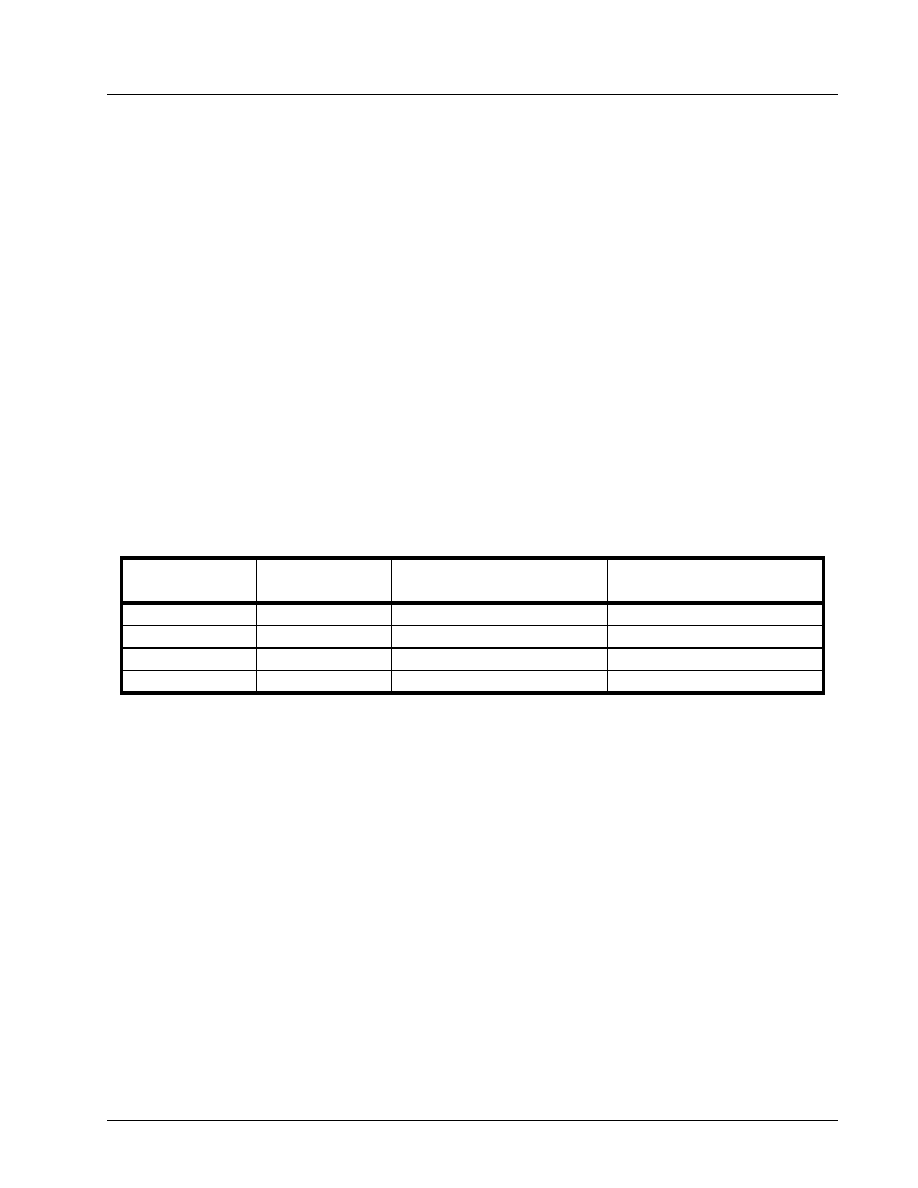
��
��
��
��
XR16C854/854D
REV. 3.0
2.97V TO 5.5V QUAD UART WITH 128-BYTE FIFO
19
2.16
Auto Xon/Xoff (Software) Flow Control
When software flow control is enabled (
See Table 17
), the 854 compares one or two sequential receive data
characters with the programmed Xon or Xoff-1,2 character value(s). If receive character(s) match the
programmed values, the 854 will halt transmission as soon as the current character has completed
transmission. When a match occurs, the Xoff (if enabled via IER bit-5) flag will be set and the interrupt output
pin will be activated. Following a suspension due to a match of the Xoff character, the 854 will monitor the
receive data stream for a match to the Xon-1,2 character. If a match is found, the 854 will resume operation and
clear the flags (ISR bit-4).
Reset initially sets the contents of the Xon/Xoff 8-bit flow control registers to a logic 0. Following reset the user
can write any Xon/Xoff value desired for software flow control. Different conditions can be set to detect Xon/
Xoff characters (
See Table 17
) and suspend/resume transmissions. When double 8-bit Xon/Xoff characters are
selected, the 854 compares two consecutive receive characters with two software flow control 8-bit values
(Xon1, Xon2, Xoff1, Xoff2) and controls TX transmissions accordingly. Under the above described flow control
mechanisms, flow control characters are not placed (stacked) in the user accessible RX data buffer or FIFO.
In the event that the receive buffer is overfilling and flow control needs to be executed, the 854 automatically
sends an Xoff message (when enabled) via the serial TX output to the remote modem. The 854 sends the Xoff-
1,2 characters two-character-times (= time taken to send two characters at the programmed baud rate) after
the receive FIFO crosses the programmed trigger level (for all trigger tables A-D). To clear this condition, the
854 will transmit the programmed Xon-1,2 characters as soon as receive FIFO is less than one trigger level
below the programmed trigger level (for Trigger Tables A, B, and C) or when receive FIFO is less than the
trigger level minus the hysteresis value (for Trigger Table D). This hysteresis value is the same as the Auto RTS
Hysteresis value in
Table 15
.
Table 7
below explains this when Trigger Table-B (See
Table 11
) is selected.
*
After the trigger level is reached, an xoff character is sent after a short span of time (= time required to send 2
characters); for example, after 2.083ms has elapsed for 9600 baud and 10-bit word length setting.
2.17
Special Character Detect
A special character detect feature is provided to detect an 8-bit character when bit-5 is set in the Enhanced
Feature Register (EFR). When this character (Xoff2) is detected, it will be placed in the FIFO along with normal
incoming RX data.
The 854 compares each incoming receive character with Xoff-2 data. If a match exists, the received data will
be transferred to FIFO and ISR bit-4 will be set to indicate detection of special character. Although the Internal
Register Table shows Xon, Xoff Registers with eight bits of character information, the actual number of bits is
dependent on the programmed word length. Line Control Register (LCR) bits 0-1 defines the number of
character bits, i.e., either 5 bits, 6 bits, 7 bits, or 8 bits. The word length selected by LCR bits 0-1 also
determines the number of bits that will be used for the special character comparison. Bit-0 in the Xon, Xoff
Registers corresponds with the LSB bit for the receive character.
2.18
Infrared Mode
The 854 UART includes the infrared encoder and decoder compatible to the IrDA (Infrared Data Association)
version 1.0. The IrDA 1.0 standard that stipulates the infrared encoder sends out a
3/16 of a bit wide HIGH-
pulse for each "0" bit in the transmit data stream. This signal encoding reduces the on-time of the infrared LED,
hence reduces the power consumption. See
Figure 12
below.
T
ABLE
7: A
UTO
X
ON
/X
OFF
(S
OFTWARE
) F
LOW
C
ONTROL
RX T
RIGGER
L
EVEL
INT P
IN
A
CTIVATION
X
OFF
C
HARACTER
(
S
) S
ENT
(
CHARACTERS
IN
RX
FIFO
)
X
ON
C
HARACTER
(
S
) S
ENT
(
CHARACTERS
IN
RX
FIFO
)
8
8
8*
0
16
16
16*
8
24
24
24*
16
28
28
28*
24

XR16C854/854D
��
��
��
��
2.97V TO 5.5V QUAD UART WITH 128-BYTE FIFO
REV. 3.0
20
The infrared encoder and decoder are enabled by setting MCR register bit-6 to a `1'. When the infrared feature
is enabled, the transmit data output, TX, idles at logic zero level. Likewise, the RX input assumes an idle level
of logic zero from a reset and power up, see
Figure 12
.
Typically, the wireless infrared decoder receives the input pulse from the infrared sensing diode on the RX pin.
Each time it senses a light pulse, it returns a logic 1 to the data bit stream. However, this is not true with some
infrared modules on the market which indicate a logic 0 by a light pulse. So the 854 has a provision to invert the
input polarity to accomodate this. In this case user can enable FCTR bit-2 to invert the input signal.
2.19
Sleep Mode with Auto Wake-Up
The 854 supports low voltage system designs, hence, a sleep mode is included to reduce its power
consumption when the chip is not actively used.
All of these conditions must be satisfied for the 854 to enter sleep mode:
s
no interrupts pending for all four channels of the 854 (ISR bit-0 = 1)
s
sleep mode of all four channels are enabled (IER bit-4 = 1)
s
modem inputs are not toggling (MSR bits 0-3 = 0)
s
RX input pins are idling at a logic 1
The 854 stops its crystal oscillator to conserve power in the sleep mode. User can check the XTAL2 pin for no
clock output as an indication that the device has entered the sleep mode.
F
IGURE
12. I
NFRARED
T
RANSMIT
D
ATA
E
NCODING
AND
R
ECEIVE
D
ATA
D
ECODING
Character
Data Bits
Start
Stop
0
0
0
0
0
1
1
1
1
1
Bit Time
1/16 Clock Delay
IRdecoder-1
RX Data
Receive
IR Pulse
(RX pin)
C h a ra cte r
D a ta B its
St
ar
t
St
op
0
0
0
0
0
1
1
1
1
1
T X D a ta
T ra n sm it
IR P u lse
(T X P in )
B it T im e
1 /2 B it T im e
3 /1 6 B it T im e
IrE n co d e r-1

��
��
��
��
XR16C854/854D
REV. 3.0
2.97V TO 5.5V QUAD UART WITH 128-BYTE FIFO
21
The 854 resumes normal operation by any of the following:
s
a receive data start bit transition (logic 1 to 0)
s
a data byte is loaded to the transmitter, THR or FIFO
s
a change of logic state on any of the modem or general purpose serial inputs: CTS#, DSR#, CD#, RI#
If the 854 is awakened by any one of the above conditions, it will return to the sleep mode automatically after all
interrupting conditions have been serviced and cleared. If the 854 is awakened by the modem inputs, a read to
the MSR is required to reset the modem inputs. In any case, the sleep mode will not be entered while an
interrupt is pending in any channel. The 854 will stay in the sleep mode of operation until it is disabled by
setting IER bit-4 to a logic 0.
If the address lines, data bus lines, IOW#, IOR#, CSA#, CSB#, CSC#, CSD# and modem input lines remain
steady when the 854 is in sleep mode, the maximum current will be in the microamp range as specified in the
DC Electrical Characteristics on
page 41
. If the input lines are floating or are toggling while the 854 is in sleep
mode, the current can be up to 100 times more. If any of those signals are toggling or floating, then an external
buffer would be required to keep the address, data and control lines steady to achieve the low current.
A word of caution: owing to the starting up delay of the crystal oscillator after waking up from sleep mode, the
first few receive characters may be lost. Also, make sure the RX input is idling at logic 1 or "marking" condition
during sleep mode. This may not occur when the external interface transceivers (RS-232, RS-485 or another
type) are also put to sleep mode and cannot maintain the "marking" condition. To avoid this, the system design
engineer can use a 47k ohm pull-up resistor on the RX A-D inputs.
2.20
Internal Loopback
The 854 UART provides an internal loopback capability for system diagnostic purposes. The internal loopback
mode
is enabled by setting MCR register bit-4 to logic 1. All regular UART functions operate normally.
Figure 13
shows how the modem port signals are re-configured. Transmit data from the transmit shift register
output is internally routed to the receive shift register input allowing the system to receive the same data that it
was sending. The TX pin is held at logic 1 or mark condition while RTS# and DTR# are de-asserted, and
CTS#, DSR# CD# and RI# inputs are ignored. Caution: the RX input must be held to a logic 1 during loopback
test else upon exiting the loopback test the UART may detect and report a false "break" signal.
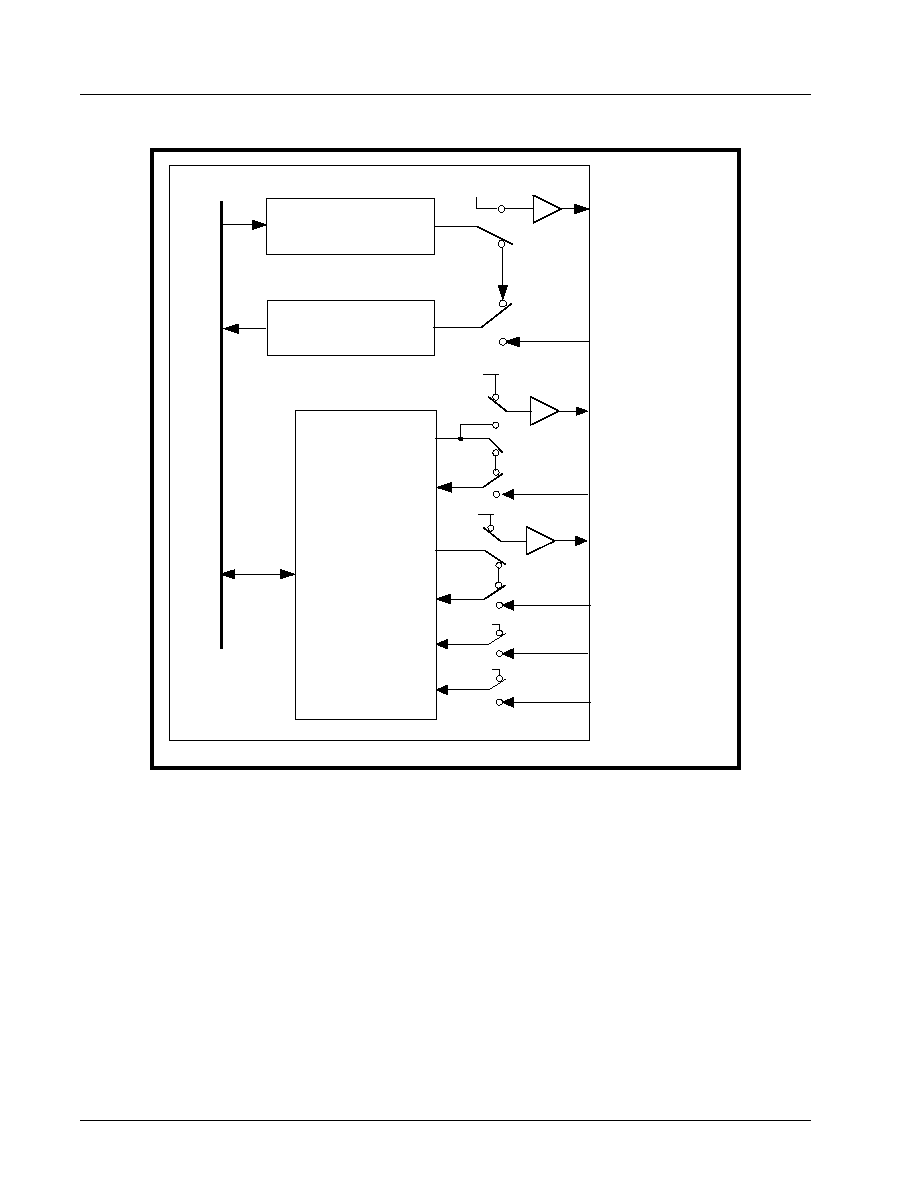
XR16C854/854D
��
��
��
��
2.97V TO 5.5V QUAD UART WITH 128-BYTE FIFO
REV. 3.0
22
F
IGURE
13. I
NTERNAL
L
OOP
B
ACK
IN
C
HANNELS
A-D
TX A-D
RX A-D
M
o
dem /
G
e
n
e
r
a
l
P
u
r
p
ose
C
o
n
t
r
o
l
Logi
c
Inte
r
n
a
l
Da
ta
Bus
L
i
ne
s
a
nd
C
o
ntr
o
l Sign
a
ls
RTS# A-D
MCR bit-4=1
VCC
VCC
Transmit Shift Register
(THR/FIFO)
Receive Shift Register
(RHR/FIFO)
CTS# A-D
DTR# A-D
DSR# A-D
RI# A-D
CD# A-D
OP1#
OP2#
RTS#
CTS#
DTR#
DSR#
RI#
CD#
VCC
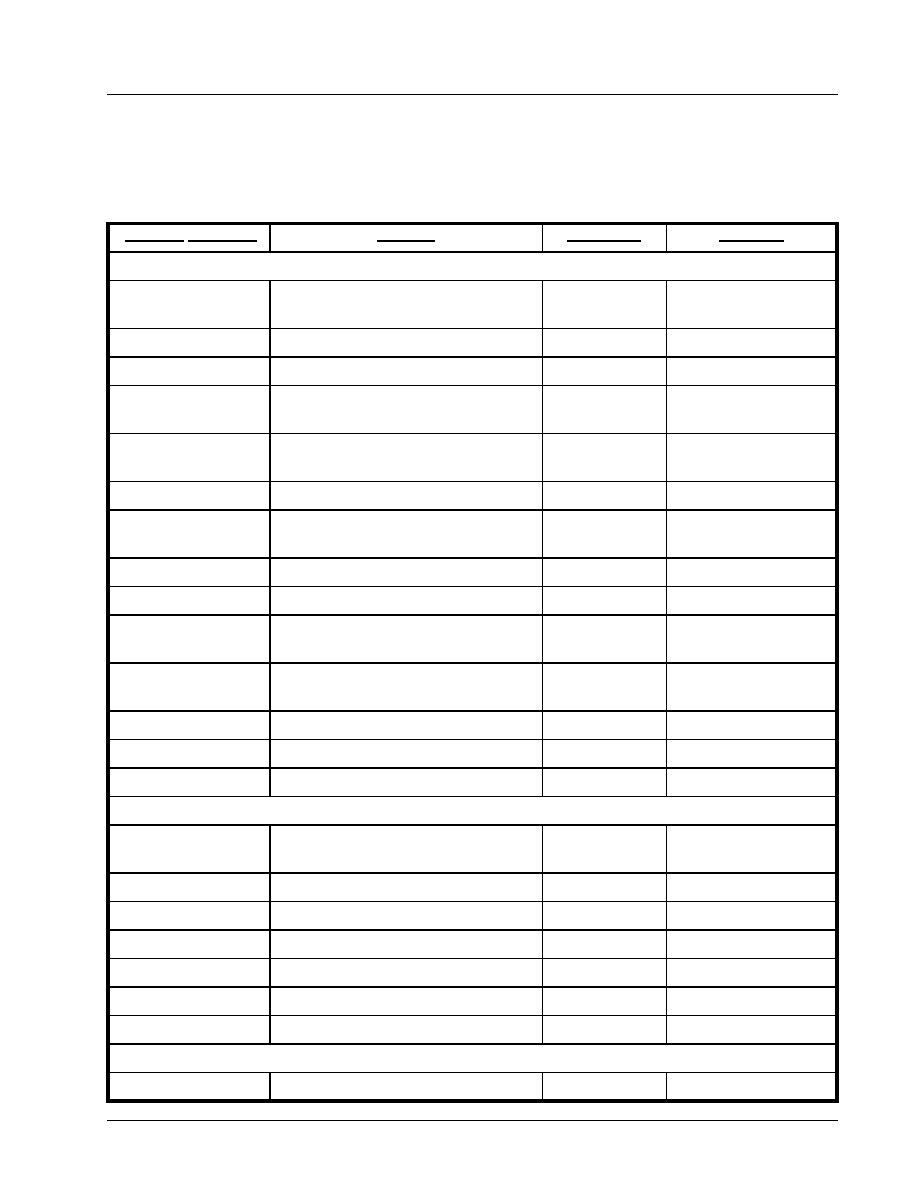
��
��
��
��
XR16C854/854D
REV. 3.0
2.97V TO 5.5V QUAD UART WITH 128-BYTE FIFO
23
3.0
UART INTERNAL REGISTERS
Each UART channel in the 854 has its own set of configuration registers selected by address lines A0, A1 and
A2 with a specific channel selected (See
Table 1
and
Table 2
). The complete register set is shown on
Table 8
and
Table 9
.
T
ABLE
8: UART CHANNEL A AND B UART INTERNAL REGISTERS
A2,A1,A0 A
DDRESSES
R
EGISTER
R
EAD
/W
RITE
C
OMMENTS
16C550 C
OMPATIBLE
R
EGISTERS
0 0 0
RHR - Receive Holding Register
THR - Transmit Holding Register
Read-only
Write-only
LCR[7] = 0
0 0 0
DLL - Div Latch Low Byte
Read/Write
LCR[7] = 1, LCR
0xBF
0 0 1
DLM - Div Latch High Byte
Read/Write
LCR[7] = 1, LCR
0xBF
0 0 0
DREV - Device Revision Code
Read-only
DLL, DLM
=
0x00,
LCR[7] = 1, LCR
0xBF
0 0 1
DVID - Device Identification Code
Read-only
DLL, DLM = 0x00,
LCR[7] = 1, LCR
0xBF
0 0 1
IER - Interrupt Enable Register
Read/Write
LCR[7] = 0
0 1 0
ISR - Interrupt Status Register
FCR - FIFO Control Register
Read-only
Write-only
LCR[7] = 0
0 1 1
LCR - Line Control Register
Read/Write
1 0 0
MCR - Modem Control Register
Read/Write
LCR[7] = 0
1 0 1
LSR - Line Status Register
Reserved
Read-only
Write-only
LCR[7] = 0
1 1 0
MSR - Modem Status Register
Reserved
Read-only
Write-only
LCR[7] = 0
1 1 1
SPR - Scratch Pad Register
Read/Write
LCR[7] = 0, FCTR[6] = 0
1 1 1
FLVL - TX/RX FIFO Level Counter Register
Read-only
LCR[7] = 0, FCTR[6] = 1
1 1 1
EMSR - Enhanced Mode Select Register
Write-only
LCR[7] = 0, FCTR[6] = 1
E
NHANCED
R
EGISTERS
0 0 0
TRG - TX/RX FIFO Trigger Level Reg
FC - TX/RX FIFO Level Counter Register
Write-only
Read-only
LCR = 0xBF
0 0 1
FCTR - Feature Control Reg
Read/Write
LCR = 0xBF
0 1 0
EFR - Enhanced Function Reg
Read/Write
LCR = 0xBF
1 0 0
Xon-1 - Xon Character 1
Read/Write
LCR = 0xBF
1 0 1
Xon-2 - Xon Character 2
Read/Write
LCR = 0xBF
1 1 0
Xoff-1 - Xoff Character 1
Read/Write
LCR = 0xBF
1 1 1
Xoff-2 - Xoff Character 2
Read/Write
LCR = 0xBF
X X X
FSTAT - FIFO Status Register
Read-only
FSRS# pin is logic 0

XR16C854/854D
��
��
��
��
2.97V TO 5.5V QUAD UART WITH 128-BYTE FIFO
REV. 3.0
24
.
T
ABLE
9: INTERNAL REGISTERS DESCRIPTION.
S
HADED
BITS
ARE
ENABLED
WHEN
EFR B
IT
-4=1
A
DDRESS
A2-A0
R
EG
N
AME
R
EAD
/
W
RITE
B
IT
-7
B
IT
-6
B
IT
-5
B
IT
-4
B
IT
-3
B
IT
-2
B
IT
-1
B
IT
-0
C
OMMENT
16C550 Compatible Registers
0 0 0
RHR
RD
Bit-7
Bit-6
Bit-5
Bit-4
Bit-3
Bit-2
Bit-1
Bit-0
LCR[7] = 0
0 0 0
THR
WR
Bit-7
Bit-6
Bit-5
Bit-4
Bit-3
Bit-2
Bit-1
Bit-0
0 0 1
IER
RD/WR
0/
0/
0/
0/
Modem
Stat. Int.
Enable
RX Line
Stat.
Int.
Enable
TX
Empty
Int
Enable
RX
Data
Int.
Enable
CTS#
Int.
Enable
RTS#
Int.
Enable
Xoff Int.
Enable
Sleep
Mode
Enable
0 1 0
ISR
RD
FIFOs
Enabled
FIFOs
Enabled
0/
0/
INT
Source
Bit-3
INT
Source
Bit-2
INT
Source
Bit-1
INT
Source
Bit-0
INT
Source
Bit-5
INT
Source
Bit-4
0 1 0
FCR
WR
RX FIFO
Trigger
RX FIFO
Trigger
0/
0/
DMA
Mode
Enable
TX
FIFO
Reset
RX
FIFO
Reset
FIFOs
Enable
TX FIFO
Trigger
TX FIFO
Trigger
0 1 1
LCR
RD/WR
Divisor
Enable
Set TX
Break
Set Par-
ity
Even
Parity
Parity
Enable
Stop
Bits
Word
Length
Bit-1
Word
Length
Bit-0
1 0 0
MCR
RD/WR
0/
0/
0/
Internal
Lopback
Enable
INT Out-
put
Enable
(OP2#)
Rsvd
(OP1#)
RTS#
Output
Control
DTR#
Output
Control
LCR[7] = 0
BRG
Pres-
caler
IR Mode
ENable
XonAny
1 0 1
LSR
RD
RX FIFO
Global
Error
THR &
TSR
Empty
THR
Empty
RX
Break
RX Fram-
ing Error
RX
Parity
Error
RX
Over-
run
Error
RX
Data
Ready
1 1 0
MSR
RD
CD#
Input
RI#
Input
DSR#
Input
CTS#
Input
Delta
CD#
Delta
RI#
Delta
DSR#
Delta
CTS#
1 1 1
SPR
RD/WR
Bit-7
Bit-6
Bit-5
Bit-4
Bit-3
Bit-2
Bit-1
Bit-0
LCR[7] = 0
FCTR[6]=0
1 1 1
EMSR
WR
Rsvd
Rsvd
Auto
RTS
Hyst.
bit-3
Auto
RTS
Hyst.
bit-2
Rsvd
Rsvd
Rx/Tx
FIFO
Count
Rx/Tx
FIFO
Count
LCR[7] = 0
FCTR[6]=1
1 1 1
FLVL
RD
Bit-7
Bit-6
Bit-5
Bit-4
Bit-3
Bit-2
Bit-1
Bit-0

��
��
��
��
XR16C854/854D
REV. 3.0
2.97V TO 5.5V QUAD UART WITH 128-BYTE FIFO
25
Baud Rate Generator Divisor
0 0 0
DLL
RD/WR
Bit-7
Bit-6
Bit-5
Bit-4
Bit-3
Bit-2
Bit-1
Bit-0
LCR[7] = 1
LCR
0xBF
0 0 1
DLM
RD/WR
Bit-7
Bit-6
Bit-5
Bit-4
Bit-3
Bit-2
Bit-1
Bit-0
0 0 0
DREV
RD
Bit-7
Bit-6
Bit-5
Bit-4
Bit-3
Bit-2
Bit-1
Bit-0
LCR[7] = 1
LCR
0xBF
DLL=0x00
DLM=0x00
0 0 1
DVID
RD
0
0
0
1
0
1
0
0
Enhanced Registers
0 0 0
TRG
WR
Bit-7
Bit-6
Bit-5
Bit-4
Bit-3
Bit-2
Bit-1
Bit-0
LCR=0
X
BF
0 0 0
FC
RD
Bit-7
Bit-6
Bit-5
Bit-4
Bit-3
Bit-2
Bit-1
Bit-0
0 0 1
FCTR
RD/WR
RX/TX
Mode
SCPAD
Swap
Trig
Table
Bit-1
Trig
Table
Bit-0
Auto
RS485
Direction
Control
RX IR
Input
Inv.
Auto
RTS
Hyst
Bit-1
Auto
RTS
Hyst
Bit-0
0 1 0
EFR
RD/WR
Auto
CTS#
Enable
Auto
RTS#
Enable
Special
Char
Select
Enable
IER [7:4],
ISR [5:4],
FCR[5:4],
MCR[7:5]
Soft-
ware
Flow
Cntl
Bit-3
Soft-
ware
Flow
Cntl
Bit-2
Soft-
ware
Flow
Cntl
Bit-1
Soft-
ware
Flow
Cntl
Bit-0
1 0 0
XON1
RD/WR
Bit-7
Bit-6
Bit-5
Bit-4
Bit-3
Bit-2
Bit-1
Bit-0
1 0 1
XON2
RD/WR
Bit-7
Bit-6
Bit-5
Bit-4
Bit-3
Bit-2
Bit-1
Bit-0
1 1 0
XOFF1 RD/WR
Bit-7
Bit-6
Bit-5
Bit-4
Bit-3
Bit-2
Bit-1
Bit-0
1 1 1
XOFF2 RD/WR
Bit-7
Bit-6
Bit-5
Bit-4
Bit-3
Bit-2
Bit-1
Bit-0
X X X
FSTAT
RD
RX-
RDYD#
RX-
RDYC#
RX-
RDYB#
RX-
RDYA#
TX-
RDYD#
TX-
RDYC#
TX-
RDYB#
TX-
RDYA#
FSRS# pin is
a logic 0. No
address lines
required.
T
ABLE
9: INTERNAL REGISTERS DESCRIPTION.
S
HADED
BITS
ARE
ENABLED
WHEN
EFR B
IT
-4=1
A
DDRESS
A2-A0
R
EG
N
AME
R
EAD
/
W
RITE
B
IT
-7
B
IT
-6
B
IT
-5
B
IT
-4
B
IT
-3
B
IT
-2
B
IT
-1
B
IT
-0
C
OMMENT

XR16C854/854D
��
��
��
��
2.97V TO 5.5V QUAD UART WITH 128-BYTE FIFO
REV. 3.0
26
4.0
INTERNAL REGISTER DESCRIPTIONS
4.1
Receive Holding Register (RHR) - Read- Only
See "Receiver" on page 15.
4.2
Transmit Holding Register (THR) - Write-Only
See "Transmitter" on page 14.
4.3
Interrupt Enable Register (IER) - Read/Write
The Interrupt Enable Register (IER) masks the interrupts from receive data ready, transmit empty, line status
and modem status registers. These interrupts are reported in the Interrupt Status Register (ISR).
4.3.1
IER versus Receive FIFO Interrupt Mode Operation
When the receive FIFO (FCR BIT-0 = 1) and receive interrupts (IER BIT-0 = 1) are enabled, the RHR interrupts
(see ISR bits 2 and 3) status will reflect the following:
A. The receive data available interrupts are issued to the host when the FIFO has reached the programmed
trigger level. It will be cleared when the FIFO drops below the programmed trigger level.
B. FIFO level will be reflected in the ISR register when the FIFO trigger level is reached. Both the ISR register
status bit and the interrupt will be cleared when the FIFO drops below the trigger level.
C. The receive data ready bit (LSR BIT-0) is set as soon as a character is transferred from the shift register to
the receive FIFO. It is reset when the FIFO is empty.
4.3.2
IER versus Receive/Transmit FIFO Polled Mode Operation
When FCR BIT-0 equals a logic 1 for FIFO enable; resetting IER bits 0-3 enables the XR16C854 in the FIFO
polled mode of operation. Since the receiver and transmitter have separate bits in the LSR either or both can
be used in the polled mode by selecting respective transmit or receive control bit(s).
A. LSR BIT-0 indicates there is data in RHR
or
RX FIFO.
B. LSR BIT-1 indicates an overrun error has occurred and that data in the FIFO may not be valid.
C. LSR BIT 2-4 provides the type of receive data errors encountered for the data byte in RHR, if any.
D. LSR BIT-5 indicates THR is empty.
E. LSR BIT-6 indicates when both the transmit FIFO and TSR are empty.
F.
LSR BIT-7 indicates a data error in at least one character in the RX FIFO.
IER[0]: RHR Interrupt Enable
The receive data ready interrupt will be issued when RHR has a data character in the non-FIFO mode
or when
the receive FIFO has reached the programmed trigger level in the FIFO mode.
Logic 0 = Disable the receive data ready interrupt (default).
Logic 1 = Enable the receiver data ready interrupt.
IER[1]: THR Interrupt Enable
This bit enables the Transmit Ready interrupt which is issued whenever the THR becomes empty in the non-
FIFO mode or when data in the FIFO falls below the programmed trigger level in the FIFO mode. If the THR is
empty when this bit is enabled, an interrupt will be generated.
Logic 0 = Disable Transmit Ready interrupt (default).
Logic 1 = Enable Transmit Ready interrupt.
IER[2]: Receive Line Status Interrupt Enable
If any of the LSR register bits 1, 2, 3 or 4 is a logic 1, it will generate an interrupt to inform the host controller
about the error status of the current data byte in FIFO. These LSR bits generate an interrupt immediately when
the character has been received.
�
Logic 0 = Disable the receiver line status interrupt (default).
�
Logic 1 = Enable the receiver line status interrupt.

��
��
��
��
XR16C854/854D
REV. 3.0
2.97V TO 5.5V QUAD UART WITH 128-BYTE FIFO
27
IER[3]: Modem Status Interrupt Enable
�
Logic 0 = Disable the modem status register interrupt (default).
�
Logic 1 = Enable the modem status register interrupt.
IER[4]: Sleep Mode Enable (requires EFR[4] = 1)
�
Logic 0 = Disable Sleep Mode (default).
�
Logic 1 = Enable Sleep Mode.
See "Sleep Mode with Auto Wake-Up" on page 20.
IER[5]: Xoff Interrupt Enable (requires EFR[4]=1)0
�
Logic 0 = Disable the software flow control, receive Xoff interrupt (default).
�
Logic 1 = Enable the software flow control, receive Xoff interrupt. See Software Flow Control section for
details.
IER[6]: RTS# Output Interrupt Enable (requires EFR[4]=1)
�
Logic 0 = Disable the RTS# interrupt (default).
�
Logic 1 = Enable the RTS# interrupt. The UART issues an interrupt when the RTS# pin makes a transition
from low to high.
IER[7]: CTS# Input Interrupt Enable (requires EFR[4]=1)
�
Logic 0 = Disable the CTS# interrupt (default).
�
Logic 1 = Enable the CTS# interrupt. The UART issues an interrupt when CTS# pin makes a transition from
low to high.
4.4
Interrupt Status Register (ISR) - Read-Only
The UART provides multiple levels of prioritized interrupts to minimize external software interaction. The
Interrupt Status Register (ISR) provides the user with six interrupt status bits. Performing a read cycle on the
ISR will give the user the current highest pending interrupt level to be serviced, others are queued up to be
serviced next. No other interrupts are acknowledged until the pending interrupt is serviced. The Interrupt
Source Table,
Table 10
, shows the data values (bit 0-5) for the interrupt priority levels and the interrupt sources
associated with each of these interrupt levels.
4.4.1
Interrupt Generation:
�
LSR is by any of the LSR bits 1, 2, 3 and 4.
�
RXRDY is by RX trigger level.
�
RXRDY Time-out is by a 4-char plus 12 bits delay timer.
�
TXRDY is by TX trigger level or TX FIFO empty (or transmitter empty in auto RS-485 control).
�
MSR is by any of the MSR bits 0, 1, 2 and 3.
�
Receive Xoff/Special character is by detection of a Xoff or Special character.
�
CTS# is when its transmitter toggles the input pin (from low to high) during auto CTS flow control.
�
RTS# is when its receiver toggles the output pin (from low to high) during auto RTS flow control.
4.4.2
Interrupt Clearing:
�
LSR interrupt is cleared by a read to the LSR register.
�
RXRDY interrupt is cleared by reading data until FIFO falls below the trigger level.
�
RXRDY Time-out interrupt is cleared by reading RHR.
�
TXRDY interrupt is cleared by a read to the ISR register or writing to THR.
�
MSR interrupt is cleared by a read to the MSR register.
�
Xoff interrupt is cleared by a read to ISR or when Xon character(s) is received.
�
Special character interrupt is cleared by a read to ISR or after the next character is received.
�
RTS# and CTS# flow control interrupts are cleared by a read to the MSR register.
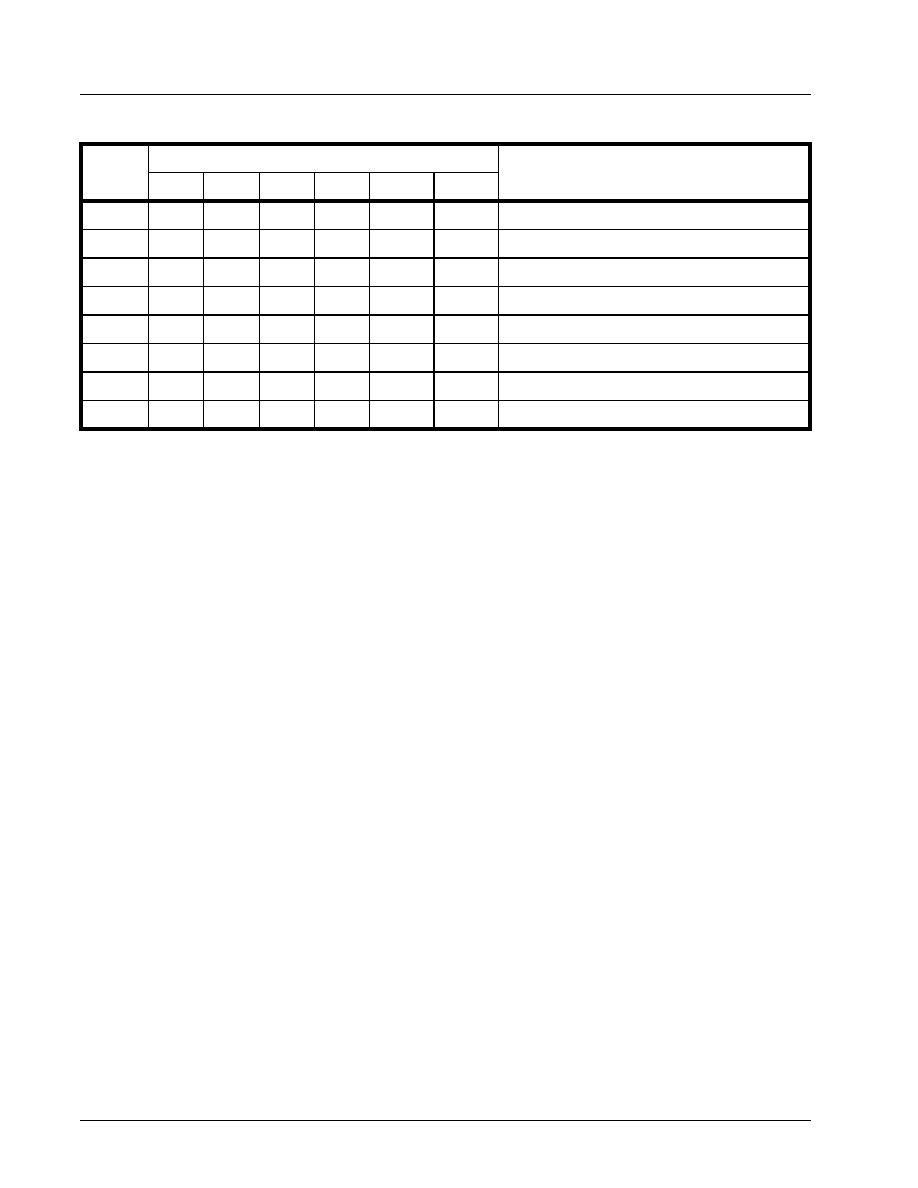
XR16C854/854D
��
��
��
��
2.97V TO 5.5V QUAD UART WITH 128-BYTE FIFO
REV. 3.0
28
]
ISR[0]: Interrupt Status
�
Logic 0 = An interrupt is pending and the ISR contents may be used as a pointer to the appropriate interrupt
service routine.
�
Logic 1 = No interrupt pending (default condition).
ISR[3:1]: Interrupt Status
These bits indicate the source for a pending interrupt at interrupt priority levels (See Interrupt Source Table 10).
ISR[5:4]: Interrupt Status
These bits are enabled when EFR bit-4 is set to a logic 1. ISR bit-4 indicates that the receiver detected a data
match of the Xoff character(s). Note that once set to a logic 1, the ISR bit-4 will stay a logic 1 until a Xon
character is received. ISR bit-5 indicates that CTS# or RTS# has changed state.
ISR[7:6]: FIFO Enable Status
These bits are set to a logic 0 when the FIFOs are disabled. They are set to a logic 1 when the FIFOs are
enabled.
4.5
FIFO Control Register (FCR) - Write-Only
This register is used to enable the FIFOs, clear the FIFOs, set the transmit/receive FIFO trigger levels, and
select the DMA mode. The DMA and FIFO modes are defined as follows:
FCR[0]: TX and RX FIFO Enable
�
Logic 0 = Disable the transmit and receive FIFO (default).
�
Logic 1 = Enable the transmit and receive FIFOs. This bit must be set to logic 1 when other FCR bits are
written or they will not be programmed.
FCR[1]: RX FIFO Reset
This bit is only active when FCR bit-0 is a `1'.
�
Logic 0 = No receive
FIFO
reset (default)
�
Logic 1 = Reset the receive FIFO pointers and FIFO level counter logic (the receive shift register is not
cleared or altered). This bit will return to a logic 0 after resetting the FIFO.
T
ABLE
10: I
NTERRUPT
S
OURCE
AND
P
RIORITY
L
EVEL
P
RIORITY
ISR R
EGISTER
S
TATUS
B
ITS
S
OURCE
OF
INTERRUPT
L
EVEL
B
IT
-5
B
IT
-4
B
IT
-3
B
IT
-2
B
IT
-1
B
IT
-0
1
0
0
0
1
1
0
LSR (Receiver Line Status Register)
2
0
0
1
1
0
0
RXRDY (Receive Data Time-out)
3
0
0
0
1
0
0
RXRDY (Received Data Ready)
4
0
0
0
0
1
0
TXRDY (Transmit Ready)
5
0
0
0
0
0
0
MSR (Modem Status Register)
6
0
1
0
0
0
0
RXRDY (Received Xoff or Special character)
7
1
0
0
0
0
0
CTS#, RTS# change of state
-
0
0
0
0
0
1
None (default)
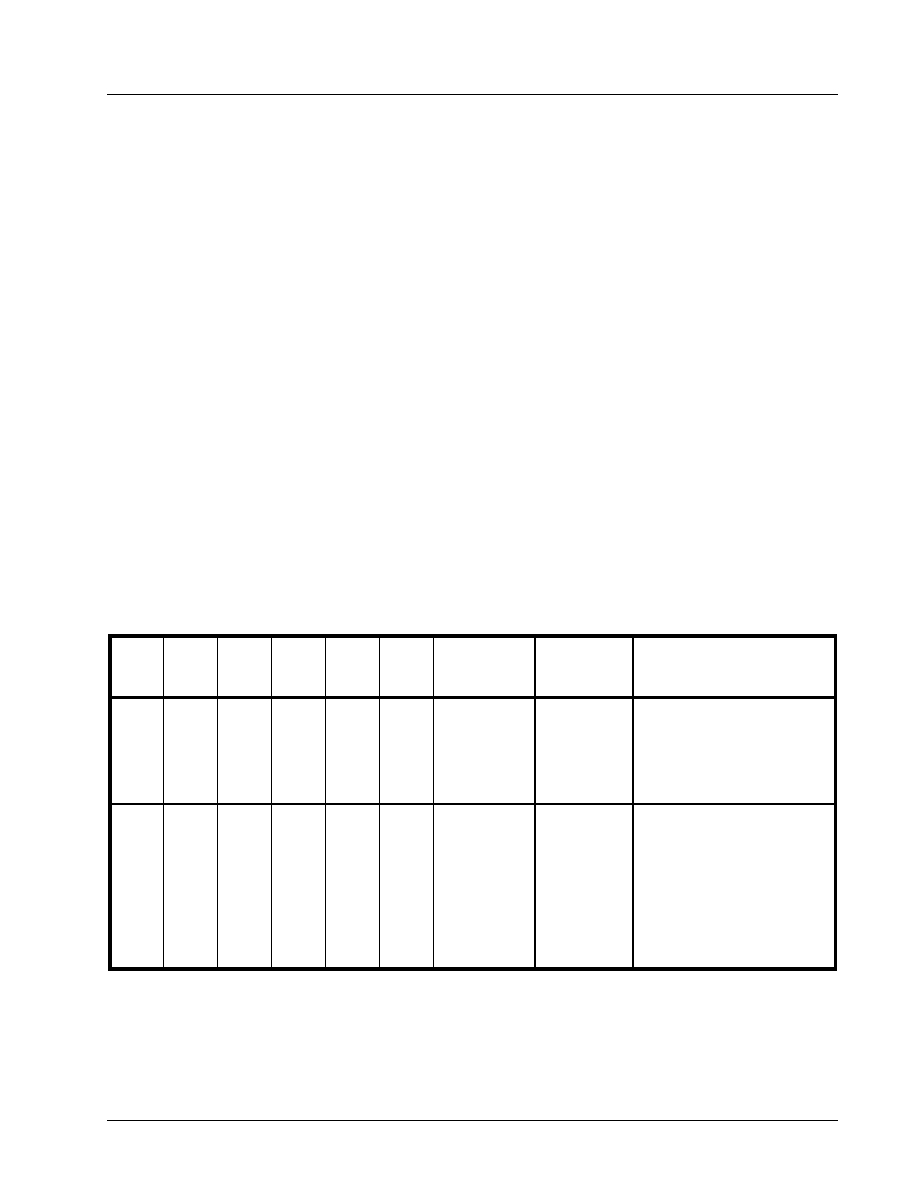
��
��
��
��
XR16C854/854D
REV. 3.0
2.97V TO 5.5V QUAD UART WITH 128-BYTE FIFO
29
FCR[2]: TX FIFO Reset
This bit is only active when FCR bit-0 is a `1'.
�
Logic 0 = No transmit FIFO reset (default).
�
Logic 1 = Reset the transmit FIFO pointers and FIFO level counter logic (the transmit shift register is not
cleared or altered). This bit will return to a logic 0 after resetting the FIFO.
FCR[3]: DMA Mode Select
Controls the behavior of the TXRDY# and RXRDY# pins. See DMA operation section for details.
�
Logic 0 = Normal Operation (default).
�
Logic 1 = DMA Mode.
FCR[5:4]: Transmit FIFO Trigger Select
(logic 0 = default, TX trigger level = one)
These 2 bits set the trigger level for the transmit FIFO. The UART will issue a transmit interrupt when the
number of characters in the FIFO falls below the selected trigger level, or when it gets empty in case that the
FIFO did not get filled over the trigger level on last re-load.
Table 11
below shows the selections. EFR bit-4
must be set to `1' before these bits can be accessed. Note that the receiver and the transmitter cannot use
different trigger tables. Whichever selection is made last applies to both the RX and TX side.
FCR[7:6]: Receive FIFO Trigger Select
(logic 0 = default, RX trigger level =1)
The FCTR Bits 5-4 are associated with these 2 bits. These 2 bits are used to set the trigger level for the receive
FIFO. The UART will issue a receive interrupt when the number of the characters in the FIFO crosses the
trigger level.
Table 11
shows the complete selections. Note that the receiver and the transmitter cannot use
different trigger tables. Whichever selection is made last applies to both the RX and TX side.
T
ABLE
11: T
RANSMIT
AND
R
ECEIVE
FIFO T
RIGGER
L
EVEL
S
ELECTION
FCTR
B
IT
-5
FCTR
B
IT
-4
FCR
B
IT
-7
FCR
B
IT
-6
FCR
B
IT
-5
FCR
BIT
-4
R
ECEIVE
T
RIGGER
L
EVEL
T
RANSMIT
T
RIGGER
L
EVEL
C
OMPATIBILITY
0
0
0
0
1
1
0
1
0
1
0
0
1 (default)
4
8
14
1 (default)
Table-A. 16C550, 16C2550,
16C2552, 16C554, 16C580
compatible.
0
1
0
0
1
1
0
1
0
1
0
0
1
1
0
1
0
1
8
16
24
28
16
8
24
30
Table-B. 16C650A compatible.

XR16C854/854D
��
��
��
��
2.97V TO 5.5V QUAD UART WITH 128-BYTE FIFO
REV. 3.0
30
4.6
Line Control Register (LCR) - Read/Write
The Line Control Register is used to specify the asynchronous data communication format. The word or
character length, the number of stop bits, and the parity are selected by writing the appropriate bits in this
register.
LCR[1:0]: TX and RX Word Length Select
These two bits specify the word length to be transmitted or received.
LCR[2]: TX and RX Stop-bit Length Select
The length of stop bit is specified by this bit in conjunction with the programmed word length.
1
0
0
0
1
1
0
1
0
1
0
0
1
1
0
1
0
1
8
16
56
60
8
16
32
56
Table-C. 16C654 compatible.
1
1
X
X
X
X
Programmable
via TRG
register.
FCTR[7] = 0.
Programmable
via TRG
register.
FCTR[7] = 1.
Table-D. 16L2750, 16C2850,
16C2852, 16C850, 16C864
compatible.
BIT-1
BIT-0
W
ORD
LENGTH
0
0
5 (default)
0
1
6
1
0
7
1
1
8
BIT-2
W
ORD
LENGTH
S
TOP
BIT
LENGTH
(B
IT
TIME
(
S
))
0
5,6,7,8
1 (default)
1
5
1-1/2
1
6,7,8
2
T
ABLE
11: T
RANSMIT
AND
R
ECEIVE
FIFO T
RIGGER
L
EVEL
S
ELECTION
FCTR
B
IT
-5
FCTR
B
IT
-4
FCR
B
IT
-7
FCR
B
IT
-6
FCR
B
IT
-5
FCR
BIT
-4
R
ECEIVE
T
RIGGER
L
EVEL
T
RANSMIT
T
RIGGER
L
EVEL
C
OMPATIBILITY

��
��
��
��
XR16C854/854D
REV. 3.0
2.97V TO 5.5V QUAD UART WITH 128-BYTE FIFO
31
LCR[3]: TX and RX Parity Select
Parity or no parity can be selected via this bit. The parity bit is a simple way used in communications for data
integrity check. See
Table 12
for parity selection summary below.
�
Logic 0 = No parity.
�
Logic 1 = A parity bit is generated during the transmission while the receiver checks for parity error of the
data character received.
LCR[4]: TX and RX Parity Select
If the parity bit is enabled with LCR bit-3 set to a logic 1, LCR BIT-4 selects the even or odd parity format.
�
Logic 0 = ODD Parity is generated by forcing an odd number of logic 1's in the transmitted character. The
receiver must be programmed to check the same format (default).
�
Logic 1 = EVEN Parity is generated by forcing an even number of logic 1's in the transmitted character. The
receiver must be programmed to check the same format.
LCR[5]: TX and RX Parity Select
If the parity bit is enabled, LCR BIT-5 selects the forced parity format.
�
LCR BIT-5 = logic 0, parity is not forced (default).
�
LCR BIT-5 = logic 1 and LCR BIT-4 = logic 0, parity bit is forced to a logical 1 for the transmit and receive
data.
�
LCR BIT-5 = logic 1 and LCR BIT-4 = logic 1, parity bit is forced to a logical 0 for the transmit and receive
data.
LCR[6]: Transmit Break Enable
When enabled, the Break control bit causes a break condition to be transmitted (the TX output is forced to a
"space', logic 0, state). This condition remains, until disabled by setting LCR bit-6 to a logic 0.
�
Logic 0 = No TX break condition (default).
�
Logic 1 = Forces the transmitter output (TX) to a "space", logic 0, for alerting the remote receiver of a line
break condition.
LCR[7]: Baud Rate Divisors Enable
�
Logic 0 = Data registers are selected (default).
�
Logic 1 = Divisor latch registers are selected.
T
ABLE
12: P
ARITY
SELECTION
LCR B
IT
-5
LCR B
IT
-4
LCR B
IT
-3
P
ARITY
SELECTION
X
X
0
No parity
0
0
1
Odd parity
0
1
1
Even parity
1
0
1
Force parity to mark, "1"
1
1
1
Forced parity to space, "0"

XR16C854/854D
��
��
��
��
2.97V TO 5.5V QUAD UART WITH 128-BYTE FIFO
REV. 3.0
32
4.7
Modem Control Register (MCR) or General Purpose Outputs Control - Read/Write
The MCR register is used for controlling the serial/modem interface signals or general purpose inputs/outputs.
MCR[0]: DTR# Output
The DTR# pin is a modem control output. If the modem interface is not used, this output may be used as a
general purpose output.
�
Logic 0 = Force DTR# output to a logic 1 (default).
�
Logic 1 = Force DTR# output to a logic 0.
MCR[1]: RTS# Output
The RTS# pin is a modem control output and may be used for automatic hardware flow control by enabled by
EFR bit-6. If the modem interface is not used, this output may be used as a general purpose output.
�
Logic 0 = Force RTS# output to a logic 1 (default).
�
Logic 1 = Force RTS# output to a logic 0.
MCR[2]: Reserved
OP1# is not available as an output pin on the 854. But it is available for use during Internal Loopback Mode. In
the Loopback Mode, this bit is used to write the state of the modem RI# interface signal. If OP1# output is
required for RS485 operation, use the XR16C864.
MCR[3]: INT Output Enable
Enable or disable INT outputs to become active or in three-state. This function is associated with the INTSEL
input, see below table for details. This bit is also used to control the OP2# signal during internal loopback
mode. INTSEL pin must be set to a logic zero during 68 mode.
�
Logic 0 = INT (A-D) outputs disabled (three state) in the 16 mode (default). During loopback mode, it sets
OP2# internally to a logic 1.
�
Logic 1 = INT (A-D) outputs enabled (active) in the 16 mode. During loopback mode, it sets OP2# internally
to a logic 0.
MCR[4]: Internal Loopback Enable
�
Logic 0 = Disable loopback mode (default).
�
Logic 1 = Enable local loopback mode, see loopback section and
Figure 13
.
MCR[5]: Xon-Any Enable
�
Logic 0 = Disable Xon-Any function (for 16C550 compatibility, default).
�
Logic 1 = Enable Xon-Any function. In this mode, any RX character received will resume transmit operation.
The RX character will be loaded into the RX FIFO , unless the RX character is an Xon or Xoff character and
the 854 is programmed to use the Xon/Xoff flow control.
T
ABLE
13: INT O
UTPUT
M
ODES
INTSEL
P
IN
MCR
B
IT
-3
INT A-D O
UTPUTS
IN
16 M
ODE
0
0
Three-State
0
1
Active
1
X
Active

��
��
��
��
XR16C854/854D
REV. 3.0
2.97V TO 5.5V QUAD UART WITH 128-BYTE FIFO
33
MCR[6]: Infrared Encoder/Decoder Enable
�
Logic 0 = Enable the standard modem receive and transmit input/output interface (default).
�
Logic 1 = Enable infrared IrDA receive and transmit inputs/outputs. The TX/RX output/input are routed to the
infrared encoder/decoder. The data input and output levels conform to the IrDA infrared interface
requirement. The RX FIFO may need to be flushed upon enable. While in this mode, the infrared TX output
will be a logic 0 during idle data conditions.
MCR[7]: Clock Prescaler Select
The CLKSEL pin selects this function upon power up or reset. After the power up or reset, this register bit will
have control and can alter the logic state.
�
Logic 0 = Divide by one. The input clock from the crystal or external clock is fed directly to the Programmable
Baud Rate Generator without further modification, i.e., divide by one (default).
�
Logic 1 = Divide by four. The prescaler divides the input clock from the crystal or external clock by four and
feeds it to the Programmable Baud Rate Generator, hence, data rates become one forth.
4.8
Line Status Register (LSR) - Read Only
This register provides the status of data transfers between the UART and the host. If LSR bits 1-4 are
asserted, an interrupt will be generated immediately if IER bit-2 is enabled.
LSR[0]: Receive Data Ready Indicator
�
Logic 0 = No data in receive holding register or FIFO (default).
�
Logic 1 = Data has been received and is saved in the receive holding register or FIFO.
LSR[1]: Receiver Overrun Flag
�
Logic 0 = No overrun error (default).
�
Logic 1 = Overrun error. A data overrun error condition occurred in the receive shift register. This happens
when additional data arrives while the FIFO is full. In this case the previous data in the receive shift register is
overwritten. Note that under this condition the data byte in the receive shift register is not transferred into the
FIFO, therefore the data in the FIFO is not corrupted by the error.
LSR[2]: Receive Data Parity Error Tag
�
Logic 0 = No parity error (default).
�
Logic 1 = Parity error. The receive character in RHR does not have correct parity information and is suspect.
This error is associated with the character available for reading in RHR.
LSR[3]: Receive Data Framing Error Tag
�
Logic 0 = No framing error (default).
�
Logic 1 = Framing error. The receive character did not have a valid stop bit(s). This error is associated with
the character available for reading in RHR.
LSR[4]: Receive Break Tag
�
Logic 0 = No break condition (default).
�
Logic 1 = The receiver received a break signal (RX was a logic 0 for at least one character frame time). In the
FIFO mode, only one break character is loaded into the FIFO. The break indication remains until the RX input
returns to the idle condition, "mark" or logic 1.
LSR[5]: Transmit Holding Register Empty Flag
This bit is the Transmit Holding Register Empty indicator. The THR bit is set to a logic 1 when the last data byte
is transferred from the transmit holding register to the transmit shift register. The bit is reset to logic 0
concurrently with the data loading to the transmit holding register by the host. In the FIFO mode this bit is set
when the transmit FIFO is empty, it is cleared when the transmit FIFO contains at least 1 byte.

XR16C854/854D
��
��
��
��
2.97V TO 5.5V QUAD UART WITH 128-BYTE FIFO
REV. 3.0
34
LSR[6]: THR and TSR Empty Flag
This bit is set to a logic 1 whenever the transmitter goes idle. It is set to logic 0 whenever either the THR or TSR
contains a data character. In the FIFO mode this bit is set to a logic 1 whenever the transmit FIFO and transmit
shift register are both empty.
LSR[7]: Receive FIFO Data Error Flag
�
Logic 0 = No FIFO error (default).
�
Logic 1 = A global indicator for the sum of all error bits in the RX FIFO. At least one parity error, framing error
or break indication is in the FIFO data. This bit clears when there is no more error(s) in any of the bytes in the
RX FIFO.
4.9
Modem Status Register (MSR) - Read Only
This register provides the current state of the modem interface input signals. Lower four bits of this register are
used to indicate the changed information. These bits are set to a logic 1 whenever a signal from the modem
changes state. These bits may be used for general purpose inputs when they are not used with modem
signals.
MSR[0]: Delta CTS# Input Flag
�
Logic 0 = No change on CTS# input (default).
�
Logic 1 = The CTS# input has changed state since the last time it was monitored. A modem status interrupt
will be generated if MSR interrupt is enabled (IER bit-3).
MSR[1]: Delta DSR# Input Flag
�
Logic 0 = No change on DSR# input (default).
�
Logic 1 = The DSR# input has changed state since the last time it was monitored. A modem status interrupt
will be generated if MSR interrupt is enabled (IER bit-3).
MSR[2]: Delta RI# Input Flag
�
Logic 0 = No change on RI# input (default).
�
Logic 1 = The RI# input has changed from a logic 0 to a logic 1, ending of the ringing signal. A modem status
interrupt will be generated if MSR interrupt is enabled (IER bit-3).
MSR[3]: Delta CD# Input Flag
�
Logic 0 = No change on CD# input (default).
�
Logic 1 = Indicates that the CD# input has changed state since the last time it was monitored. A modem
status interrupt will be generated if MSR interrupt is enabled (IER bit-3).
MSR[4]: CTS Input Status
CTS# pin may function as automatic hardware flow control signal input if it is enabled and selected by Auto
CTS (EFR bit-7). Auto CTS flow control allows starting and stopping of local data transmissions based on the
modem CTS# signal. A logic 1 on the CTS# pin will stop UART transmitter as soon as the current character
has finished transmission, and a logic 0 will resume data transmission. Normally MSR bit-4 bit is the
compliment of the CTS# input. However in the loopback mode, this bit is equivalent to the RTS# bit in the MCR
register. The CTS# input may be used as a general purpose input when the modem interface is not used.
MSR[5]: DSR Input Status
DSR#
(active high, logical 1). Normally this bit is the compliment of the DSR# input. In the loopback mode, this
bit is equivalent to the DTR# bit in the MCR register. The DSR# input may be used as a general purpose input
when the modem interface is not used.
MSR[6]: RI Input Status
RI# (active high, logical 1). Normally this bit is the compliment of the RI# input. In the loopback mode this bit is
equivalent to bit-2 in the MCR register. The RI# input may be used as a general purpose input when the
modem interface is not used.
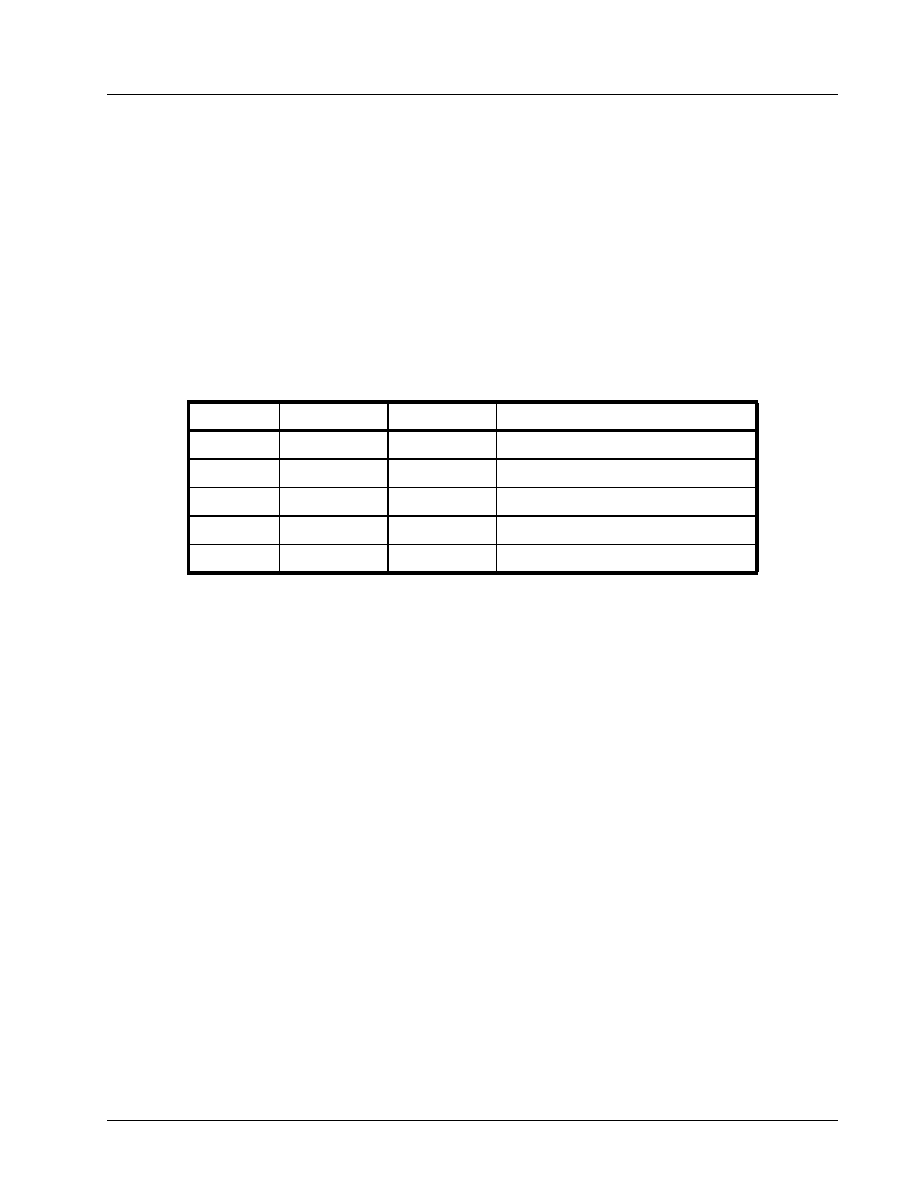
��
��
��
��
XR16C854/854D
REV. 3.0
2.97V TO 5.5V QUAD UART WITH 128-BYTE FIFO
35
MSR[7]: CD Input Status
CD# (active high, logical 1). Normally this bit is the compliment of the CD# input. In the loopback mode this bit
is equivalent to bit-3 in the MCR register. The CD# input may be used as a general purpose input when the
modem interface is not used.
4.10
Scratch Pad Register (SPR) - Read/Write
This is a 8-bit general purpose register for the user to store temporary data. The content of this register is
preserved during sleep mode but becomes 0xFF (default) after a reset or a power off-on cycle.
4.11
Enhanced Mode Select Register (EMSR)
This register replaces SPR (during a Write) and is accessible only when FCTR[6] = 1.
EMSR[1:0]: Receive/Transmit FIFO Count (Write-Only)
When Scratchpad Swap (FCTR[6]) is asserted, EMSR bits 1-0 controls what mode the FIFO Level Counter is
operating in.
During Alternate RX/TX FIFO Counter Mode, the first value read after EMSR bits 1-0 have been asserted will
always be the RX FIFO Counter. The second value read will correspond with the TX FIFO Counter. The next
value will be the RX FIFO Counter again, then the TX FIFO Counter and so on and so forth.
EMSR[3:2]: Reserved
T
ABLE
14: S
CRATCHPAD
S
WAP
S
ELECTION
FCTR[6]
EMSR[1]
EMSR[0]
Scratchpad is
0
X
X
Scratchpad
1
0
0
RX FIFO Counter Mode
1
0
1
TX FIFO Counter Mode
1
1
0
RX FIFO Counter Mode
1
1
1
Alternate RX/TX FIFO Counter Mode

XR16C854/854D
��
��
��
��
2.97V TO 5.5V QUAD UART WITH 128-BYTE FIFO
REV. 3.0
36
EMSR[5:4]: Extended RTS Hysteresis
T
ABLE
15: A
UTO
RTS H
YSTERESIS
EMSR[7:6]: Reserved
4.12
FIFO Level Register (FLVL) - Read-Only
The FIFO Level Register replaces the Scratchpad Register (during a Read) when FCTR[6] = 1. Note that this
is not identical to the FIFO Data Count Register which can be accessed when LCR = 0xBF.
FLVL[7:0]: FIFO Level Register
This register provides the FIFO counter level for the RX FIFO or the TX FIFO or both depending on EMSR[1:0].
See Table 14
for details.
4.13
Baud Rate Generator Registers (DLL and DLM) - Read/Write
The concatenation of the contents of DLM and DLL gives the 16-bit divisor value which is used to calculate the
baud rate:
�
Baud Rate = (Clock Frequency / 16) / Divisor
See MCR bit-7 and the baud rate table also.
4.14
Device Identification Register (DVID) - Read Only
This register contains the device ID (0x14 for XR16C854). Prior to reading this register, DLL and DLM should
be set to 0x00.
4.15
Device Revision Register (DREV) - Read Only
This register contains the device revision information. For example, 0x01 means revision A. Prior to reading
this register, DLL and DLM should be set to 0x00.
4.16
Trigger Level (TRG) - Write-Only
User Programmable Transmit/Receive Trigger Level Register.
TRG[7:0]: Trigger Level Register
These bits are used to program desired trigger levels when trigger Table-D is selected. FCTR bit-7 selects
between programming the RX Trigger Level (a logic 0) and the TX Trigger Level (a logic 1).
EMSR
B
IT
-5
EMSR
B
IT
-4
FCTR
B
IT
-1
FCTR
B
IT
-0
RTS#
H
YSTERESIS
(C
HARACTERS
)
0
0
0
0
0
0
0
0
0
0
1
1
0
1
0
1
0
�4
�6
�8
0
0
0
0
1
1
1
1
0
0
1
1
0
1
0
1
�8
�16
�24
�32
1
1
1
1
0
0
0
0
0
0
1
1
0
1
0
1
�40
�44
�48
�52
1
1
1
1
1
1
1
1
0
0
1
1
0
1
0
1
�12
�20
�28
�36
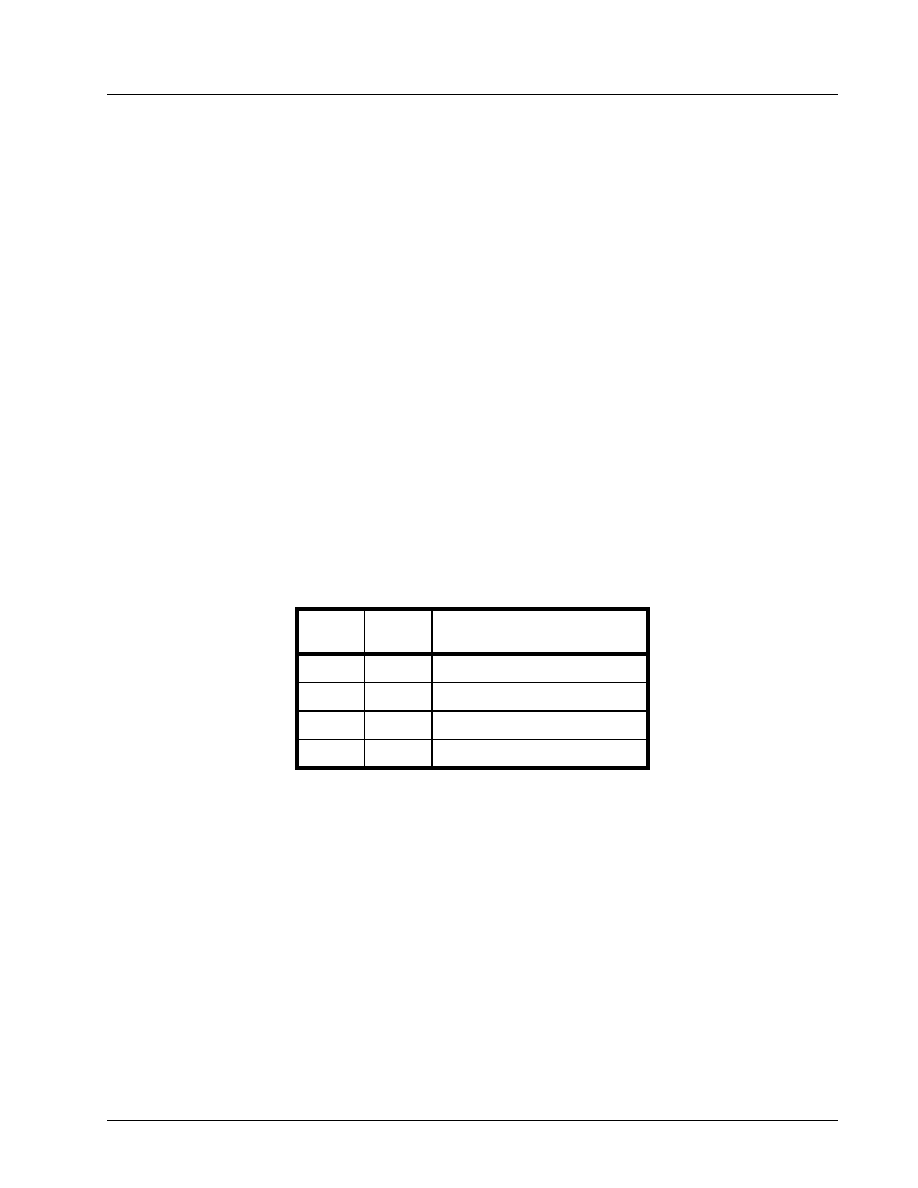
��
��
��
��
XR16C854/854D
REV. 3.0
2.97V TO 5.5V QUAD UART WITH 128-BYTE FIFO
37
4.17
FIFO Data Count Register (FC) - Read-Only
This register is accessible when LCR = 0xBF. Note that this register is not identical to the FIFO Level Count
Register which is located in the general register set when FCTR bit-6 = 1 (Scratchpad Register Swap). It is
suggested to read the FIFO Level Count Register at the Scratchpad Register location when FCTR bit-6 = 1.
See
Table 14
.
FC[7:0]: FIFO Data Count Register
Transmit/Receive FIFO Count. Number of characters in Transmit (FCTR[7] = 1) or Receive FIFO (FCTR[7] = 0)
can be read via this register.
4.18
Feature Control Register (FCTR) - Read/Write
This register controls the XR16C854 new functions that are not available in ST16C554 or ST16C654.
FCTR[1:0]: RTS Hysteresis
User selectable RTS# hysteresis levels for hardware flow control application. After reset, these bits are set to
"0" to select the next trigger level for hardware flow control. See
Table 15 on page 36
for more details.
FCTR[2]: IrDA RX Inversion
�
Logic 0 = Select RX input as encoded IrDA data (Idle state will be logic 0).
�
Logic 1 = Select RX input as inverted encoded IrDA data (Idle state will be logic 1).
FCTR[3]: Auto RS-485 Direction Control
The Auto RS-485 Direction Control is not available in the XR16C854. See XR16C864. However, this bit
changes the TX Ready Interrupt behavior. See
Table 3
.
FCTR[5:4]: Transmit/Receive Trigger Table Select
See
Table 11 on page 29
for more details.
FCTR[6]: Scratchpad Swap
�
Logic 0 = Scratch Pad register is selected as general read and write register. ST16C550 compatible mode.
�
Logic 1 = FIFO Count register (Read-Only), Enhanced Mode Select Register (Write-Only). Number of
characters in transmit or receive holding register can be read via scratch pad register when this bit is set.
Enhanced Mode Select Register is selected when it is written into.
FCTR[7]: Programmable Trigger Register Select
�
Logic 0 = Registers TRG and FC selected for RX.
�
Logic 1 = Registers TRG and FC selected for TX.
4.19
Enhanced Feature Register (EFR) - Read/Write
Enhanced features are enabled or disabled using this register. Bit 0-3 provide single or dual consecutive
character software flow control selection (see
Table 17
). When the Xon1 and Xon2 and Xoff1 and Xoff2 modes
are selected, the double 8-bit words are concatenated into two sequential characters. Caution: note that
whenever changing the TX or RX flow control bits, always reset all bits back to logic 0 (disable) before
programming a new setting.
T
ABLE
16: T
RIGGER
T
ABLE
S
ELECT
FCTR
B
IT
-5
FCTR
B
IT
-4
T
ABLE
0
0
Table-A (TX/RX)
0
1
Table-B (TX/RX)
1
0
Table-C (TX/RX)
1
1
Table-D (TX/RX)
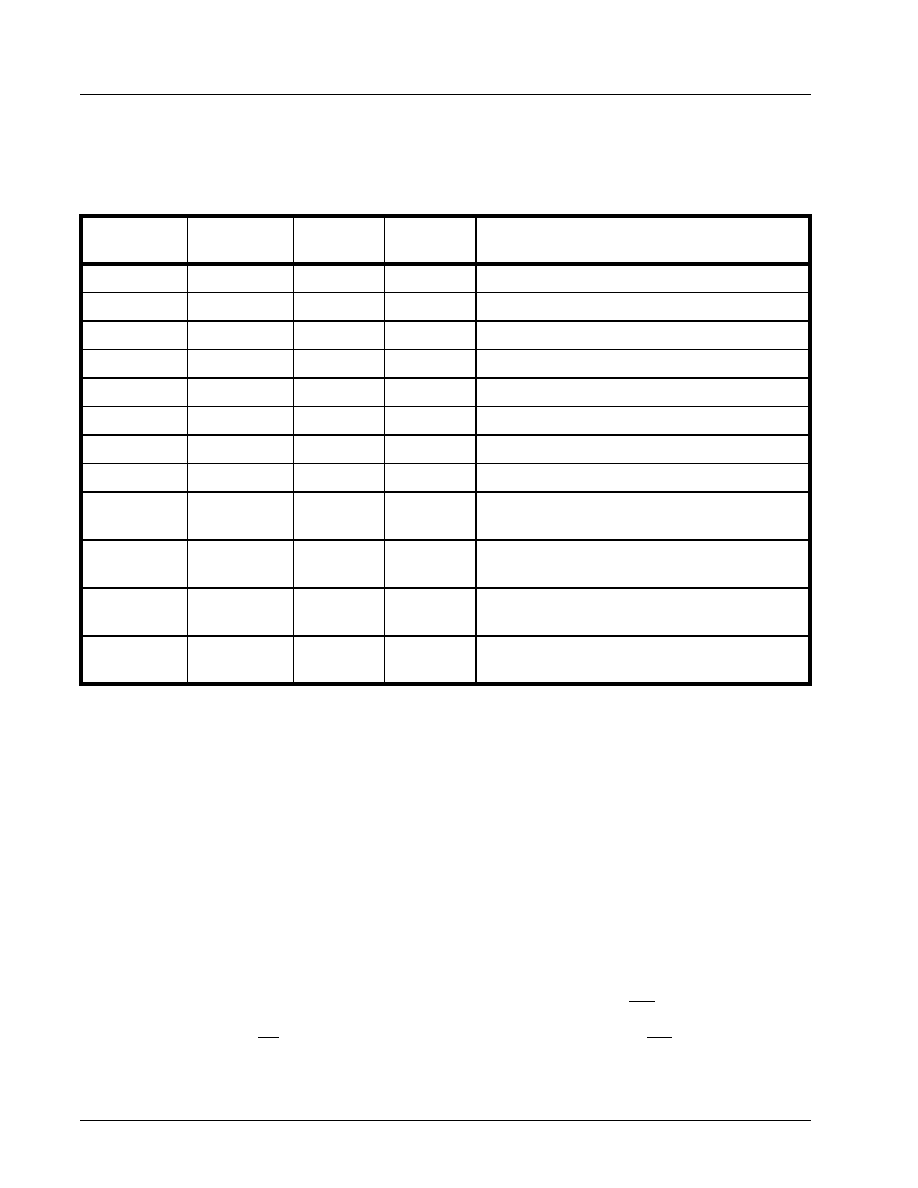
XR16C854/854D
��
��
��
��
2.97V TO 5.5V QUAD UART WITH 128-BYTE FIFO
REV. 3.0
38
EFR[3:0]: Software Flow Control Select
Single character and dual sequential characters software flow control is supported. Combinations of software
flow control can be selected by programming these bits.
EFR[4]: Enhanced Function Bits Enable
Enhanced function control bit. This bit enables IER bits 4-7, ISR bits 4-5, FCR bits 4-5, and MCR bits 5-7 to be
modified. After modifying any enhanced bits, EFR bit-4 can be set to a logic 0 to latch the new values. This
feature prevents legacy software from altering or overwriting the enhanced functions once set. Normally, it is
recommended to leave it enabled, logic 1.
�
Logic 0 = modification disable/latch enhanced features. IER bits 4-7, ISR bits 4-5, FCR bits 4-5, and MCR
bits 5-7 are saved to retain the user settings. After a reset, the IER bits 4-7, ISR bits 4-5, FCR bits 4-5, and
MCR bits 5-7are set to a logic 0 to be compatible with ST16C550 mode (default).
�
Logic 1 = Enables the above-mentioned register bits to be modified by the user.
EFR[5]: Special Character Detect Enable
�
Logic 0 = Special Character Detect Disabled (default).
�
Logic 1 = Special Character Detect Enabled. The UART compares each incoming receive character with
data in Xoff-2 register. If a match exists, the receive data will be transferred to FIFO and ISR bit-4 will be set
to indicate detection of the special character. Bit-0 corresponds with the LSB bit of the receive character. If
flow control is set for comparing Xon1, Xoff1 (EFR [1:0]= `10') then flow control and special character work
normally. However, if flow control is set for comparing Xon2, Xoff2 (EFR[1:0]= `01') then flow control works
normally, but Xoff2 will not go to the FIFO, and will generate an Xoff interrupt and a special character
interrupt, if enabled via IER bit-5.
T
ABLE
17: S
OFTWARE
F
LOW
C
ONTROL
F
UNCTIONS
EFR
BIT
-3
C
ONT
-3
EFR
BIT
-2
C
ONT
-2
EFR
BIT
-1
C
ONT
-1
EFR
BIT
-0
C
ONT
-0
T
RANSMIT
AND
R
ECEIVE
S
OFTWARE
F
LOW
C
ONTROL
0
0
0
0
No TX and RX flow control (default and reset)
0
0
X
X
No transmit flow control
1
0
X
X
Transmit Xon1, Xoff1
0
1
X
X
Transmit Xon2, Xoff2
1
1
X
X
Transmit Xon1 and Xon2, Xoff1 and Xoff2
X
X
0
0
No receive flow control
X
X
1
0
Receiver compares Xon1, Xoff1
X
X
0
1
Receiver compares Xon2, Xoff2
1
0
1
1
Transmit Xon1, Xoff1
Receiver compares Xon1 or Xon2, Xoff1 or Xoff2
0
1
1
1
Transmit Xon2, Xoff2
Receiver compares Xon1 or Xon2, Xoff1 or Xoff2
1
1
1
1
Transmit Xon1 and Xon2, Xoff1 and Xoff2,
Receiver compares Xon1 and Xon2, Xoff1 and Xoff2
0
0
1
1
No transmit flow control,
Receiver compares Xon1 and Xon2, Xoff1 and Xoff2

��
��
��
��
XR16C854/854D
REV. 3.0
2.97V TO 5.5V QUAD UART WITH 128-BYTE FIFO
39
EFR[6]: Auto RTS Flow Control Enable
RTS# output may be used for hardware flow control by setting EFR bit-6 to logic 1. When Auto RTS is selected,
an interrupt will be generated when the receive FIFO is filled to the programmed trigger level and RTS de-
asserts to a logic 1 at the next upper trigger level/hysteresis level. RTS# will return to a logic 0 when FIFO data
falls below the next lower trigger level/hysteresis level. The RTS# output must be asserted (logic 0) before the
auto RTS can take effect. RTS# pin will function as a general purpose output when hardware flow control is
disabled.
�
Logic 0 = Automatic RTS flow control is disabled (default).
�
Logic 1 = Enable Automatic RTS flow control.
EFR[7]: Auto CTS Flow Control Enable
Automatic CTS Flow Control.
�
Logic 0 = Automatic CTS flow control is disabled (default).
�
Logic 1 = Enable Automatic CTS flow control. Data transmission stops when CTS# input de-asserts to logic
1. Data transmission resumes when CTS# returns to a logic 0.
4.20
Software Flow Control Registers (XOFF1, XOFF2, XON1, XON2) - Read/Write
These registers are used as the programmable software flow control characters xoff1, xoff2, xon1, and xon2.
For more details, see
Table 7 on page 19
.
4.21
FIFO Status Register (FSTAT) - Read/Write
This register is applicable only to the 100 pin QFP XR16C854. The FIFO Status Register provides a status
indication for each of the transmit and receive FIFO. These status bits contain the inverted logic states of the
TXRDY# A-D outputs and the (un-inverted) logic states of the RXRDY# A-D outputs. The contents of the FSTAT
register are placed on the data bus when the FSRS# pin (pin 76) is a logic 0. Also see FSRS# pin description.
FSTAT[3:0]: TXRDY# A-D Status Bits
Please see
Table 5 on page 13
for the interpretation of the TXRDY# signals.
FSTAT[7:4]: RXRDY# A-D Status Bits
Please see
Table 5 on page 13
for the interpretation of the RXRDY# signals.

XR16C854/854D
��
��
��
��
2.97V TO 5.5V QUAD UART WITH 128-BYTE FIFO
REV. 3.0
40
T
ABLE
18: UART RESET CONDITIONS FOR CHANNELS A-D
REGISTERS
RESET STATE
DLL
Bits 7-0 = 0xXX
DLM
Bits 7-0 = 0xXX
RHR
Bits 7-0 = 0xXX
THR
Bits 7-0 = 0xXX
IER
Bits 7-0 = 0x00
FCR
Bits 7-0 = 0x00
ISR
Bits 7-0 = 0x01
LCR
Bits 7-0 = 0x00
MCR
Bits 7-0 = 0x00
LSR
Bits 7-0 = 0x60
MSR
Bits 3-0 = Logic 0
Bits 7-4 = Logic levels of the inputs inverted
SPR
Bits 7-0 = 0xFF
EMSR
Bits 7-0 = 0x00
FLVL
Bits 7-0 = 0x00
TRG
Bits 7-0 = 0x00
FC
Bits 7-0 = 0x00
FCTR
Bits 7-0 = 0x00
EFR
Bits 7-0 = 0x00
XON1
Bits 7-0 = 0x00
XON2
Bits 7-0 = 0x00
XOFF1
Bits 7-0 = 0x00
XOFF2
Bits 7-0 = 0x00
FSTAT
Bits 7-0 = 0xFF
I/O SIGNALS
RESET STATE
TX
Logic 1
IRTX
Logic 0
RTS#
Logic 1
DTR#
Logic 1
RXRDY#
Logic 1
TXRDY#
Logic 0
INT
XR16C854 = Three-State Condition
XR16C854D = Logic 0
IRQ#
Logic 1 (68 mode, INTSEL = 0)

��
��
��
��
XR16C854/854D
REV. 3.0
2.97V TO 5.5V QUAD UART WITH 128-BYTE FIFO
41
Test 1: The following inputs remain steady at VCC or GND state to minimize Sleep current: A0-A2, D0-D7, IOR#, IOW#,
CSA#, CSB#, CSC#, and CSD#. Also, RXA, RXB, RXC, and RXD inputs idle at logic 1 state while asleep.
ELECTRICAL CHARACTERISTICS
ABSOLUTE MAXIMUM RATINGS
Power Supply Range
7 Volts
Voltage at Any Pin
GND-0.3 V to 7 V
Operating Temperature
-40
o
to +85
o
C
Storage Temperature
-65
o
to +150
o
C
Package Dissipation
500 mW
TYPICAL PACKAGE THERMAL RESISTANCE DATA (M
ARGIN
OF
E
RROR
: = 15%)
Thermal Resistance (64-TQFP)
theta-ja = 49
o
C/W, theta-jc = 10
o
C/W
Thermal Resistance (68-PLCC)
theta-ja = 39
o
C/W, theta-jc = 17
o
C/W
Thermal Resistance (100-QFP)
theta-ja = 45
o
C/W, theta-jc = 12
o
C/W
DC ELECTRICAL CHARACTERISTICS
TA=0
O
TO
70
O
C (-40
O
TO
+85
O
C
FOR
INDUSTRIAL
GRADE
PACKAGE
), V
CC
IS
2.97
TO
5.5V
S
YMBOL
P
ARAMETER
L
IMITS
3.3V
M
IN
M
AX
L
IMITS
5.0V
M
IN
M
AX
U
NITS
C
ONDITIONS
V
ILCK
Clock Input Low Level
-0.3
0.6
-0.5
0.6
V
V
IHCK
Clock Input High Level
2.4
VCC
3.0
VCC
V
V
IL
Input Low Voltage
-0.3
0.8
-0.5
0.8
V
V
IH
Input High Voltage
(For devices with top mark date code of "DC YYWW" and older)
2.0
VCC
2.2
VCC
V
V
IH
Input High Voltage
(For devices with top mark date code of "F2 YYWW" and newer)
2.0
5.5
2.2
5.5
V
V
OL
Output Low Voltage
0.4
0.4
V
I
OL
= 6 mA
I
OL
= 4 mA
V
OH
Output High Voltage
2.0
2.4
V
I
OH
= -6 mA
I
OH
= -1 mA
I
IL
Input Low Leakage Current
�10
�10
uA
I
IH
Input High Leakage Current
�10
�10
uA
C
IN
Input Pin Capacitance
5
5
pF
I
CC
Power Supply Current
3
6
mA
I
SLEEP
Sleep Current
100
200
uA
See Test 1

XR16C854/854D
��
��
��
��
2.97V TO 5.5V QUAD UART WITH 128-BYTE FIFO
REV. 3.0
42
AC ELECTRICAL CHARACTERISTICS
TA=0
O
TO
70
O
C (-40
O
TO
+85
O
C
FOR
INDUSTRIAL
GRADE
PACKAGE
), V
CC
IS
2.97
TO
5.5V
S
YMBOL
P
ARAMETER
L
IMITS
3.3
M
IN
M
AX
L
IMITS
5.0
M
IN
M
AX
U
NIT
C
ONDITIONS
CLK
Clock Pulse Duration
20
15
ns
OSC
Oscillator Frequency
8
24
MHz
OSC
External Clock Frequency
24
32
MHz
TAS
Address Setup Time (16 Mode)
10
5
ns
TAH
Address Hold Time (16 Mode)
10
5
ns
TCS
Chip Select Width (16 Mode)
66
50
ns
TRD
IOR# Strobe Width (16 Mode)
35
25
ns
TDY
Read Cycle Delay (16 Mode)
40
30
ns
TRDV
Data Access Time (16 Mode)
35
25
ns
TDD
Data Disable Time (16 Mode)
0
25
0
15
ns
TWR
IOW# Strobe Width (16 Mode)
35
25
ns
TDY
Write Cycle Delay (16 Mode)
40
30
ns
TDS
Data Setup Time (16 Mode)
10
5
ns
TDH
Data Hold Time (16 Mode)
10
5
ns
T
ADS
Address Setup (68 Mode)
10
10
ns
T
ADH
Address Hold (68 Mode)
15
15
ns
TRWS
R/W# Setup to CS# (68 Mode)
10
5
ns
T
RDA
Read Data Access (68 mode)
15
15
ns
TRDH
Read Data Hold (68 mode)
15
15
ns
T
WDS
Write Data Setup (68 mode)
20
15
ns
T
WDH
Write Data Hold (68 Mode)
10
10
ns
TRWH
CS# De-asserted to R/W# De-asserted (68 Mode)
10
10
ns
TCSL
CS# Strobe Width (68 Mode)
40
40
ns
TCSD
CS# Cycle Delay (68 Mode)
70
70
ns
TWDO
Delay From IOW# To Output
50
40
ns
100 pF load
TMOD
Delay To Set Interrupt From MODEM Input
40
35
ns
100 pF load
TRSI
Delay To Reset Interrupt From IOR#
40
35
ns
100 pF load
TSSI
Delay From Stop To Set Interrupt
1
1
Bclk
TRRI
Delay From IOR# To Reset Interrupt
40
40
ns
100 pF load
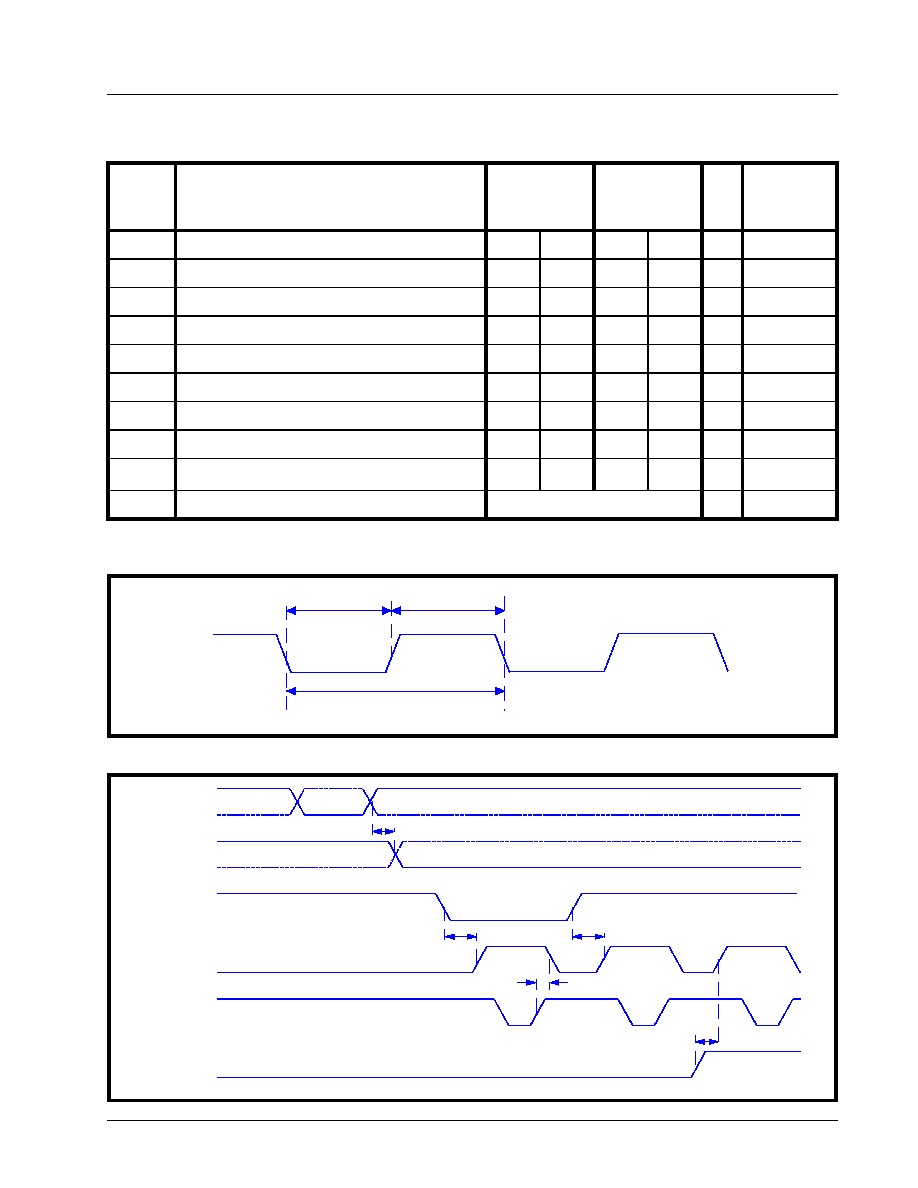
��
��
��
��
XR16C854/854D
REV. 3.0
2.97V TO 5.5V QUAD UART WITH 128-BYTE FIFO
43
TSI
Delay From Stop To Interrupt
45
40
ns
TINT
Delay From Initial INT Reset To Transmit Start
8
24
8
24
Bclk
TWRI
Delay From IOW# To Reset Interrupt
45
40
ns
TSSR
Delay From Stop To Set RXRDY#
1
1
Bclk
TRR
Delay From IOR# To Reset RXRDY#
45
40
ns
TWT
Delay From IOW# To Set TXRDY#
45
40
ns
TSRT
Delay From Center of Start To Reset TXRDY#
8
8
Bclk
TRST
Reset Pulse Width
40
40
ns
N
Baud Rate Divisor
1
2
16
-1
1
2
16
-1
-
Bclk
Baud Clock
16X of data rate
bps
F
IGURE
14. C
LOCK
T
IMING
F
IGURE
15. M
ODEM
I
NPUT
/O
UTPUT
T
IMING
F
OR
C
HANNELS
A-D
AC ELECTRICAL CHARACTERISTICS
TA=0
O
TO
70
O
C (-40
O
TO
+85
O
C
FOR
INDUSTRIAL
GRADE
PACKAGE
), V
CC
IS
2.97
TO
5.5V
S
YMBOL
P
ARAMETER
L
IMITS
3.3
M
IN
M
AX
L
IMITS
5.0
M
IN
M
AX
U
NIT
C
ONDITIONS
OSC
CLK
CLK
EXTERNAL
CLOCK
I O W #
I O W
R T S #
D T R #
C D #
C T S #
D S R #
I N T
I O R #
R I#
T
W D O
T
M O D
T
M O D
T
R S I
T
M O D
A c tiv e
A c tiv e
C h a n g e o f s t a t e
C h a n g e o f s t a t e
A c tiv e
A c tiv e
A c tiv e
C h a n g e o f s t a t e
C h a n g e o f s t a t e
C h a n g e o f s t a t e
A c tiv e
A c tiv e
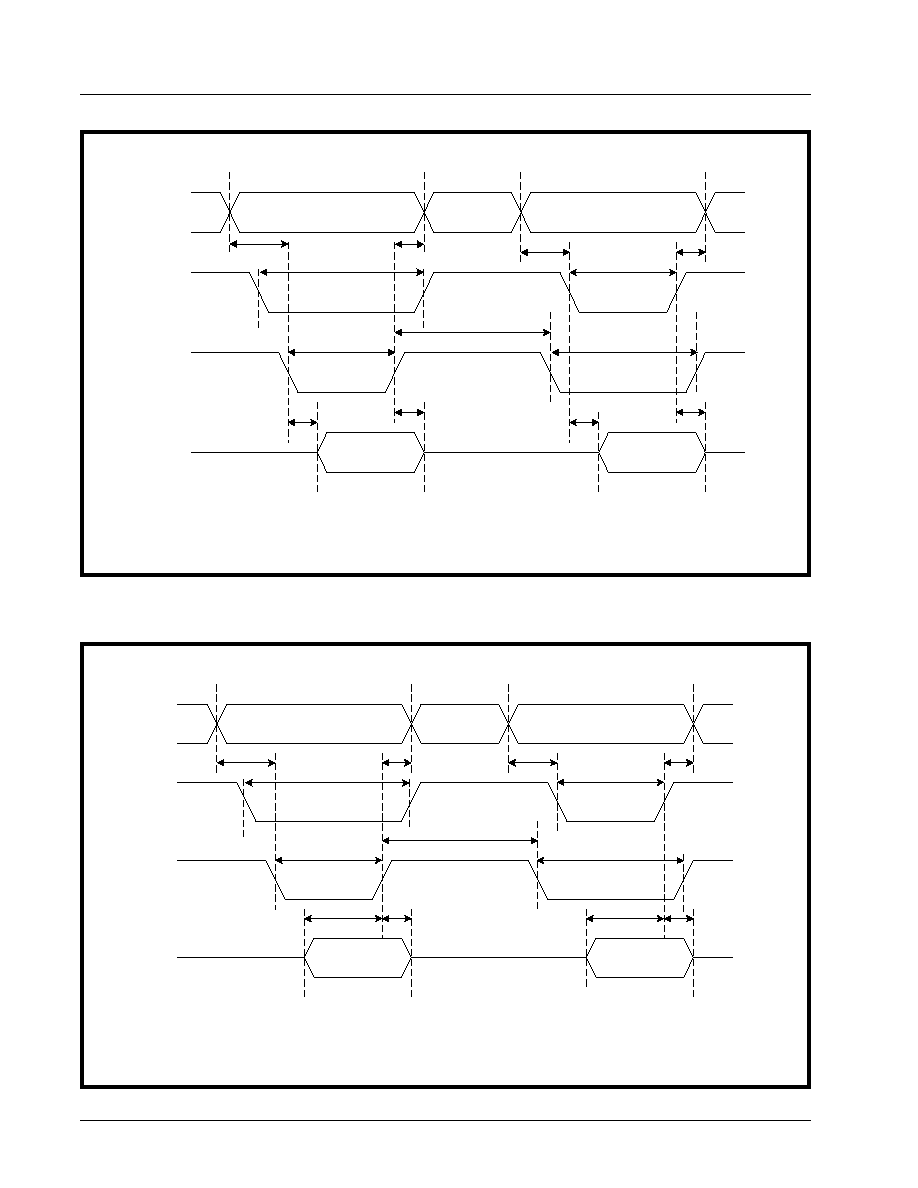
XR16C854/854D
��
��
��
��
2.97V TO 5.5V QUAD UART WITH 128-BYTE FIFO
REV. 3.0
44
F
IGURE
16. 16 M
ODE
(I
NTEL
) D
ATA
B
US
R
EAD
T
IMING
FOR
C
HANNELS
A-D
F
IGURE
17. 16 M
ODE
(I
NTEL
) D
ATA
B
US
W
RITE
T
IMING
FOR
C
HANNELS
A-D
T
AS
T
DD
T
AH
T
RD
T
RDV
T
DY
T
DD
T
RDV
T
AH
T
AS
T
CS
Valid Address
Valid Address
Valid Data
Valid Data
A0-A7
CS#
IOR#
D0-D7
RDTm
T
CS
T
RD
16Write
T
AS
T
DH
T
AH
T
WR
T
DS
T
DY
T
DH
T
DS
T
AH
T
AS
T
CS
Valid Address
Valid Address
Valid Data
Valid Data
A0-A7
CS#
IOW#
D0-D7
T
CS
T
WR
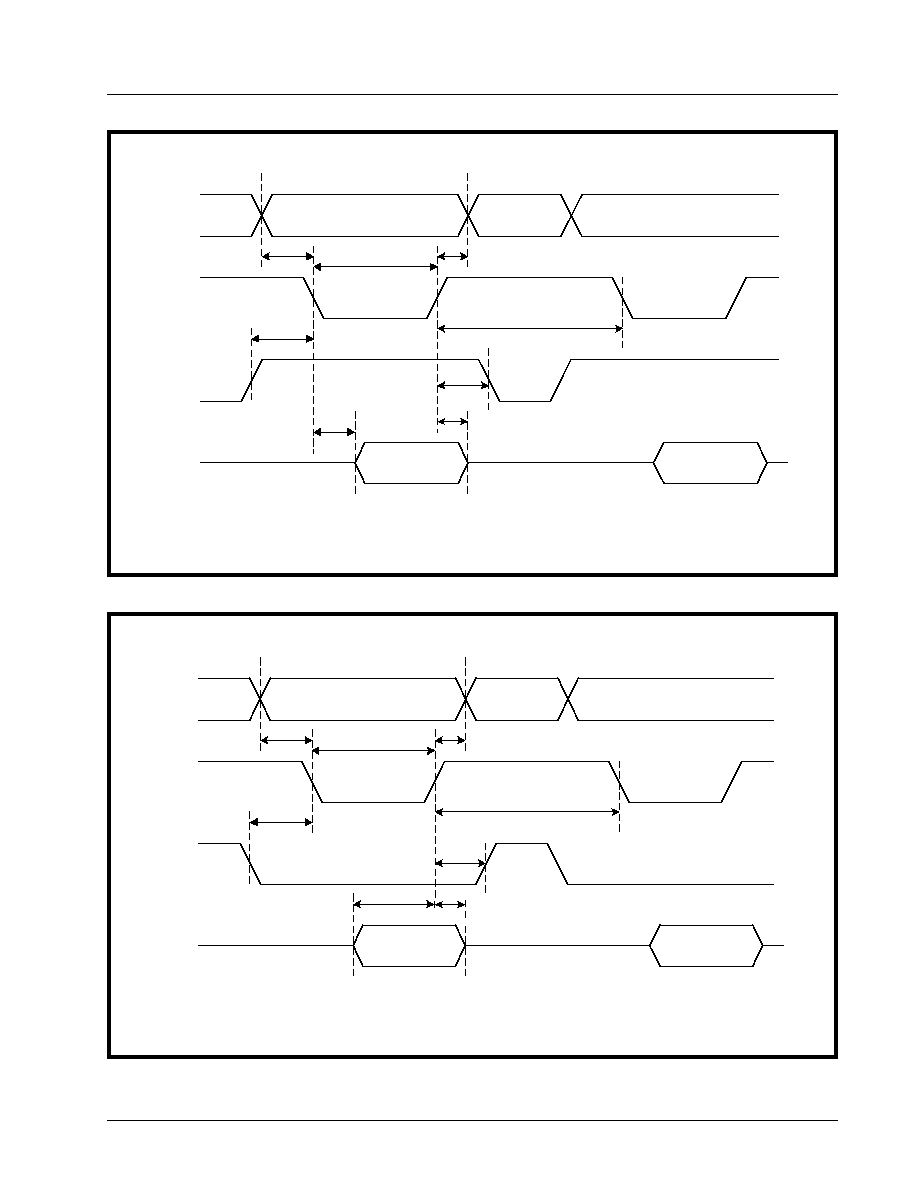
��
��
��
��
XR16C854/854D
REV. 3.0
2.97V TO 5.5V QUAD UART WITH 128-BYTE FIFO
45
F
IGURE
18. 68 M
ODE
(M
OTOROLA
) D
ATA
B
US
R
EAD
T
IMING
FOR
C
HANNELS
A-D
F
IGURE
19. 68 M
ODE
(M
OTOROLA
) D
ATA
B
US
W
RITE
T
IMING
FOR
C
HANNELS
A-D
68Read
T
ADS
T
RDH
T
ADH
T
CSL
T
RDA
T
CSD
T
RWS
Valid Address
Valid Address
Valid Data
A0-A7
CS#
R/W#
D0-D7
T
RWH
Valid Data
68Write
T
ADS
T
ADH
T
CSL
T
WDS
T
CSD
T
RWS
Valid Address
Valid Address
Valid Data
A0-A7
CS#
R/W#
D0-D7
T
RWH
Valid Data
T
WDH

XR16C854/854D
��
��
��
��
2.97V TO 5.5V QUAD UART WITH 128-BYTE FIFO
REV. 3.0
46
F
IGURE
20. R
ECEIVE
R
EADY
& I
NTERRUPT
T
IMING
[N
ON
-FIFO M
ODE
]
FOR
C
HANNELS
A-D
F
IGURE
21. T
RANSMIT
R
EADY
& I
NTERRUPT
T
IMING
[N
ON
-FIFO M
ODE
]
FOR
C
HANNELS
A-D
RX
RXRDY#
IOR#
INT
D0:D7
Start
Bit
D0:D7
Stop
Bit
D0:D7
T
SSR
1 Byte
in RHR
Active
Data
Ready
Active
Data
Ready
Active
Data
Ready
1 Byte
in RHR
1 Byte
in RHR
T
SSR
T
SSR
RXNFM
T
RR
T
RR
T
RR
T
SSR
T
SSR
T
SSR
(Reading data
out of RHR)
TX
TXRDY#
IOW#
INT*
D0:D7
Start
Bit
D0:D7
Stop
Bit
D0:D7
T
WT
TXNonFIFO
T
WT
T
WT
T
WRI
T
WRI
T
WRI
T
SRT
T
SRT
T
SRT
*INT is cleared when the ISR is read or when data is loaded into the THR.
ISR is read
ISR is read
ISR is read
(Loading data
into THR)
(Unloading)
IER[1]
enabled
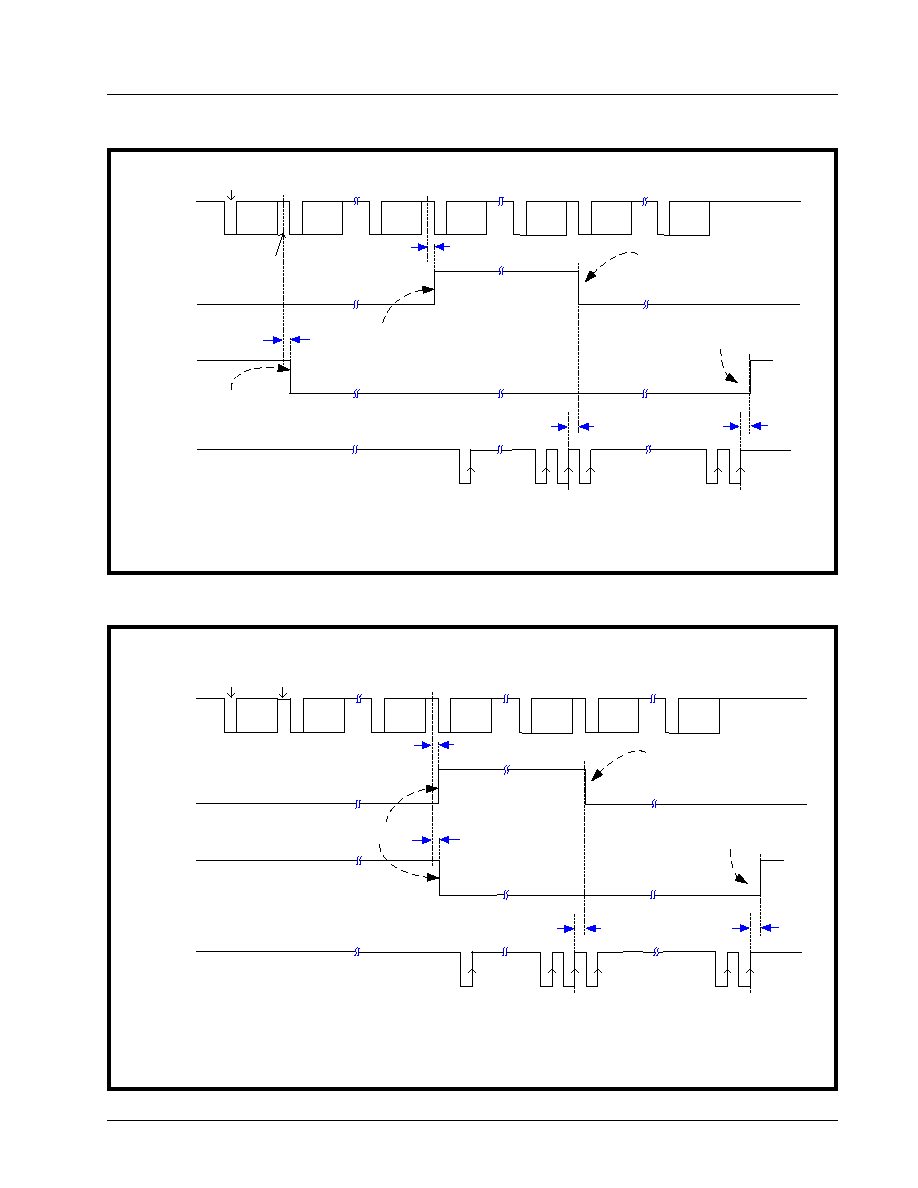
��
��
��
��
XR16C854/854D
REV. 3.0
2.97V TO 5.5V QUAD UART WITH 128-BYTE FIFO
47
F
IGURE
22. R
ECEIVE
R
EADY
& I
NTERRUPT
T
IMING
[FIFO M
ODE
, DMA D
ISABLED
]
FOR
C
HANNELS
A-D
F
IGURE
23. R
ECEIVE
R
EADY
& I
NTERRUPT
T
IMING
[FIFO M
ODE
, DMA E
NABLED
]
FOR
C
HANNELS
A-D
RX
RXRDY#
IOR#
INT
D0:D7
S
T
SSR
RXINTDMA#
RX FIFO fills up to RX
Trigger Level or RX Data
Timeout
RX FIFO drops
below RX
Trigger Level
FIFO
Empties
First Byte is
Received in
RX FIFO
D0:D7
S
D0:D7
T
D0:D7
S
D0:D7
S
T
D0:D7
S
T
T
D0:D7
S
T
Start
Bit
Stop
Bit
T
RR
T
RRI
T
SSI
(Reading data out
of RX FIFO)
RX
RXRDY#
IOR#
INT
D0:D7
S
T
SSR
RXFIFODMA
RX FIFO fills up to RX
Trigger Level or RX Data
Timeout
RX FIFO drops
below RX
Trigger Level
FIFO
Empties
D0:D7
S
D0:D7
T
D0:D7
S
D0:D7
S
T
D0:D7
S
T
T
D0:D7
S
T
Start
Bit
Stop
Bit
T
RR
T
RRI
T
SSI
(Reading data out
of RX FIFO)

XR16C854/854D
��
��
��
��
2.97V TO 5.5V QUAD UART WITH 128-BYTE FIFO
REV. 3.0
48
F
IGURE
24. T
RANSMIT
R
EADY
& I
NTERRUPT
T
IMING
[FIFO M
ODE
, DMA M
ODE
D
ISABLED
]
FOR
C
HANNELS
A-D
TX
TXRDY#
IOW#
INT*
TXDMA#
D0:D7
S
D0:D7
T
D0:D7
S
D0:D7
S
T
D0:D7
S
T
T
D0:D7
S
T
Start
Bit
Stop
Bit
T
WRI
(Unloading)
(Loading data
into FIFO)
Last Data Byte
Transmitted
TX FIFO fills up
to trigger level
TX FIFO drops
below trigger level
Data in
TX FIFO
TX FIFO
Empty
T
WT
T
SRT
TX FIFO
Empty
T
T
S
T
SI
ISR is read
IER[1]
enabled
ISR is read
*INT is cleared when the ISR is read or when TX FIFO fills up to the trigger level.

��
��
��
��
XR16C854/854D
REV. 3.0
2.97V TO 5.5V QUAD UART WITH 128-BYTE FIFO
49
PACKAGE DIMENSIONS
64 LEAD THIN QUAD FLAT PACK (10 x 10 x 1.4 mm TQFP)
Note: The control dimension is the millimeter column
INCHES
MILLIMETERS
SYMBOL
MIN
MAX
MIN
MAX
A
0.055
0.063
1.40
1.60
A1
0.002
0.006
0.05
0.15
A2
0.053
0.057
1.35
1.45
B
0.007
0.011
0.17
0.27
C
0.004
0.008
0.09
0.20
D
0.465
0.480
11.80
12.20
D1
0.390
0.398
9.90
10.10
e
0.020 BSC
0.50 BSC
L
0.018
0.030
0.45
0.75
0
�
7
�
0
�
7
�
48
33
32
17
1
16
49
64
D
D
1
D
D
1
B
e
A
2
A
1
A
S eating Plane
L
C
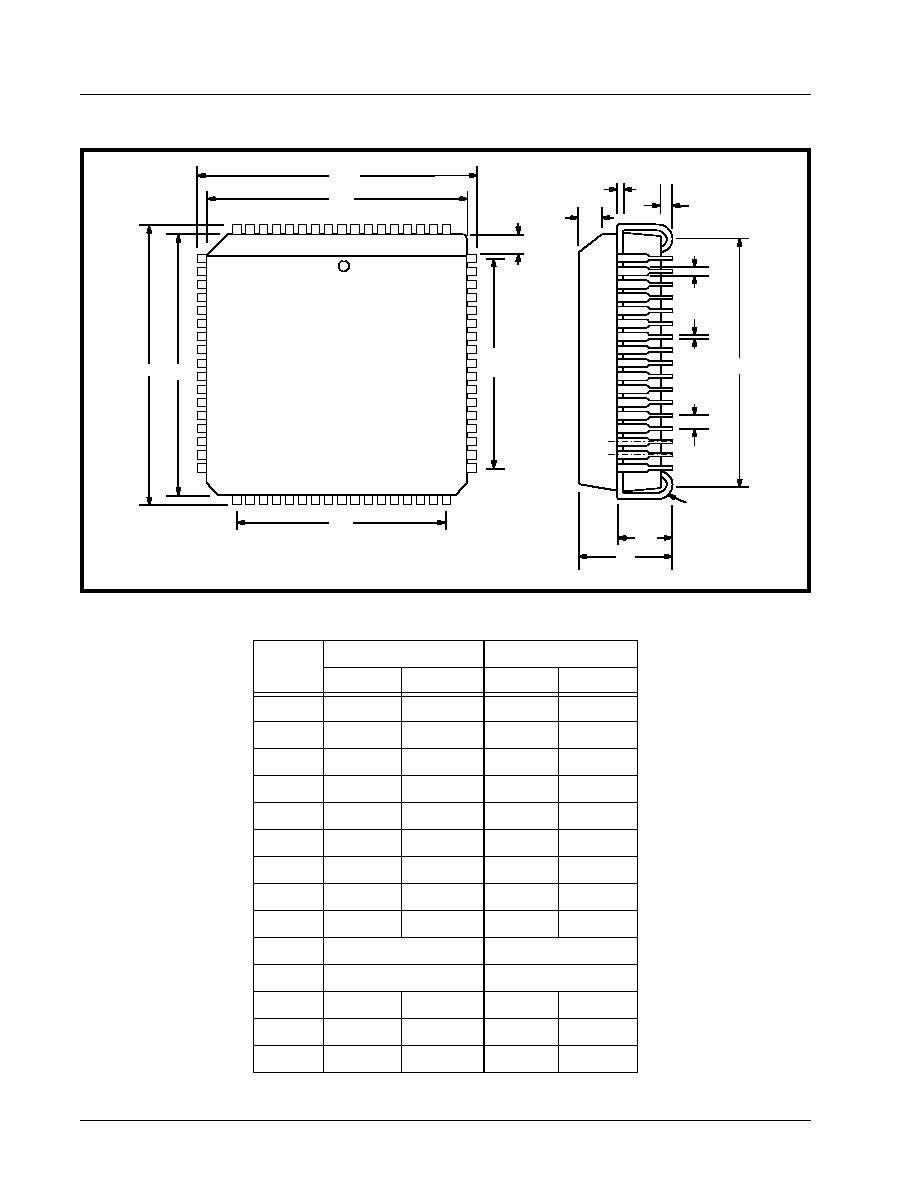
XR16C854/854D
��
��
��
��
2.97V TO 5.5V QUAD UART WITH 128-BYTE FIFO
REV. 3.0
50
68 LEAD PLASTIC LEADED CHIP CARRIER (PLCC)
Note: The control dimension is the inch column
INCHES
MILLIMETERS
SYMBOL
MIN
MAX
MIN
MAX
A
0.165
0.200
4.19
5.08
A1
0.090
0.130
2.29
3.30
A2
0.020
---.
0.51
---
B
0.013
0.021
0.33
0.53
B1
0.026
0.032
0.66
0.81
C
0.008
0.013
0.19
0.32
D
0.985
0.995
25.02
25.27
D1
0.950
0.958
24.13
24.33
D2
0.890
0.930
22.61
23.62
D3
0.800 typ.
20.32 typ.
e
0.050 BSC
1.27 BSC
H1
0.042
0.056
1.07
1.42
H2
0.042
0.048
1.07
1.22
R
0.025
0.045
0.64
1.14
1
D
D
1
D
D
1
D
3
D
2
A
A
1
2
68
B
A
2
B
1
e
Seating Plane
D
3
45
�
x H
2
45
�
x H
1
C
R

��
��
��
��
XR16C854/854D
REV. 3.0
2.97V TO 5.5V QUAD UART WITH 128-BYTE FIFO
51
100 LEAD PLASTIC QUAD FLAT PACK (14 mm x 20 mm QFP, 1.95 mm Form)
Note: The control dimension is the millimeter column
INCHES
MILLIMETERS
SYMBOL
MIN
MAX
MIN
MAX
A
0.102
0.134
2.60
3.40
A1
0.002
0.014
0.05
0.35
A2
0.100
0.120
2.55
3.05
B
0.009
0.015
0.22
0.38
C
0.004
0.009
0.11
0.23
D
0.931
0.951
23.65
24.15
D1
0.783
0.791
19.90
20.10
E
0.695
0.715
17.65
18.15
E1
0.547
0.555
13.90
14.10
e
0.0256 BSC
0.65 BSC
L
0.029
0.040
0.73
1.03
0
�
7
�
0
�
7
�
80
51
50
31
1
30
81
100
D
D
1
E
E
1
B
e
A
2
A
1
A
Seating Plane
L
C
p

XR16C854/854D
��
��
��
��
2.97V TO 5.5V QUAD UART WITH 128-BYTE FIFO
REV. 3.0
52
NOTICE
EXAR Corporation reserves the right to make changes to the products contained in this publication in order to
improve design, performance or reliability. EXAR Corporation assumes no responsibility for the use of any
circuits described herein, conveys no license under any patent or other right, and makes no representation that
the circuits are free of patent infringement. Charts and schedules contained here in are only for illustration
purposes and may vary depending upon a user's specific application. While the information in this publication
has been carefully checked; no responsibility, however, is assumed for inaccuracies.
EXAR Corporation does not recommend the use of any of its products in life support applications where the
failure or malfunction of the product can reasonably be expected to cause failure of the life support system or to
significantly affect its safety or effectiveness. Products are not authorized for use in such applications unless
EXAR Corporation receives, in writing, assurances to its satisfaction that: (a) the risk of injury or damage has
been minimized; (b) the user assumes all such risks; (c) potential liability of EXAR Corporation is adequately
protected under the circumstances.
Copyright 2004 EXAR Corporation
Datasheet January 2004.
Send your UART technical inquiry with technical details to hotline:
uarttechsupport@exar.com
.
Reproduction, in part or whole, without the prior written consent of EXAR Corporation is prohibited.
REVISION HISTORY
Date
Revision
Description
November 1999
Rev 1.0
Removed Preliminary designation.
February 2002
Rev 2.0
Changed to standard style format. Text descriptions were clarified and sim-
plified (eg. DMA operation, FIFO mode vs. Non-FIFO mode operations etc).
Corrected RTS Hysteresis character values in
Table 15
. Clarified timing dia-
grams. Renamed Rclk (Receive Clock) to Bclk (Baud Clock) and timing
symbols. Added T
CS
, T
RWS
and T
RST
.
May 2003
Rev 2.1
Added patent number and updated Block Diagram.
June 2003
Rev 2.2
Added and updated device status in Ordering Information.
January 2004
Rev 3.0
Changed to standard style format. Clarified sleep mode conditions. Devices
with top mark date code of "F2 YYWW" and newer have 5V tolerant inputs
(except for XTAL1). Devices with top mark date code of "DC YYWW" and
older do not have 5V tolerant inputs.

��
��
��
��
XR16C854/XR16C854D
3.3V AND 5V QUAD UART WITH 128-BYTE FIFO
REV. 2.0
I
TABLE OF CONTENTS
GENERAL DESCRIPTION................................................................................................. 1
F
EATURES
.................................................................................................................................................. 1
A
PPLICATIONS
............................................................................................................................................. 1
F
IGURE
1. XR16C854 B
LOCK
D
IAGRAM
.................................................................................................................................................. 1
F
IGURE
2. P
IN
O
UT
A
SSIGNMENT
F
OR
100-
PIN
QFP P
ACKAGES
I
N
16
AND
68 M
ODE
............................................................................... 2
F
IGURE
3. P
IN
O
UT
A
SSIGNMENT
F
OR
PLCC P
ACKAGES
I
N
16
AND
68 M
ODE
AND
TQFP P
ACKAGES
....................................................... 3
ORDERING
INFORMATION
............................................................................................................................. 3
PIN DESCRIPTIONS ......................................................................................................... 4
1.0 Product DESCRIPTION ........................................................................................................... 9
2.0 FUNCTIONAL DESCRIPTIONS ............................................................................................. 10
2.1 CPU I
NTERFACE
............................................................................................................................... 10
F
IGURE
4. XR16C854/854D T
YPICAL
I
NTEL
/M
OTOROLA
D
ATA
B
US
I
NTERCONNECTIONS
........................................................................ 10
2.2 5-V
OLT
T
OLERANT
I
NPUTS
................................................................................................................ 11
2.3 D
EVICE
R
ESET
.................................................................................................................................. 11
2.4 D
EVICE
I
DENTIFICATION
AND
R
EVISION
.............................................................................................. 11
2.5 C
HANNEL
S
ELECTION
........................................................................................................................ 11
T
ABLE
1: C
HANNEL
A-D S
ELECT
IN
16 M
ODE
........................................................................................................................................ 11
T
ABLE
2: C
HANNEL
A-D S
ELECT
IN
68 M
ODE
........................................................................................................................................ 11
2.6 C
HANNELS
A-D I
NTERNAL
R
EGISTERS
............................................................................................... 12
2.7 INT O
UPUTS
FOR
C
HANNELS
A-D ..................................................................................................... 12
2.8 DMA M
ODE
...................................................................................................................................... 12
T
ABLE
3: INT P
INS
O
PERATION
FOR
T
RANSMITTER
FOR
C
HANNELS
A-D................................................................................................. 12
T
ABLE
4: INT P
IN
O
PERATION
FOR
R
ECEIVER
FOR
C
HANNELS
A-D ........................................................................................................ 12
2.9 C
RYSTAL
O
SCILLATOR
OR
E
XTERNAL
C
LOCK
I
NPUT
........................................................................... 13
F
IGURE
5. T
YPICAL
OSCILATOR
CONNECTIONSL
...................................................................................................................................... 13
2.10 P
ROGRAMMABLE
B
AUD
R
ATE
G
ENERATOR
....................................................................................... 13
T
ABLE
5: TXRDY#
AND
RXRDY# O
UTPUTS
IN
FIFO
AND
DMA M
ODE
FOR
C
HANNELS
A-D................................................................... 13
2.11 T
RANSMITTER
................................................................................................................................. 14
2.11.1 Transmit Holding Register (THR) - Write Only ....................................................................................... 14
2.11.2 Transmitter Operation in non-FIFO Mode .............................................................................................. 14
F
IGURE
6. B
AUD
R
ATE
G
ENERATOR
AND
P
RESCALER
............................................................................................................................ 14
T
ABLE
6: T
YPICAL
DATA
RATES
WITH
A
14.7456 MH
Z
CRYSTAL
OR
EXTERNAL
CLOCK
.............................................................................. 14
2.11.3 Transmitter Operation in FIFO Mode ..................................................................................................... 15
2.12 R
ECEIVER
....................................................................................................................................... 15
F
IGURE
7. T
RANSMITTER
O
PERATION
IN
NON
-FIFO M
ODE
...................................................................................................................... 15
F
IGURE
8. T
RANSMITTER
O
PERATION
IN
FIFO
AND
F
LOW
C
ONTROL
M
ODE
............................................................................................. 15
2.12.1 Receive Holding Register (RHR) - Read-Only ....................................................................................... 16
F
IGURE
9. R
ECEIVER
O
PERATION
IN
NON
-FIFO M
ODE
........................................................................................................................... 16
F
IGURE
10. R
ECEIVER
O
PERATION
IN
FIFO
AND
A
UTO
RTS F
LOW
C
ONTROL
M
ODE
............................................................................... 16
2.13 A
UTO
RTS H
ARDWARE
F
LOW
C
ONTROL
.......................................................................................... 17
2.14 A
UTO
RTS H
YSTERESIS
................................................................................................................. 17
2.15 A
UTO
CTS F
LOW
C
ONTROL
........................................................................................................... 17
F
IGURE
11. A
UTO
RTS
AND
CTS F
LOW
C
ONTROL
O
PERATION
.............................................................................................................. 18
2.16 A
UTO
X
ON
/X
OFF
(S
OFTWARE
) F
LOW
C
ONTROL
............................................................................... 19
2.17 S
PECIAL
C
HARACTER
D
ETECT
........................................................................................................ 19
2.18 I
NFRARED
M
ODE
............................................................................................................................. 19
T
ABLE
7: A
UTO
X
ON
/X
OFF
(S
OFTWARE
) F
LOW
C
ONTROL
....................................................................................................................... 19
2.19 S
LEEP
M
ODE
WITH
A
UTO
W
AKE
-U
P
............................................................................................... 20
F
IGURE
12. I
NFRARED
T
RANSMIT
D
ATA
E
NCODING
AND
R
ECEIVE
D
ATA
D
ECODING
................................................................................. 20
2.20 I
NTERNAL
L
OOPBACK
..................................................................................................................... 21
F
IGURE
13. I
NTERNAL
L
OOP
B
ACK
IN
C
HANNELS
A-D............................................................................................................................. 22
3.0 UART INTERNAL REGISTERS ............................................................................................. 23
T
ABLE
8: UART CHANNEL A AND B UART INTERNAL REGISTERS ............................................................................................. 23
T
ABLE
9: INTERNAL REGISTERS DESCRIPTION. S
HADED
BITS
ARE
ENABLED
WHEN
EFR B
IT
-4=1 ................................................ 24
4.0 INTERNAL Register descriptions ........................................................................................ 26
4.1 R
ECEIVE
H
OLDING
R
EGISTER
(RHR) - R
EAD
- O
NLY
........................................................................... 26

XR16C854/XR16C854D
��
��
��
��
3.3V AND 5V QUAD UART WITH 128-BYTE FIFO
REV. 2.0
II
4.2 T
RANSMIT
H
OLDING
R
EGISTER
(THR) - W
RITE
-O
NLY
......................................................................... 26
4.3 I
NTERRUPT
E
NABLE
R
EGISTER
(IER) - R
EAD
/W
RITE
........................................................................... 26
4.3.1 IER versus Receive FIFO Interrupt Mode Operation................................................................................ 26
4.3.2 IER versus Receive/Transmit FIFO Polled Mode Operation .................................................................... 26
4.4 I
NTERRUPT
S
TATUS
R
EGISTER
(ISR) - R
EAD
-O
NLY
............................................................................ 27
4.4.1 Interrupt Generation: ................................................................................................................................ 27
4.4.2 Interrupt Clearing:..................................................................................................................................... 27
4.5 FIFO C
ONTROL
R
EGISTER
(FCR) - W
RITE
-O
NLY
............................................................................... 28
T
ABLE
10: I
NTERRUPT
S
OURCE
AND
P
RIORITY
L
EVEL
............................................................................................................................. 28
T
ABLE
11: T
RANSMIT
AND
R
ECEIVE
FIFO T
RIGGER
L
EVEL
S
ELECTION
.................................................................................................... 29
4.6 L
INE
C
ONTROL
R
EGISTER
(LCR) - R
EAD
/W
RITE
................................................................................. 30
T
ABLE
12: P
ARITY
SELECTION
................................................................................................................................................................ 31
4.7 M
ODEM
C
ONTROL
R
EGISTER
(MCR)
OR
G
ENERAL
P
URPOSE
O
UTPUTS
C
ONTROL
- R
EAD
/W
RITE
........ 32
T
ABLE
13: INT O
UTPUT
M
ODES
............................................................................................................................................................ 32
4.8 L
INE
S
TATUS
R
EGISTER
(LSR) - R
EAD
O
NLY
..................................................................................... 33
4.9 M
ODEM
S
TATUS
R
EGISTER
(MSR) - R
EAD
O
NLY
............................................................................... 34
4.10 S
CRATCH
P
AD
R
EGISTER
(SPR) - R
EAD
/W
RITE
............................................................................... 35
4.11 E
NHANCED
M
ODE
S
ELECT
R
EGISTER
(EMSR) ................................................................................. 35
T
ABLE
14: S
CRATCHPAD
S
WAP
S
ELECTION
............................................................................................................................................ 35
T
ABLE
15: A
UTO
RTS H
YSTERESIS
...................................................................................................................................................... 36
4.12 FIFO L
EVEL
R
EGISTER
(FLVL) - R
EAD
-O
NLY
................................................................................... 36
4.13 B
AUD
R
ATE
G
ENERATOR
R
EGISTERS
(DLL
AND
DLM) - R
EAD
/W
RITE
............................................... 36
4.14 D
EVICE
I
DENTIFICATION
R
EGISTER
(DVID) - R
EAD
O
NLY
.................................................................. 36
4.15 D
EVICE
R
EVISION
R
EGISTER
(DREV) - R
EAD
O
NLY
......................................................................... 36
4.16 T
RIGGER
L
EVEL
(TRG) - W
RITE
-O
NLY
............................................................................................. 36
4.17 FIFO D
ATA
C
OUNT
R
EGISTER
(FC) - R
EAD
-O
NLY
............................................................................ 37
4.18 F
EATURE
C
ONTROL
R
EGISTER
(FCTR) - R
EAD
/W
RITE
.................................................................... 37
4.19 E
NHANCED
F
EATURE
R
EGISTER
(EFR) - R
EAD
/W
RITE
...................................................................... 37
T
ABLE
16: T
RIGGER
T
ABLE
S
ELECT
....................................................................................................................................................... 37
T
ABLE
17: S
OFTWARE
F
LOW
C
ONTROL
F
UNCTIONS
............................................................................................................................... 38
4.20 S
OFTWARE
F
LOW
C
ONTROL
R
EGISTERS
(XOFF1, XOFF2, XON1, XON2) - R
EAD
/W
RITE
............... 39
4.21 FIFO S
TATUS
R
EGISTER
(FSTAT) - R
EAD
/W
RITE
............................................................................ 39
T
ABLE
18: UART RESET CONDITIONS FOR CHANNELS A-D ......................................................................................................... 40
ELECTRICAL CHARACTERISTICS ................................................................................41
A
BSOLUTE
M
AXIMUM
R
ATINGS
...................................................................................................................41
T
YPICAL
P
ACKAGE
T
HERMAL
R
ESISTANCE
D
ATA
(M
ARGIN
OF
E
RROR
: = 15%)............................................41
DC E
LECTRICAL
C
HARACTERISTICS
...........................................................................................................41
TA=0o to 70oC (-40o to +85oC for industrial grade package), Vcc is 2.97 to 5.5V........................................... 41
AC E
LECTRICAL
C
HARACTERISTICS
............................................................................................................42
TA=0
O
TO
70
O
C (-40
O
TO
+85
O
C
FOR
INDUSTRIAL
GRADE
PACKAGE
), V
CC
IS
2.97
TO
5.5V ......................42
F
IGURE
14. C
LOCK
T
IMING
.................................................................................................................................................................... 43
F
IGURE
15. M
ODEM
I
NPUT
/O
UTPUT
T
IMING
F
OR
C
HANNELS
A-D............................................................................................................ 43
F
IGURE
16. 16 M
ODE
(I
NTEL
) D
ATA
B
US
R
EAD
T
IMING
FOR
C
HANNELS
A-D ........................................................................................... 44
F
IGURE
17. 16 M
ODE
(I
NTEL
) D
ATA
B
US
W
RITE
T
IMING
FOR
C
HANNELS
A-D.......................................................................................... 44
F
IGURE
18. 68 M
ODE
(M
OTOROLA
) D
ATA
B
US
R
EAD
T
IMING
FOR
C
HANNELS
A-D .................................................................................. 45
F
IGURE
19. 68 M
ODE
(M
OTOROLA
) D
ATA
B
US
W
RITE
T
IMING
FOR
C
HANNELS
A-D ................................................................................. 45
F
IGURE
20. R
ECEIVE
R
EADY
& I
NTERRUPT
T
IMING
[N
ON
-FIFO M
ODE
]
FOR
C
HANNELS
A-D .................................................................... 46
F
IGURE
21. T
RANSMIT
R
EADY
& I
NTERRUPT
T
IMING
[N
ON
-FIFO M
ODE
]
FOR
C
HANNELS
A-D .................................................................. 46
F
IGURE
22. R
ECEIVE
R
EADY
& I
NTERRUPT
T
IMING
[FIFO M
ODE
, DMA D
ISABLED
]
FOR
C
HANNELS
A-D .................................................. 47
F
IGURE
23. R
ECEIVE
R
EADY
& I
NTERRUPT
T
IMING
[FIFO M
ODE
, DMA E
NABLED
]
FOR
C
HANNELS
A-D ................................................... 47
F
IGURE
24. T
RANSMIT
R
EADY
& I
NTERRUPT
T
IMING
[FIFO M
ODE
, DMA M
ODE
D
ISABLED
]
FOR
C
HANNELS
A-D ...................................... 48
P
ACKAGE
D
IMENSIONS
..............................................................................................................................49
R
EVISION
H
ISTORY
....................................................................................................................................52
TABLE OF CONTENTS ................................................................................................................................. I





















































